Hawaiian Punch
Steel String Martin Hawaiian Guitars
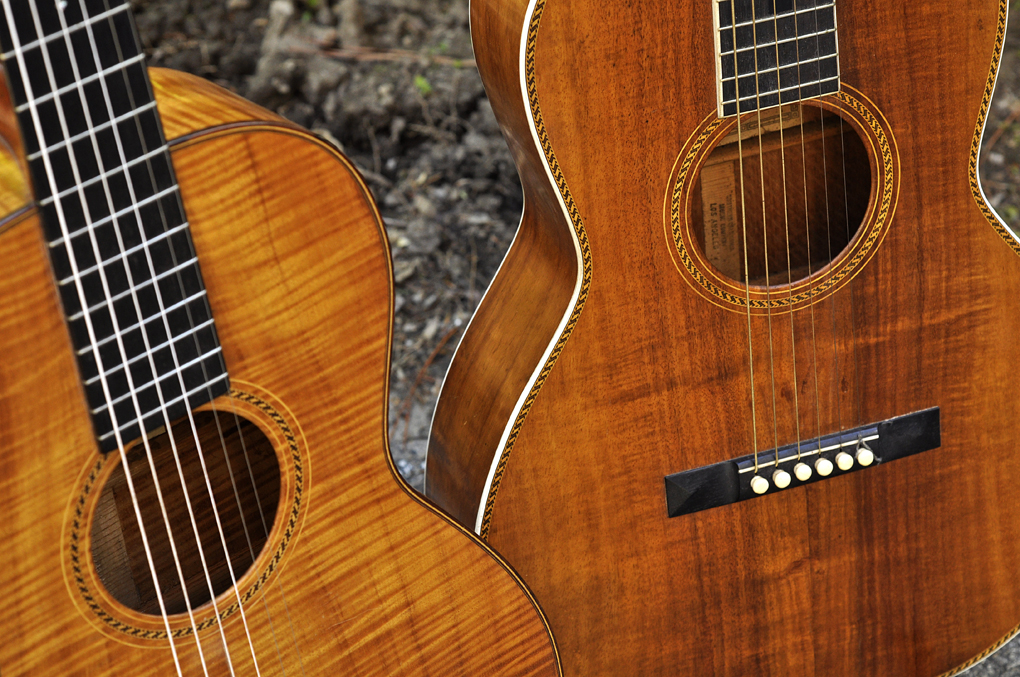
In July of 1916, with Hawaiian music all the rage following it's introduction to a large portion of the American public at the Panama Pacific Exposition in Chicago the previous year, the C. F. Martin Co. shipped six samples each of Hawaiian koa wood guitars with appointments generally similar to Martin's styles 0-18, 0-21, and 00-28 to the Southern California Music Company of Los Angeles, a chain of Southern California music stores, and one of Martin's largest accounts.
SoCal provided Martin with the koa wood from Hawaii, and asked that the trim on these guitars, designed for playing in the Hawaiian style, be as close as possible to those of SoCal's popular ukuleles.
To appeal to the Hawaiian market, SoCal asked that the Martin stamp be replaced with the Southern California Music Company stamp, and affixed decals on the headstocks bearing the name "M. Nunes & Sons, Hawaii" and labels inside with either the name "M. Nunes & Sons" or "Rolando". These early samples had koa wood back and sides and tinted spruce tops, but after seeing the samples, SoCal decided to offer all koa guitars, and to market the three models as the 1350, 1400, and 1500. The first of the new SoCal models was shipped in November of 1916.
These guitars, and those Hawaiian guitars designed at about the same time for the Oliver Ditson Company, were the first Martins to be built for steel strings. And while Martin had previously used fan bracing only for their gut string guitars in the Spanish Style, and had since switched it's production to X-bracing, Martin curiously decided to build these early heavier steel string guitars with braces in the shape of a fan. The Model 1500, however, for reasons we may never know, has X bracing.
"M. Nunes & Sons" and "Rolando" Models 1350, 1400 and 1500
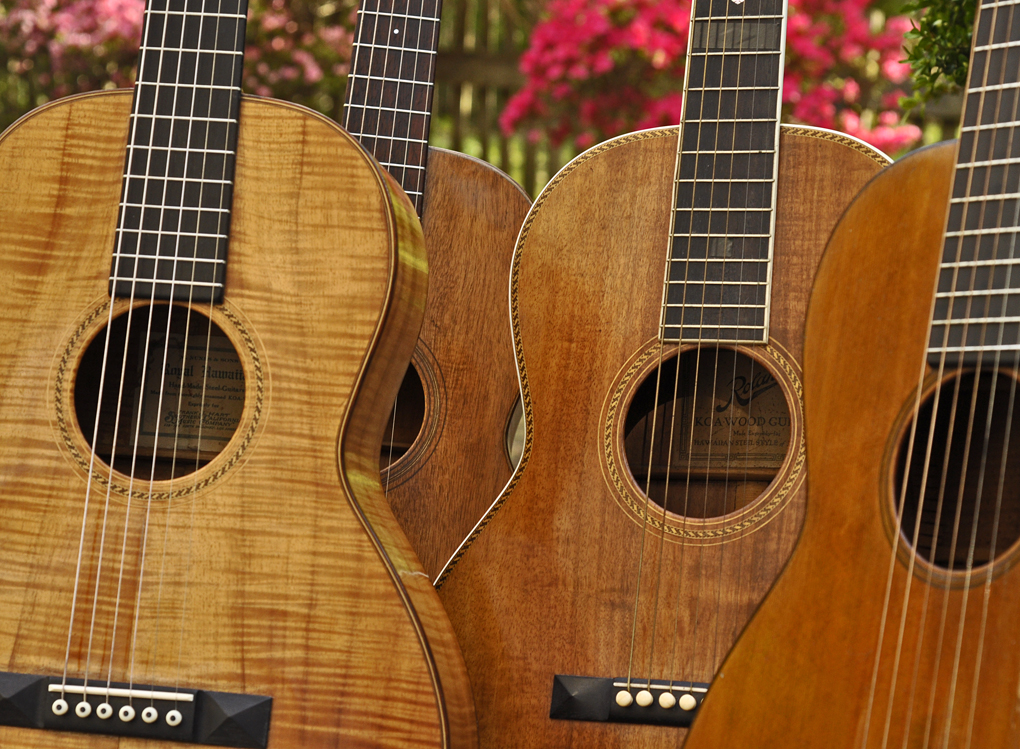
1916 Model 1400 #28, 1919 Model 1350 #14001, 1917 Model 1500 #181, and 1916 Spruce Top Sample with no serial number
The guitars designed for SoCal had serial numbers of their own. The Model 1400 shown below, from the very first batch, is number 28. The numbered guitars started with number 19, allowing for the eighteen samples which were sent without serial numbers.
A total of 261 guitars were produced with SoCal serial numbers.
By June, 1918, instruments made for Southern California Music had standard Martin serial numbers.
The later Southern California Music Company Hawaiians have trim similar to a regular Martin, and Martin serial numbers. While earlier SoCals generally bear the Southern California Music Company name on the headstock, later examples have either both the SoCal and Martin names or the Martin name only.
The early Model 1350 and 1500 examples I've seen have the "Rolando Koa Wood Guitars" label, while the sample 1350 and early 1400 have the "M. Nunes & Sons, Royal Hawaiians" label inside. The later examples have the Martin stamp inside.
These "Hawaiian" Martins, from the time they were first made in the teens, were catalogued with "steel strings and nut adjuster for Hawaiian playing. Suitable for regular playing with nut adjuster removed." Only beginning in 1925 were these guitars made specifically for Hawaiian playing, with high nuts and flush frets. While the early "K" models, such as the 0-18K and 0-28K, began life with regular frets and nut adjusters, the "H" models, including the 00-18H and 00-40-H, were introduced after the change to flush frets and high strings.
C.F. Martin/Southern California Music Company Sample Model 1350
This guitar is one of the six original samples with spruce tops which were requested of Martin by the Southern California Music Company, in a style similar to the Martin 0-18 but suited for playing in the Hawaiian style, with steel strings and fan bracing, similar to the Hawaiian guitars first shipped 3 1/2 months earlier to the Ditson Company.
The sample Nunes also has the same single ring rosette seen on Ditsons and guitars made by Martin for several other firms, and a tinted spruce top similar to those seen on many Ditsons.
No serial number.
These samples have no serial number, while the regular production appears to begin with serial number 19, accounting for the six samples of each model.
Shipped July 10, 1916
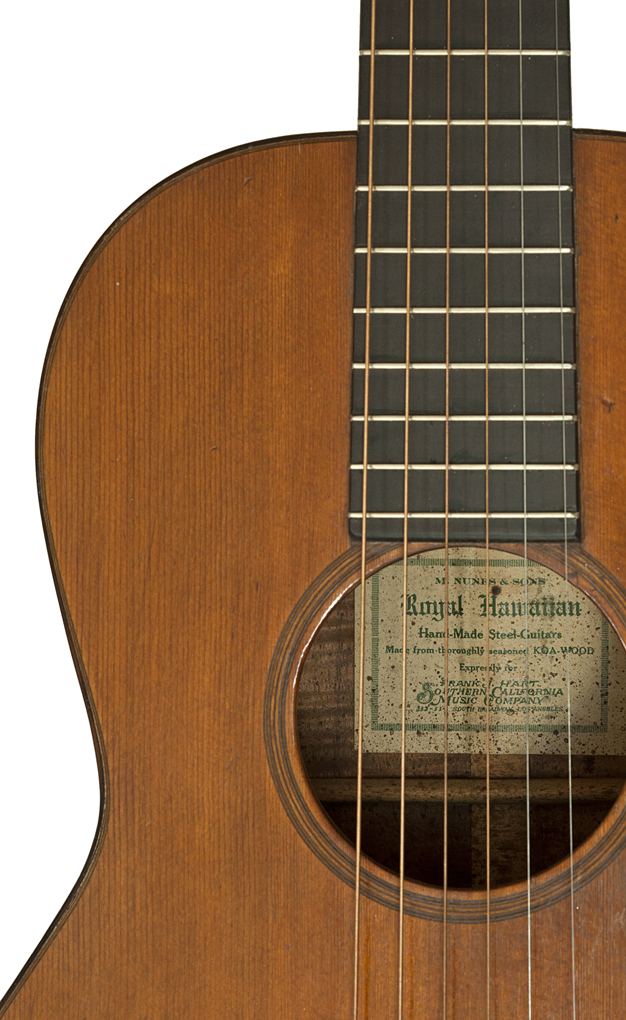
These early guitars were made with Koa wood supplied by SoCal.
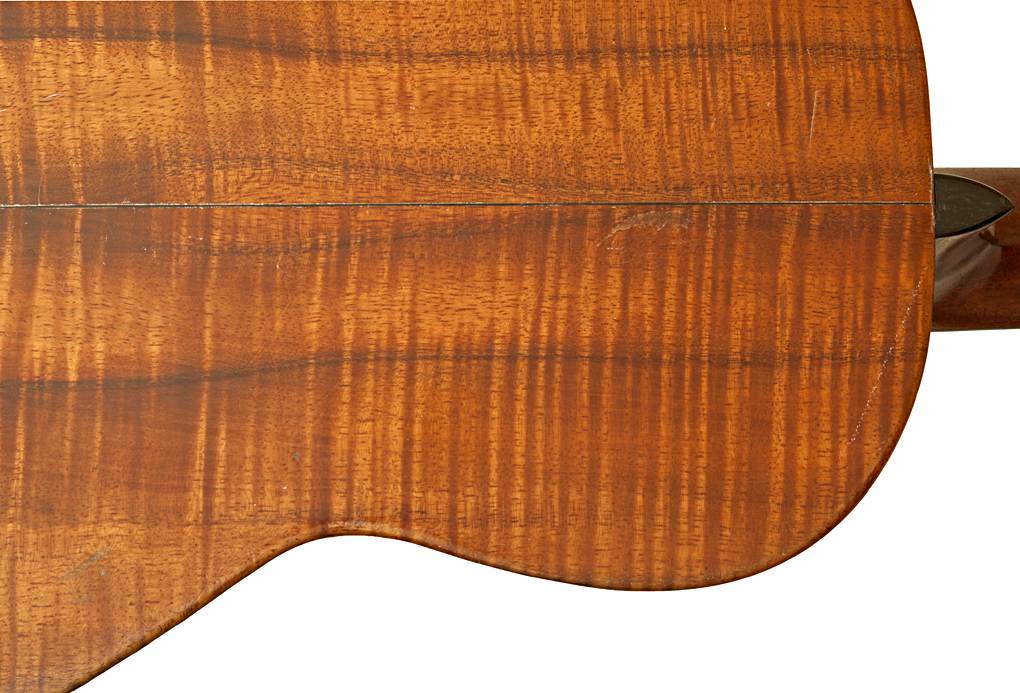
This sample instrument has the "M. Nunes, Hawaii" decal on the headstock of the guitar.
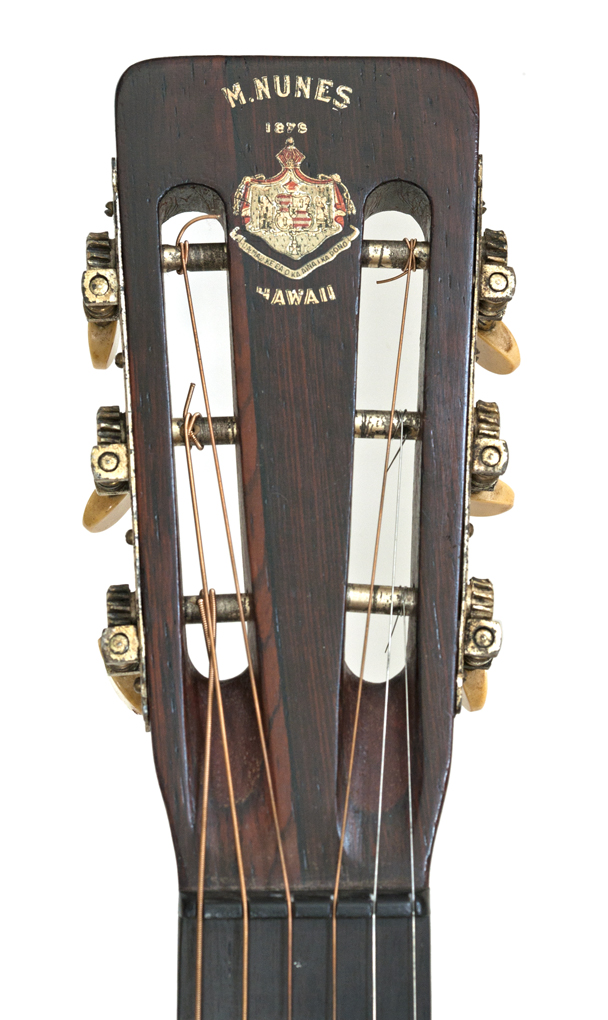
This sample has neither the Southern California nor the Martin stamp on the back of the headstock, however. There is neither a Martin nor SoCal stamp on the back strip inside the guitar.
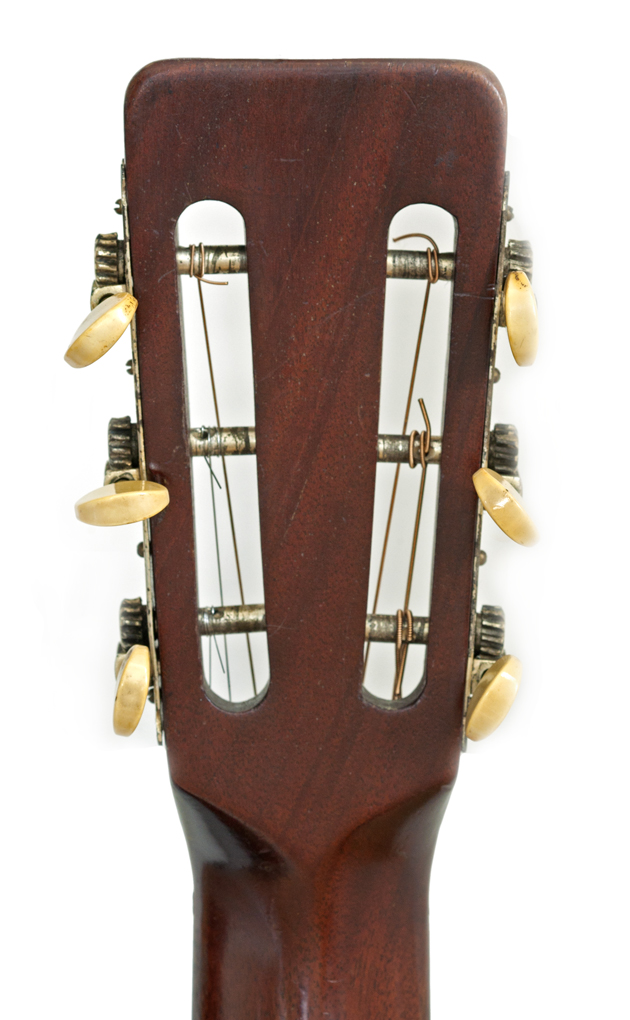
C.F. Martin/Southern California Music Company Model 1350
1916 Southern California Music Company Model 1350
Fan style braces similar to a Ditson dreadnaught.
Stamped inside, "C.F. Martin & Co., Nazareth, PA"
Stamped on back of headstock "Southern California Music Company, Los Angeles"
Early examples have the "Rolando" label
Both the initial samples for the Model 1350 and the earlier 1350 with the Rolando label have a single ring rosette like many of the guitars Martin made for others such as Ditson, Wurlitzer, and Foden, but the later examples with Martin serial numbers have a standard Martin three ring rosette.
138 of the Style 1350 were produced with SoCal serial numbers.
Rolando 1350
SoCal serial number 95
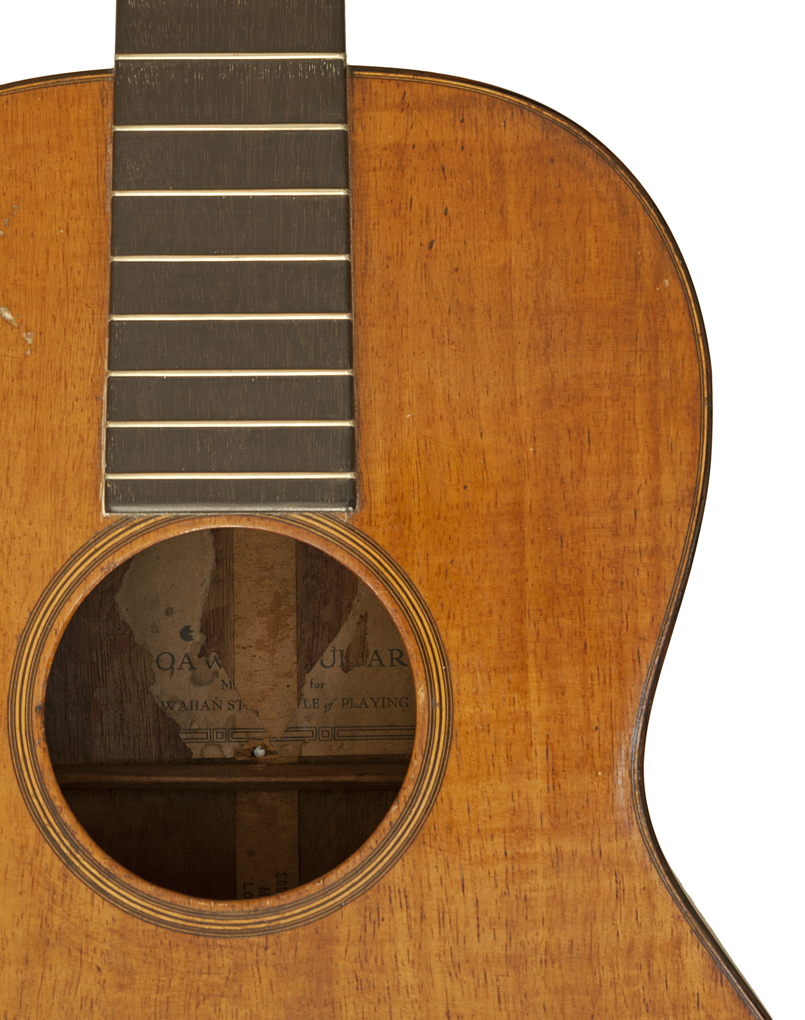
This early example has a Rolando label and a Hawaiian decal on the headstock without the Nunes name.
The new edition of the Longworth book (in a section to which I otherwise contributed) states that "The Rolando label was used on later Style 18K and 28K models made for Southern California Music Company. Unlike earlier koa models made for this firm, those with the Rolando label are identical to Martins and have the Martin stamp on the interior with regular serial numbers." This example as well as the early Style 1500 shown below illustrate that the Rolando label appeared quite a bit earlier than previously thought.
I first thought that the different labels related to the different styles. I now see that the early sample Style 1350 and Style 1400 number 28 have the "Nunes" label while Style 1350 number 95 and Style 1500 number 181 have the "Rolando" label, so it is entirely possible that the label was replaced sometime between the production of numbers 28 and 95.
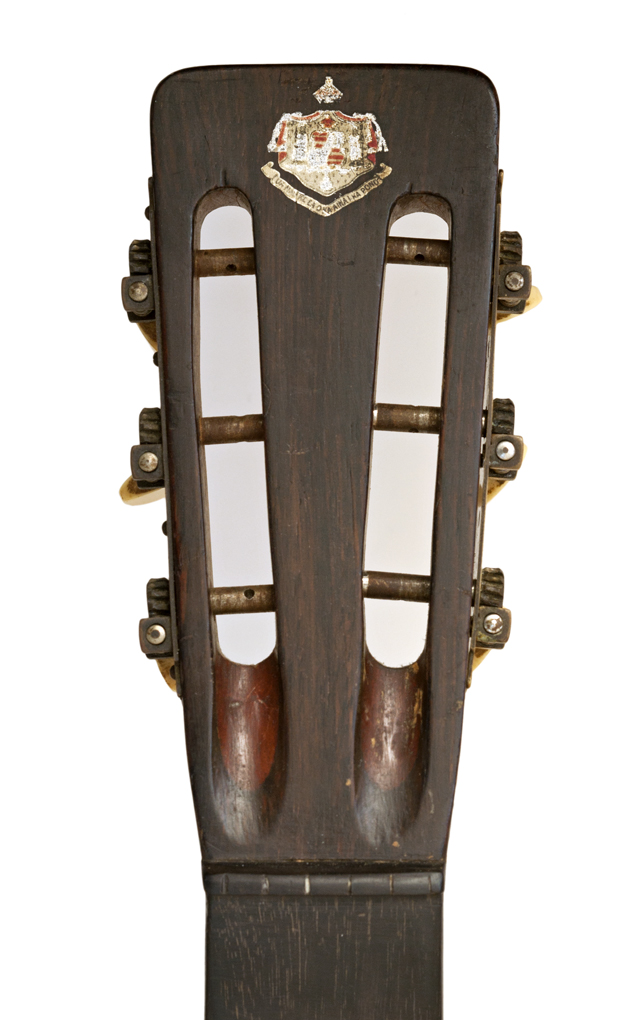
This example has a Martin headstock stamp.
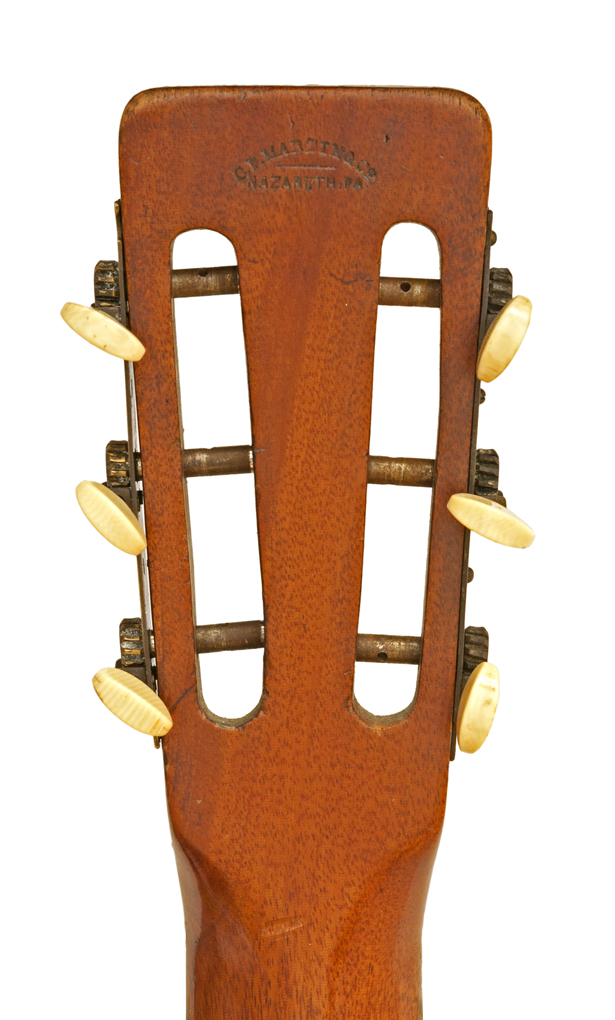
C.F. Martin/Southern California Music Company Model 1350
1919 Southern California Music Company Model 1350
Fan style braces similar to a Ditson dreadnaught.
Stamped inside, "C.F. Martin & Co., Nazareth, PA"
Stamped on back of headstock "Southern California Music Company, Los Angeles"
Both the initial samples for the Model 1350 and the earlier 1350 with the Rolando label have a single ring rosette like some of the guitars Martin made for others such as Ditson, Wurlitzer, and Foden, but the later examples with Martin serial numbers have a standard Martin three ring rosette.
Serial numbers 14001 and 14003.
#14001
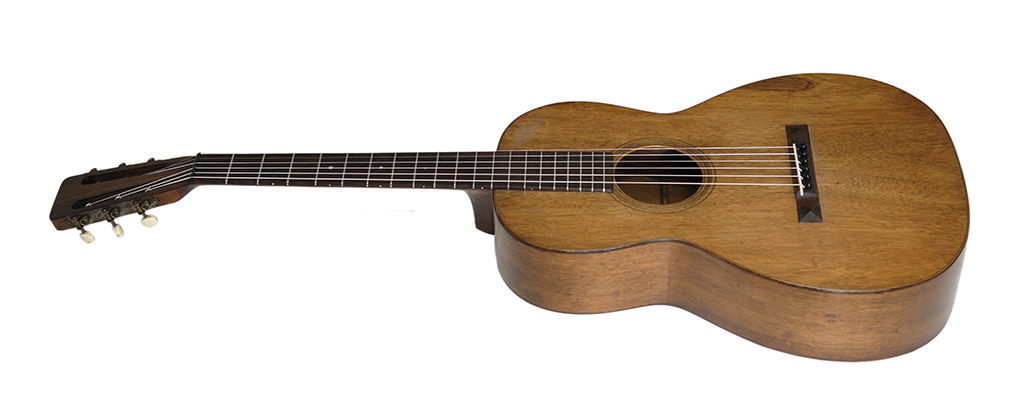
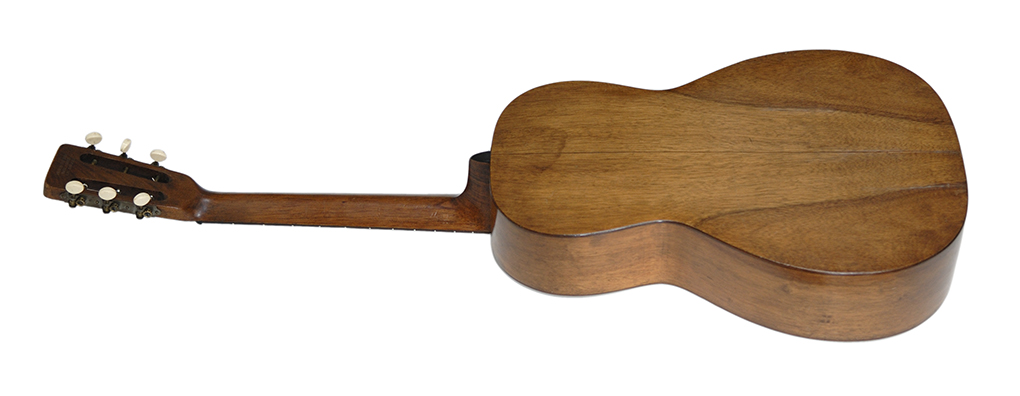
#14003


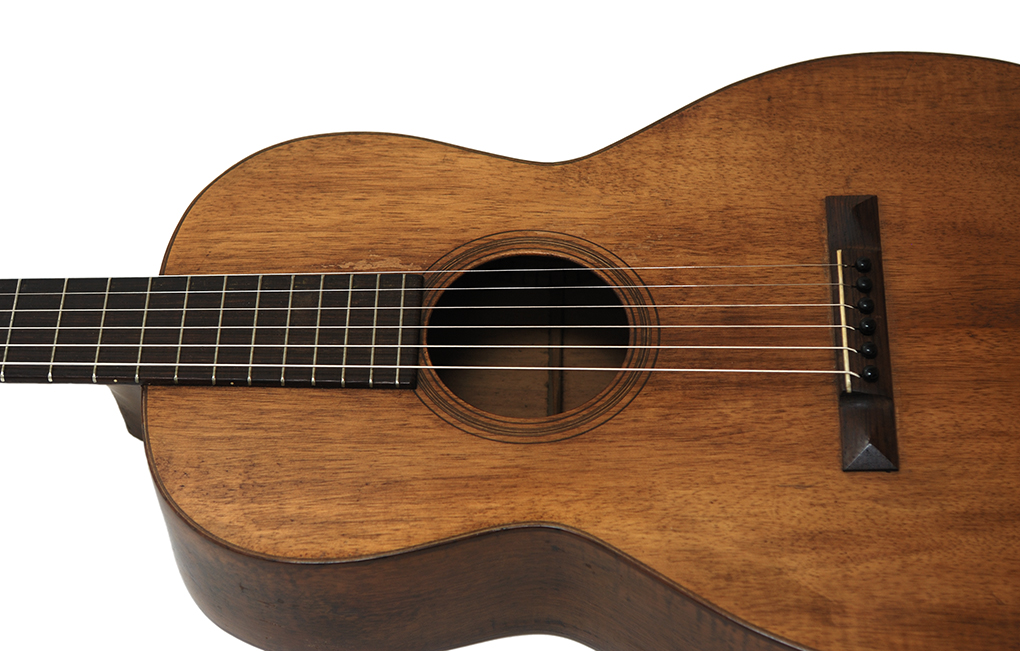
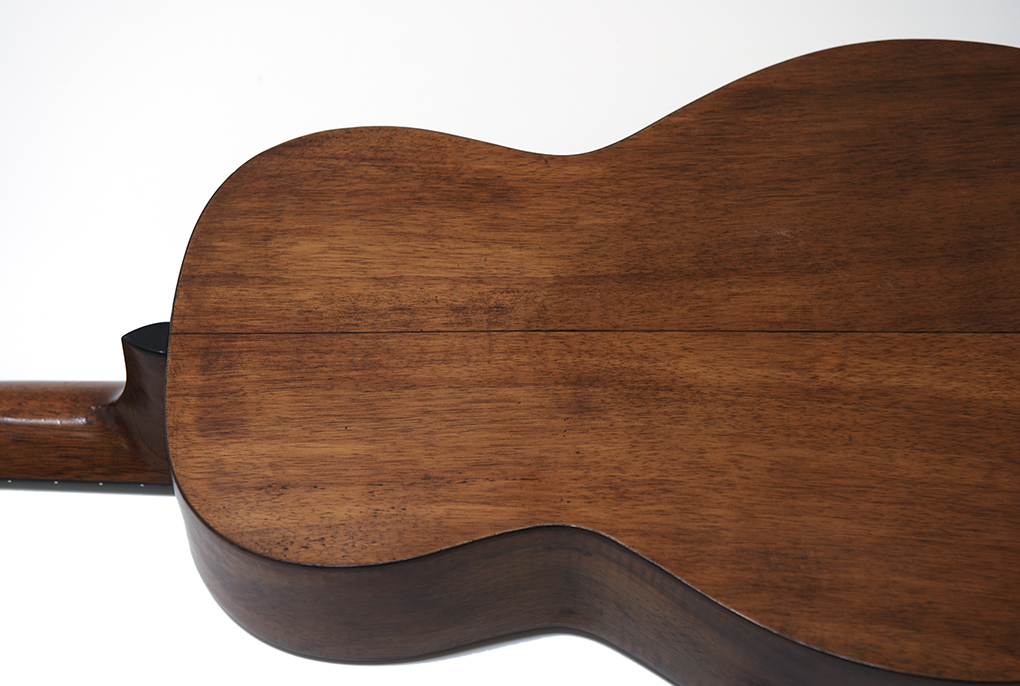

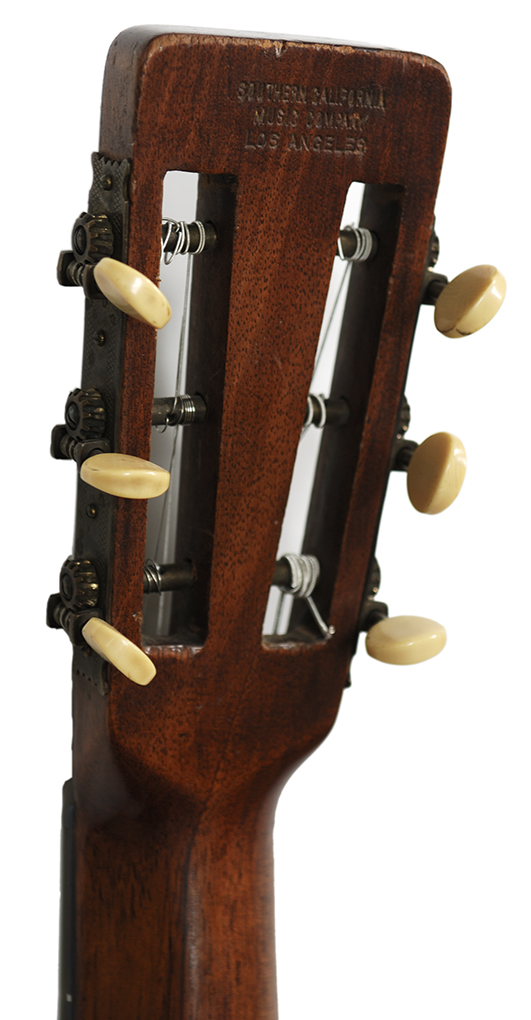
In 1919, Martin began selling their less expensive guitars with rounded slots in the headstock. Previously, all Martins had square slots, a process that took extra time which was in short supply as as Martin's production was doubling yearly. Curiously, these two guitars, two serial numbers away and both from the same batch, have different style headstocks, which is not surprising if you follow Martin history. No doubt, the necks were made first, and different styles appeared when the worker reached into the pile when it came time to attach a neck.
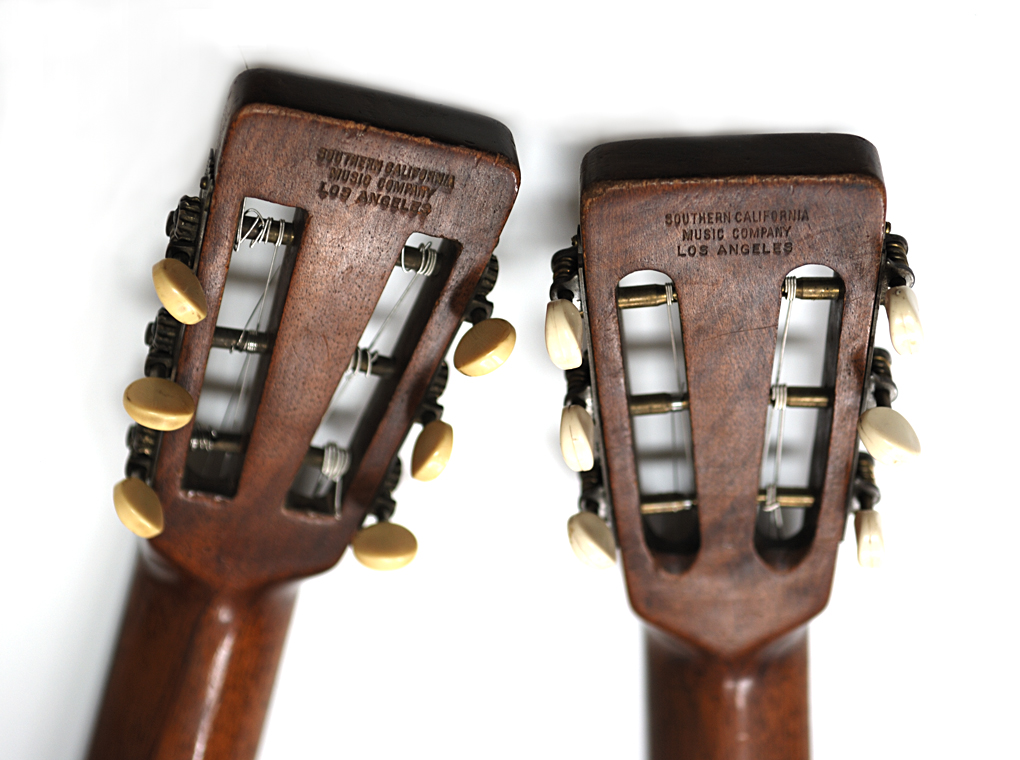
14003 and 14001
By 1919, the Style 1350 would be nearly indistinguishable from the Hawaiian Model 0-18K that would become a standard part of the Martin line.
C.F. Martin 1927 0-18K
Serial number 33958.
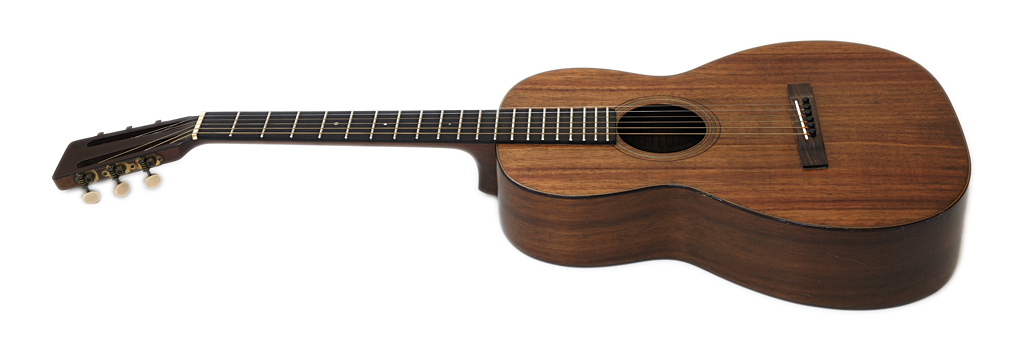
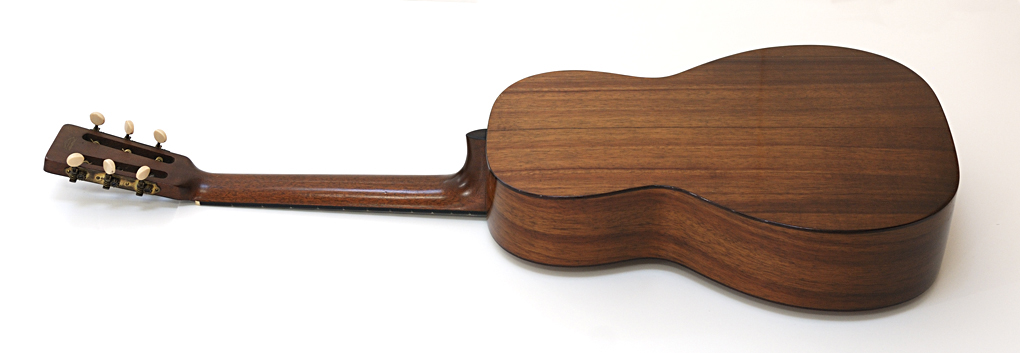
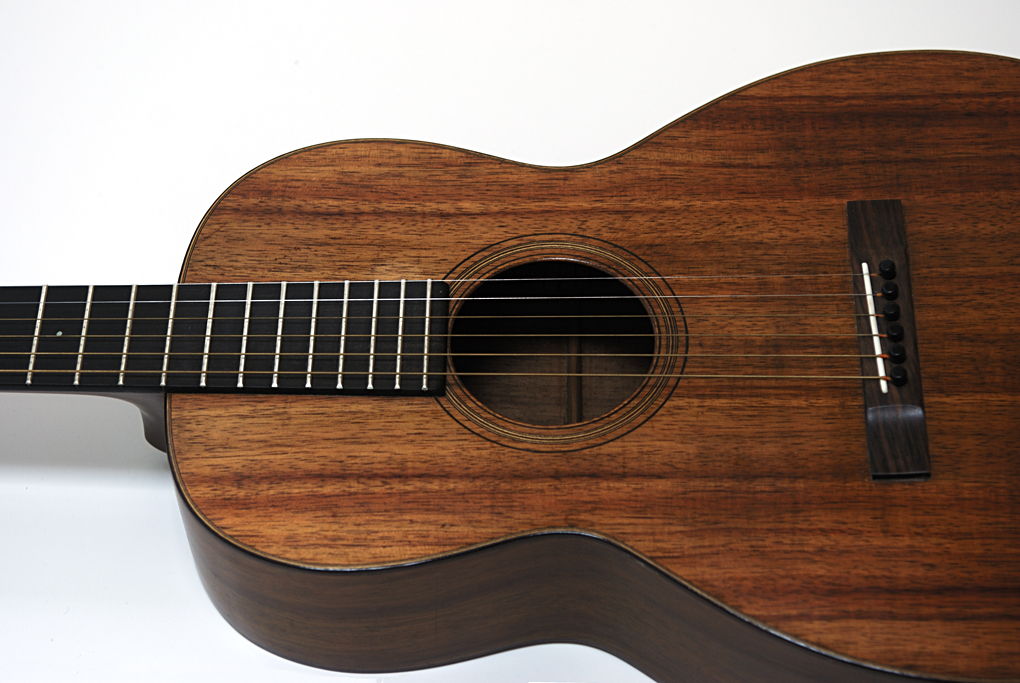
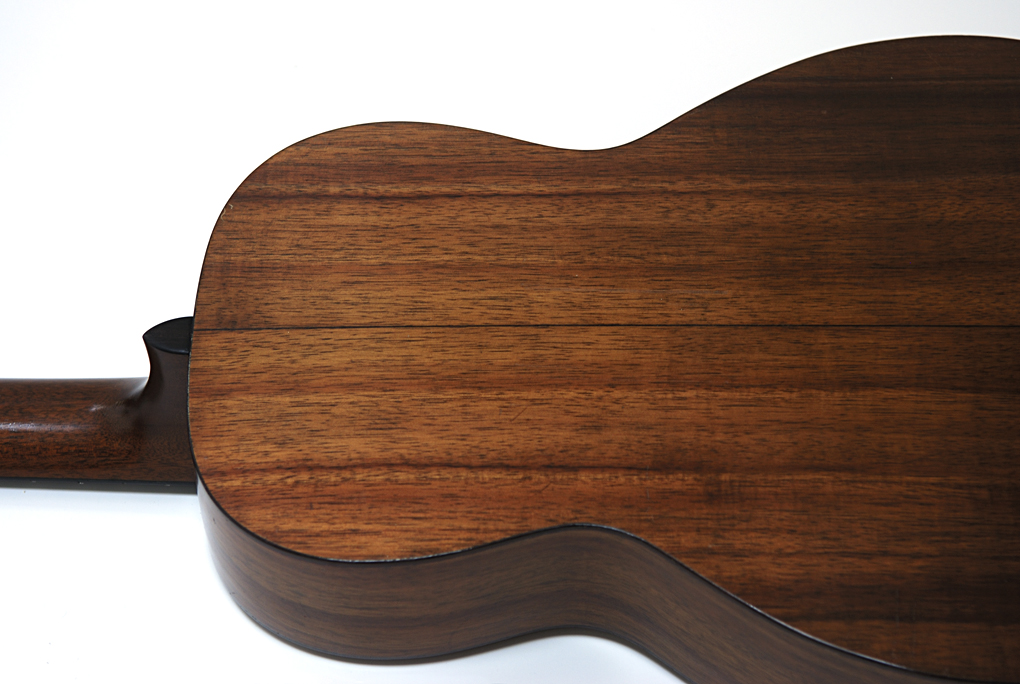
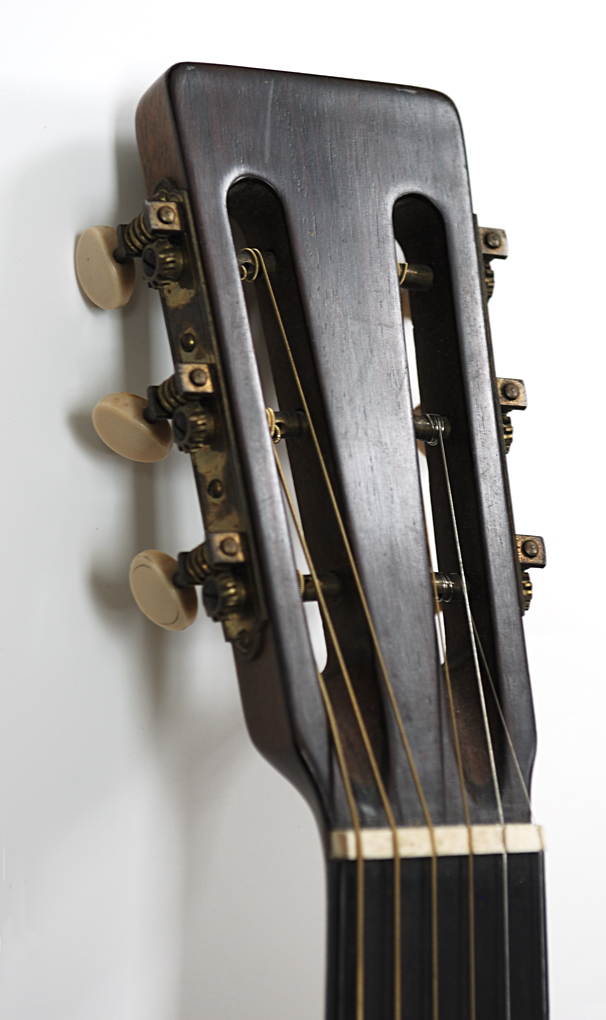
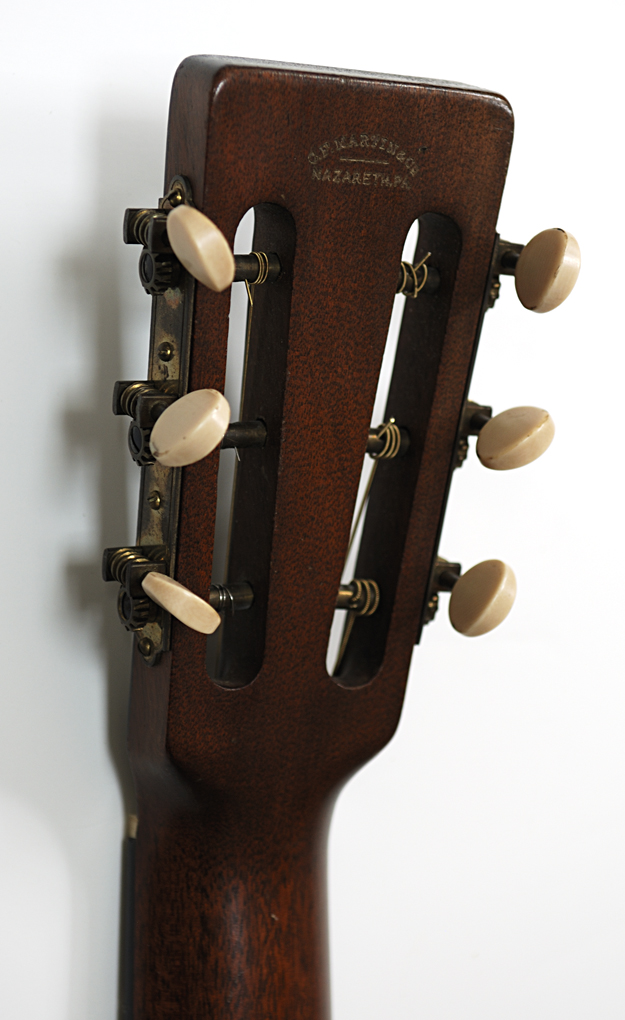
C.F. Martin/Southern California Music Company Model 1400
1916 Southern California Music Company "M. Nunes & Sons." Model 1400
This beautiful variation of a style 21 guitar made for the Southern California Music Company was marketed as the Model 1400, the middle of the three models produced by Martin for SoCal.
An early version with an "M. Nunes and Sons" interior label and headstock decal, and a Southern California Music Co. stamp on the back of the headstock.
The Martin name is conspicuously absent from this guitar.
From the first batch of production SoCal guitars, this was also one of the first batch of Martins to utilize all Koa wood construction. Interestingly, the vibrantly flamed koa is quite different from the plainer wood used on both the less expensive Style 1350 and the higher priced Style 1500.
Along with the early Ditson dreadnaught, also made with fan bracing, this was also one of the first production Martins made for steel strings.
The pyramid style bridge seen here is a later replacement.
76 of the Style 1400 were produced with SoCal serial numbers.
SoCal serial number 28.
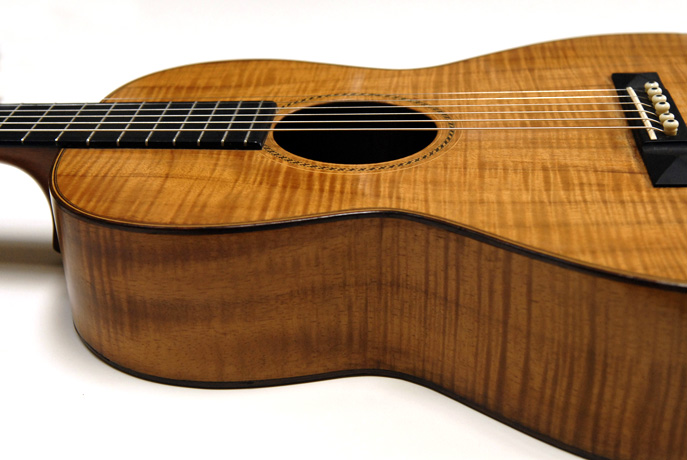
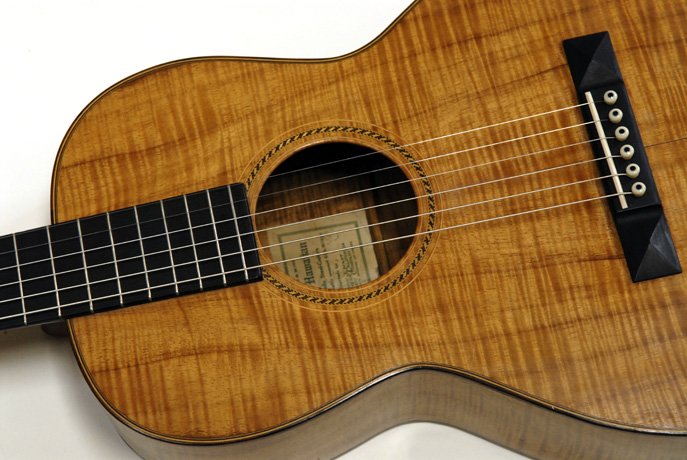
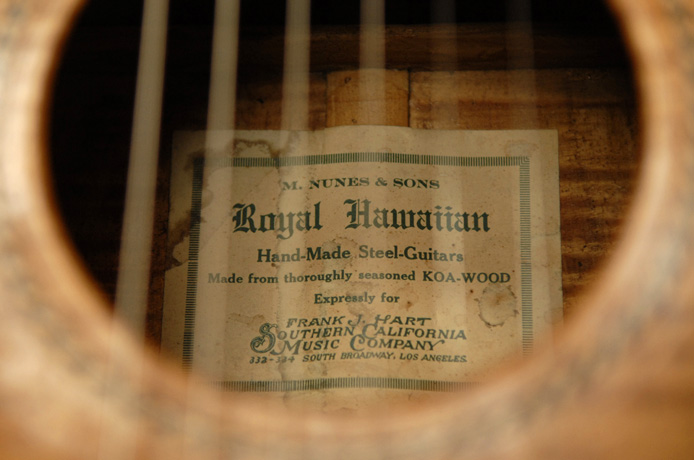
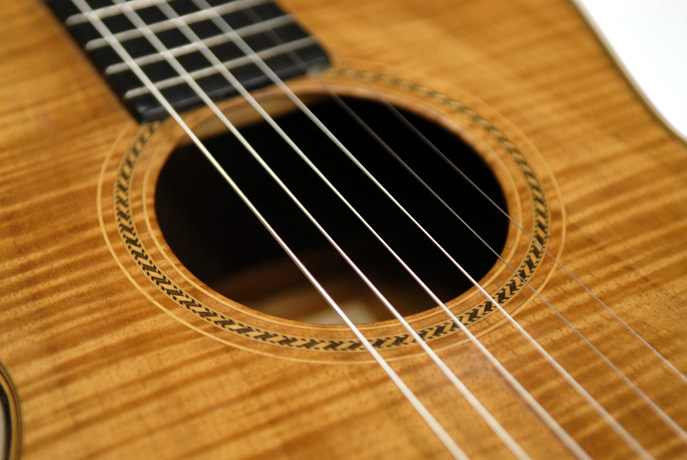
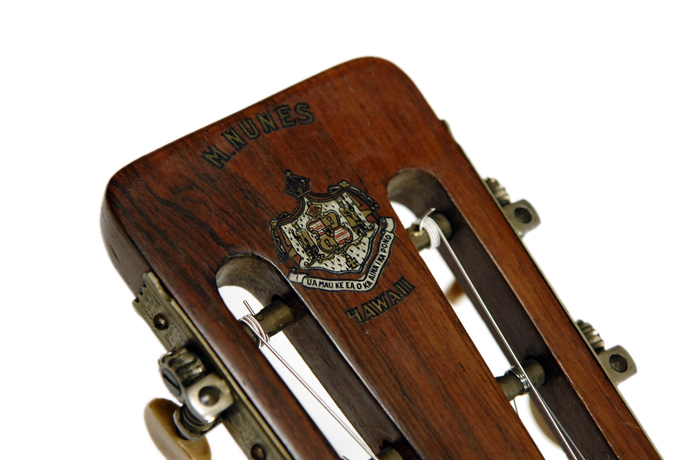
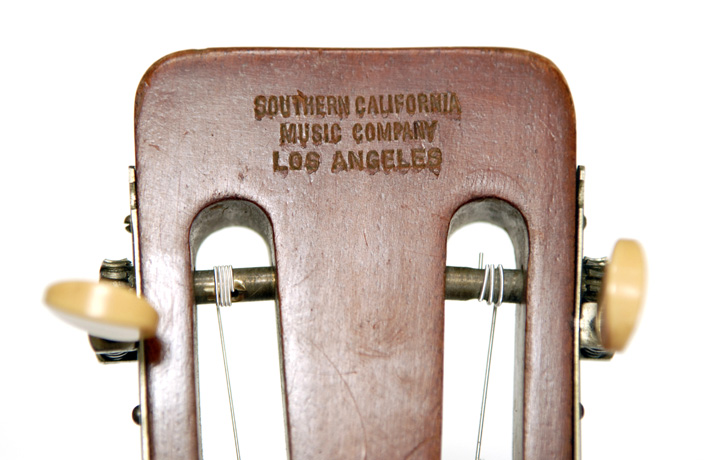
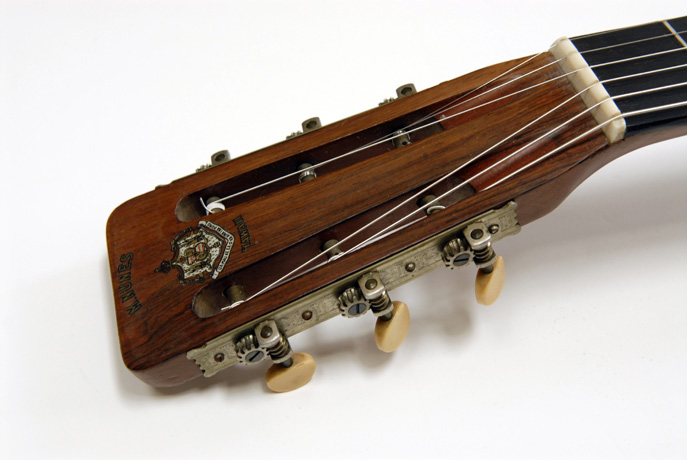
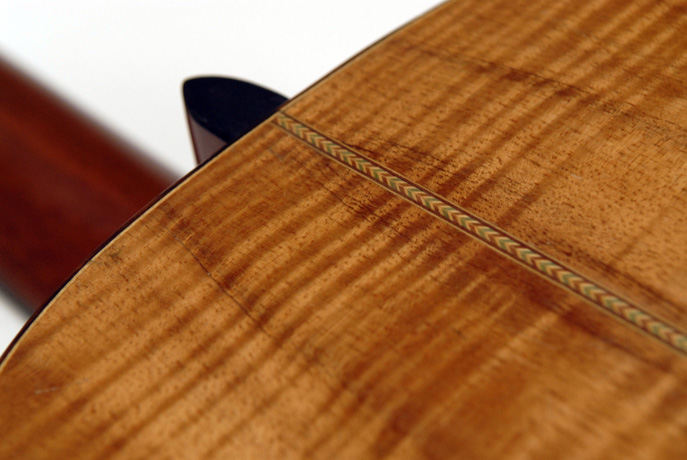
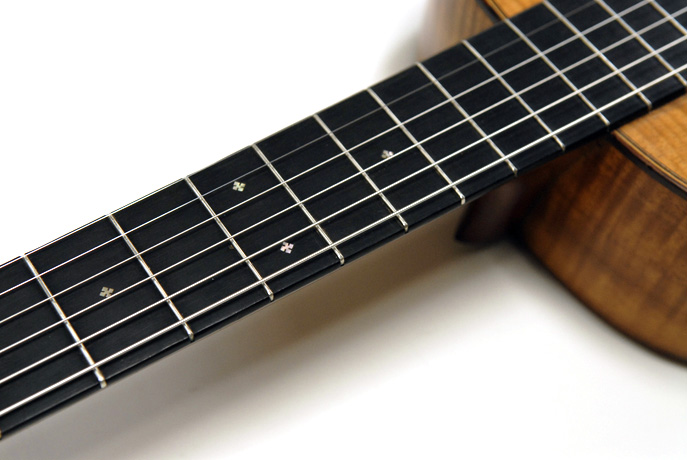
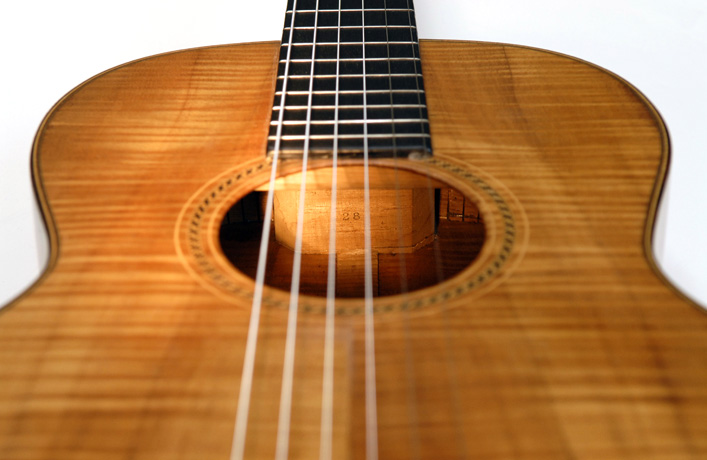
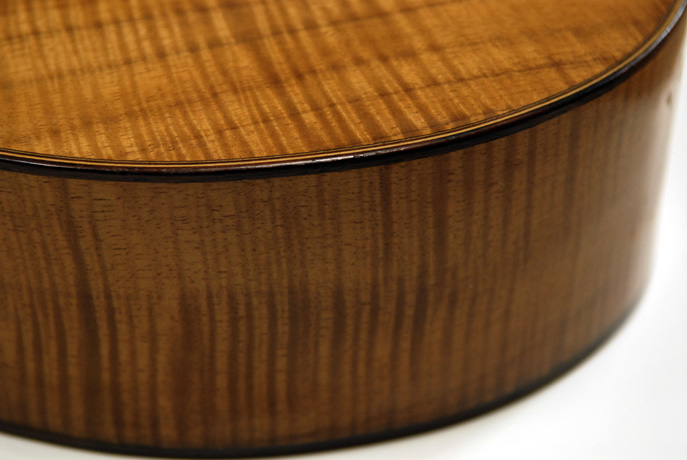
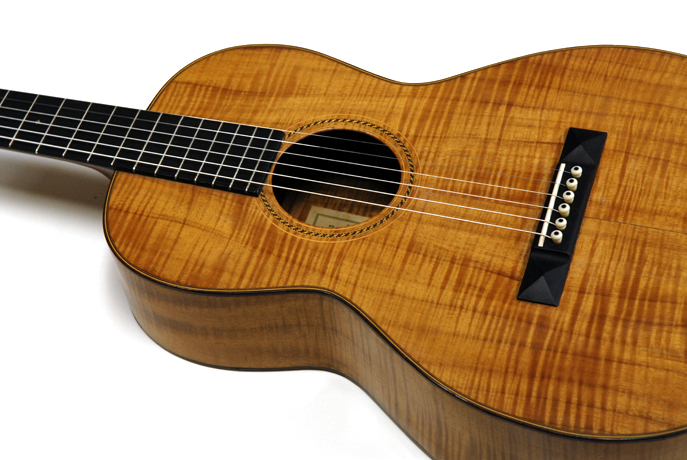
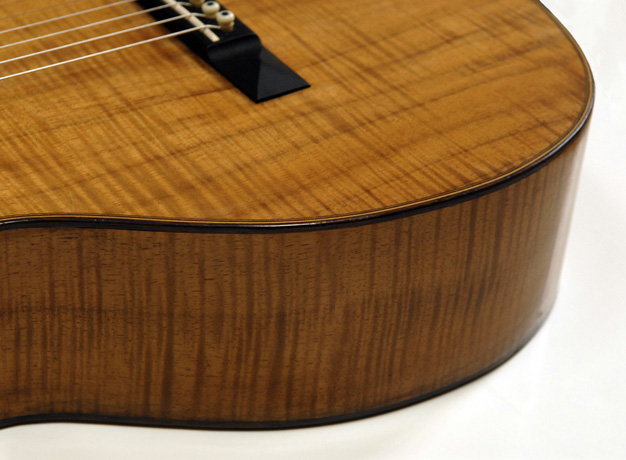
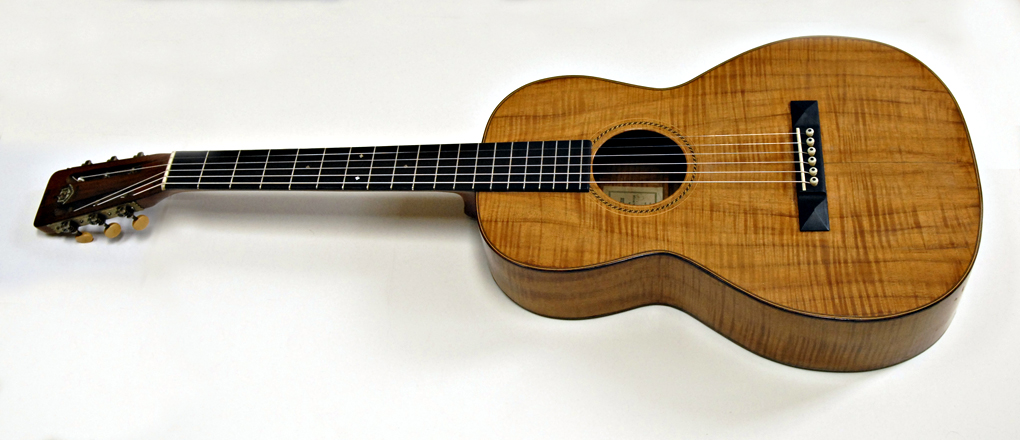
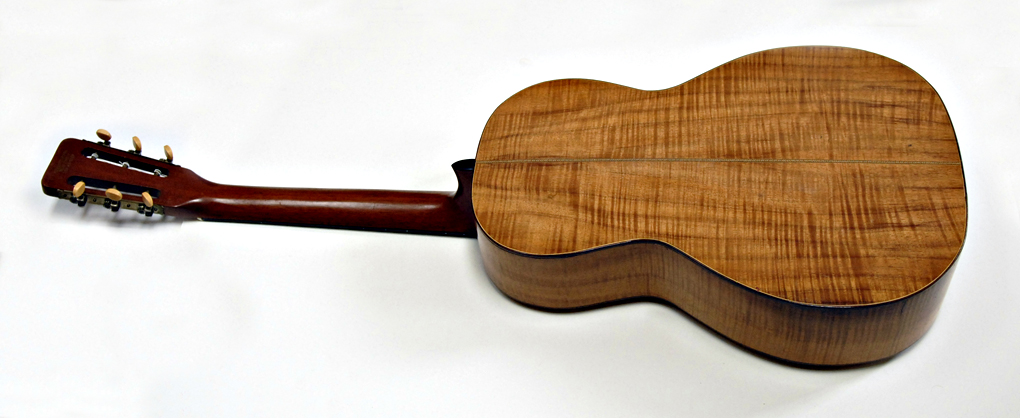
1917 Southern California Music Company "M. Nunes & Sons." Model 1400
The "standard Edition" of the Southern California Music Style 1400
With Martin Stamp on back of headstock.
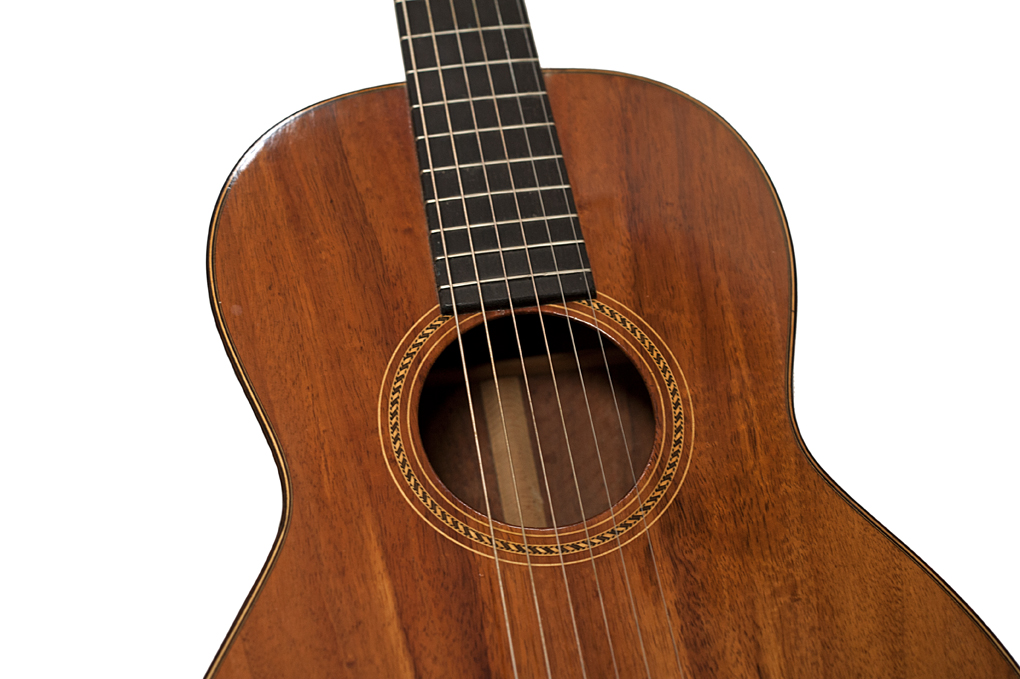

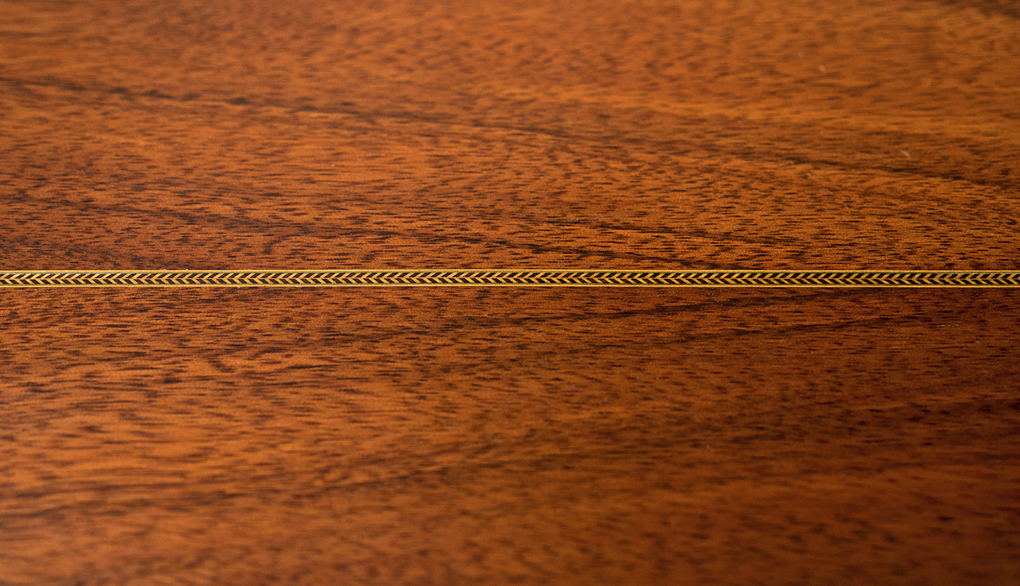
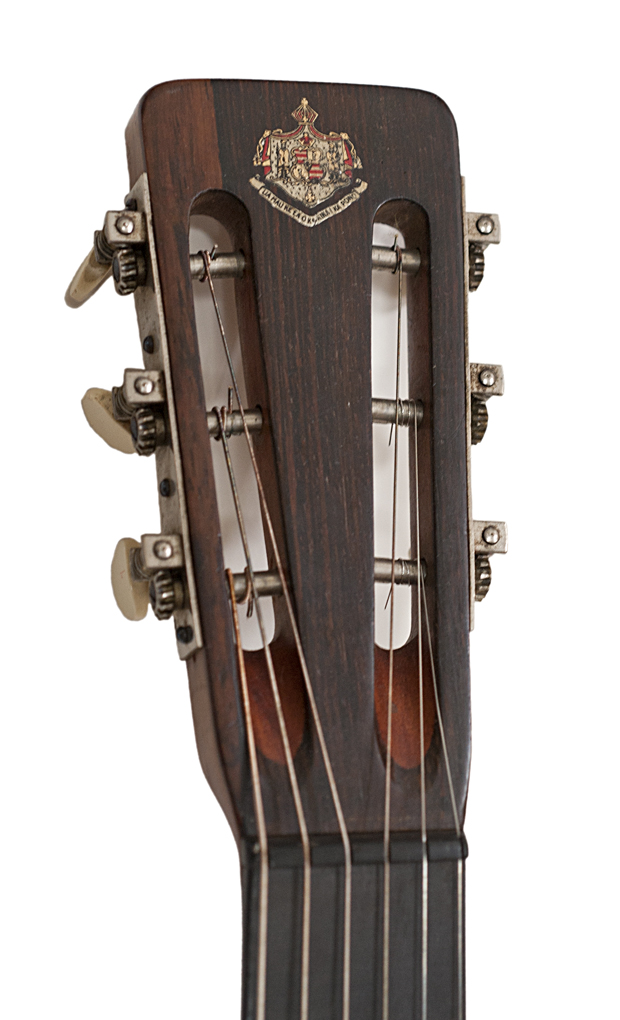
C.F. Martin/Southern California Music Company Sample Model 1500
This guitar is one of the six original samples with spruce tops which were requested of Martin by the Southern California Music Company, in a style similar to the Martin 00-28 but suited for playing in the Hawaiian style, with steel strings and fan bracing, similar to Hawaiian guitars first shipped 3 1/2 months earlier to the Ditson Company.
The sample Nunes also has the same single ring rosette seen on Ditsons and guitars made by Martin for several other firms, and a tinted spruce top similar to those seen on many Ditsons.
No serial number.
These samples have no serial number, while the regular production appears to begin with serial number 19, accounting for the six samples of each model.
Shipped July 10, 1916
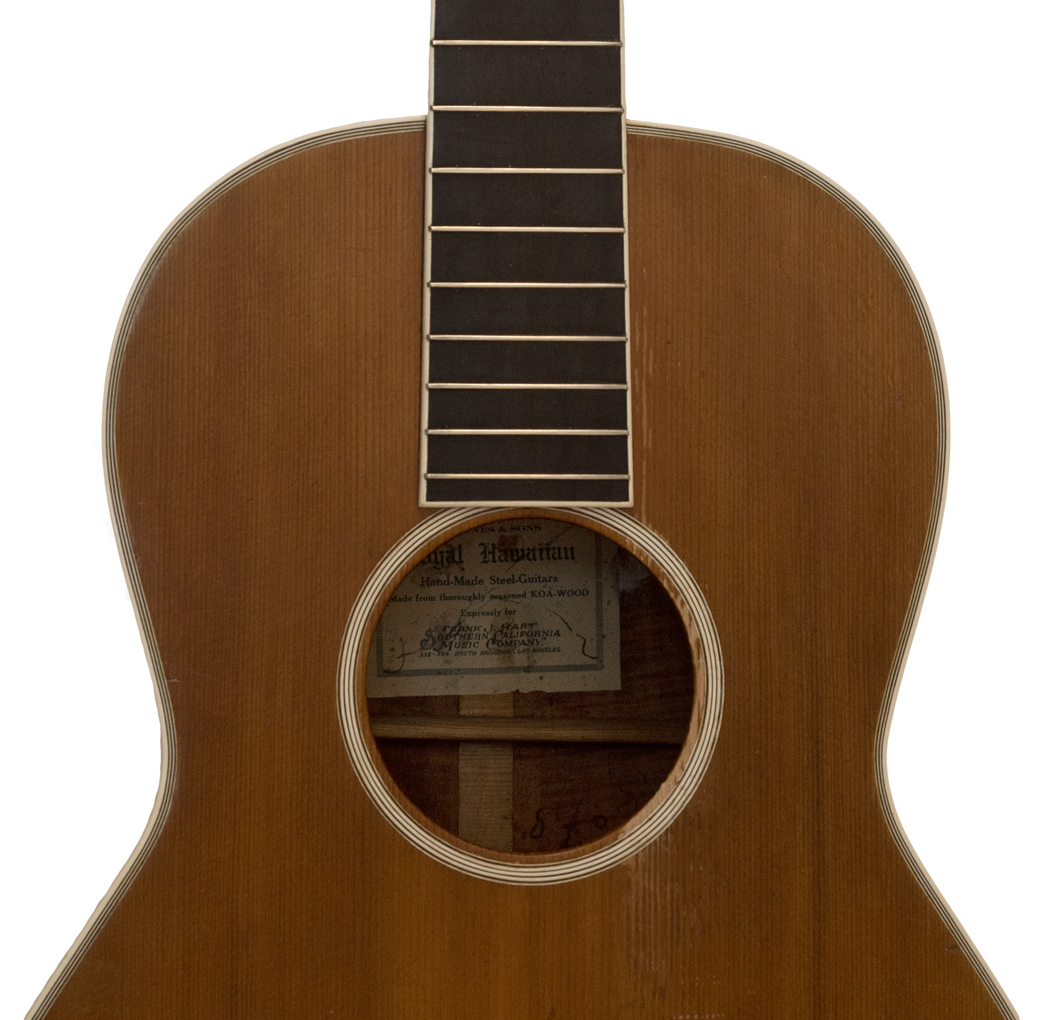
C.F. Martin/Southern California Music Company Model 1500
1916 Southern California Music Company "Rolando" Model 1500
Beautiful original condition variation of a style 28 guitar in 00 size made for the Southern California Music Company, and sold as the Model 1500, the top of the SoCal line.
With a "Rolando" paper label, Southern California Music Co. stamp on the center strip of the back, and a Martin stamp on the back of the headstock.
From the first batch of production SoCal guitars, this was also one of the first batch of Martins to utilize all Koa wood construction.
Along with the early Ditson dreadnaught, this was also one of the first production Martins made for steel strings.
14" top width.
Interestingly, while all other early Hawaiian steel string Martins have fan bracing, the early Style 1500 has X bracing, though it appears to have been made for Hawaiian playing.
Always a surprise, by 1919 this SoCal model still had the Rolando label and SoCal headstock stamp, but was produced with fan bracing! Though the 1919 examples have standard Martin Style 28 trim and a Martin stamp inside.
None of these early Hawaiians were actually set up for Hawaiian playing with high strings, but were meant to be played in the Hawaiian style with a nut extender.
Later examples of this model have standard Martin trim and Martin serial numbers.
47 of the Style 1500 were produced with SoCal serial numbers.
SoCal serial number 181.
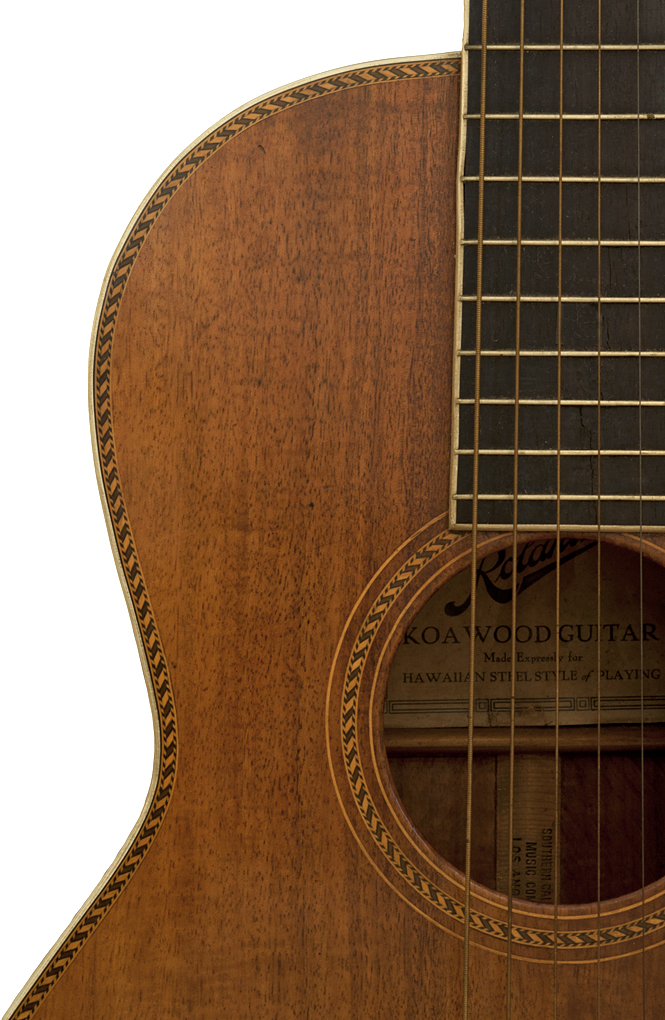
In some years, Martin put highly flamed koa on their finest koa guitars.
Just as often, Martin preferred the boring kind.
The photo at the top of the page shows two very early koa Martins built for the Southern California Music Co. at a time when Martin had their pick of the finest koa.
The guitar on the left is a beautiful, highly flamed Model 1400. On the right is the fancy, top of the line Model 1500, also shown above here, with no figure whatsoever.
The back of the sample for the cheaper Model 1350, the base model, shown near the top of this page, shipped by Martin to SoCal for final approval with wood intentionally selected by SoCal, was also highly flamed.
Martin was definitely not consistent in their use of flamed koa.
Like the straight grain, quartersawn rosewood, with no figure, the boring koa is more stable.
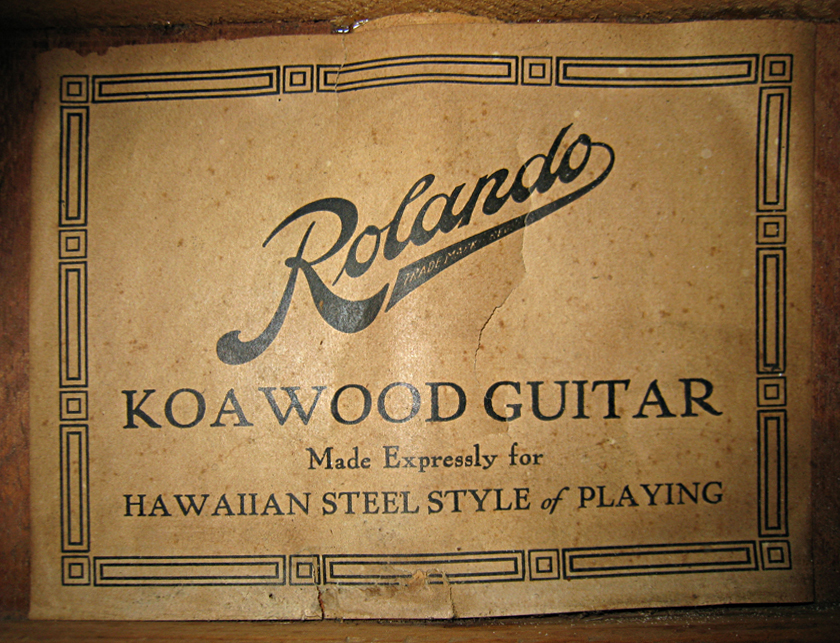
The early Rolando 1500 has the Martin stamp on the headstock, but a Southern California Music Company stamp on the back strip inside the guitar.
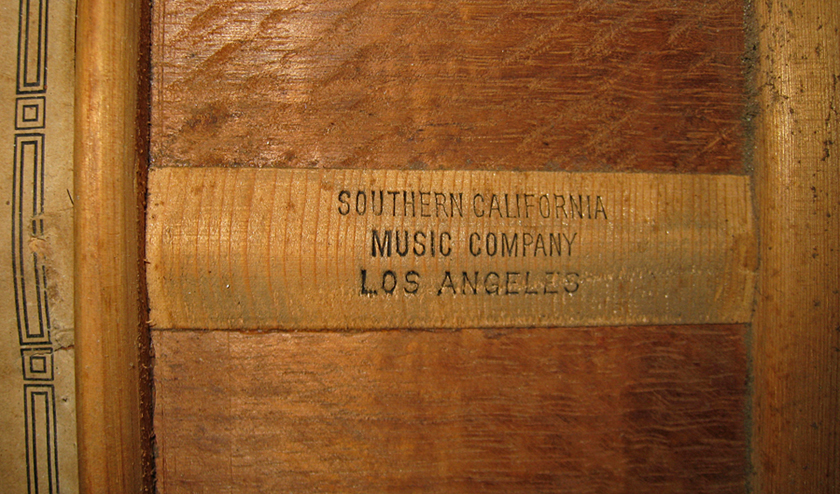
This early Rolando 1500 has the Hawaiian decal on the headstock without the words "M. Nunes" or "Hawaiian".
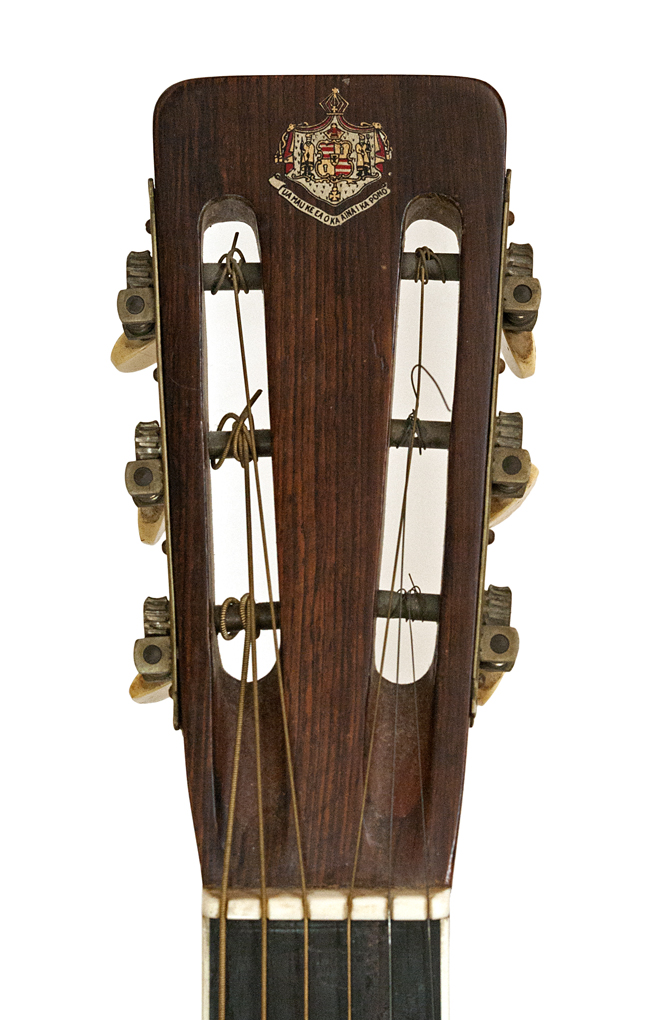
The Rolando 1500 also has a unique fretboard inlay not seen on any other Martin with the exception of the Foden Model C.
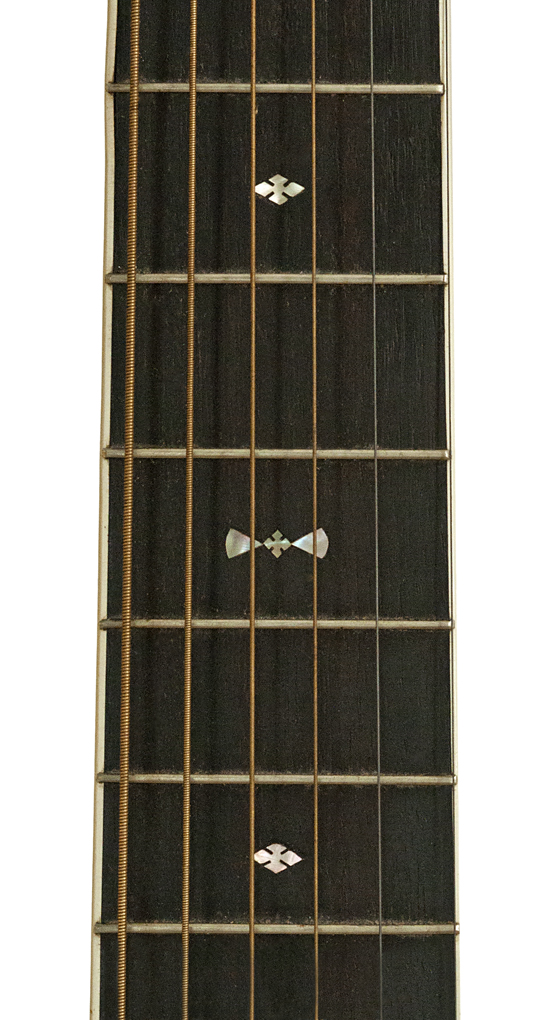
...and a back strip Marquetry different from other Martins as well, though similar to other Martins from the period.
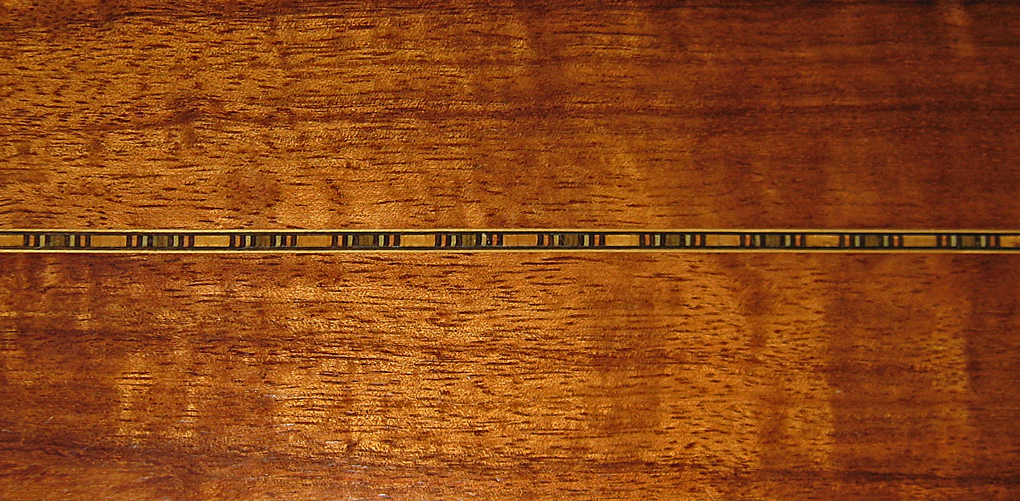
Oscar Schmidt Rolando
It's been said that SoCal supplied Martin with sample SoCal ukuleles so that Martin might match the trim on the new Martin built models to existing instruments in the SoCal line.
This guitar, remarkably similar to those produced by Martin, with the exact same headstock decal, same "Rolando" label, similar marquetry, and similar koa body, but apparently made by Oscar Schmidt, leads me to belive that SoCal may have had this guitar produced before the Martin, and supplied a guitar such as this for Martin to replicate.
It is also possible that SoCal moved to this cheaper version after the Martin, since the first sample Martin SoCals did have the "Nunes" label, not the "Rolando" label, and we have not yet seen a sample with similar trim.
No serial number
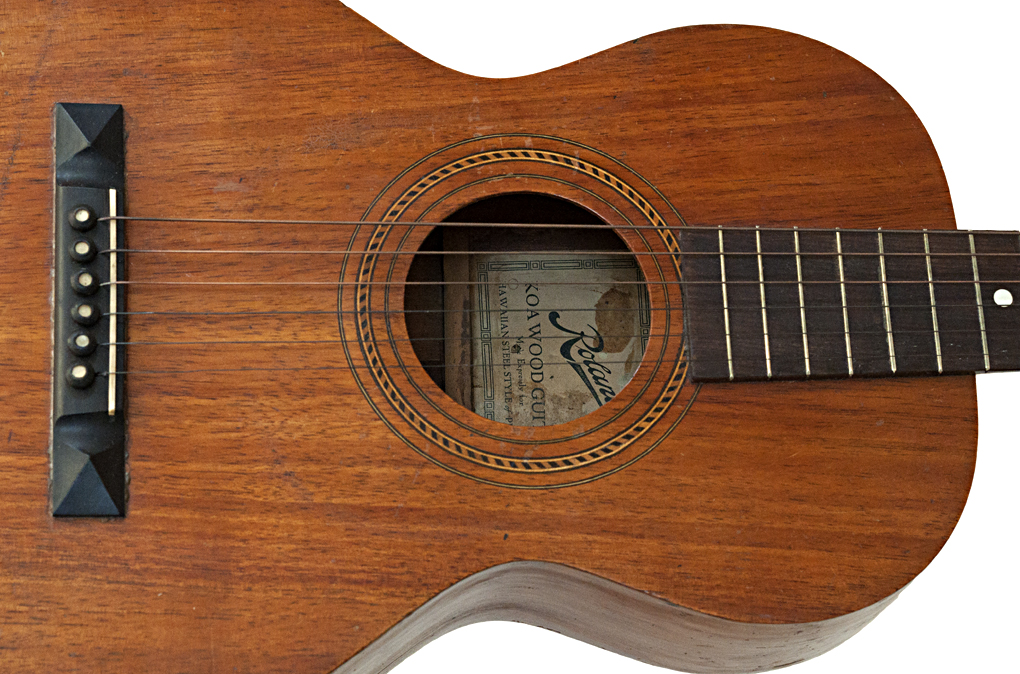
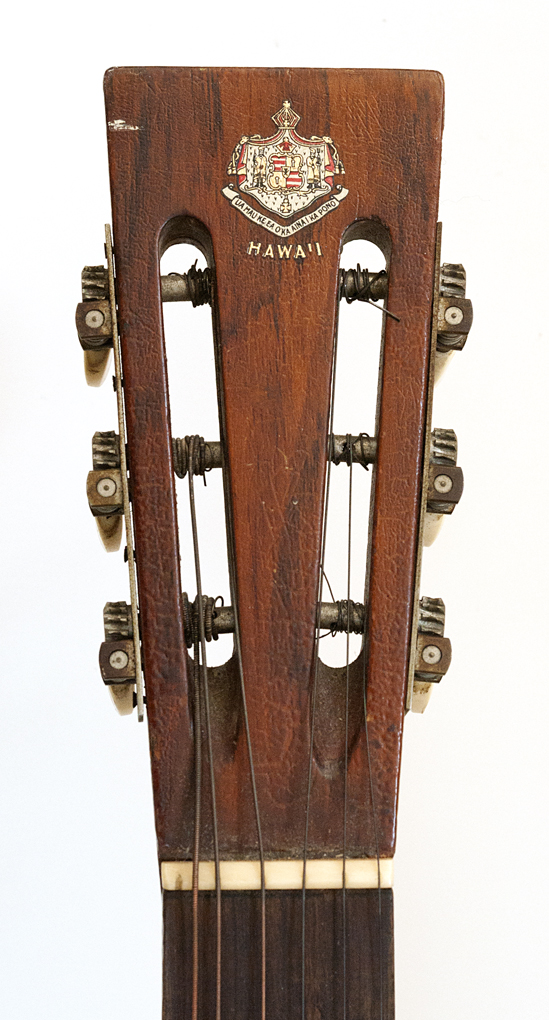
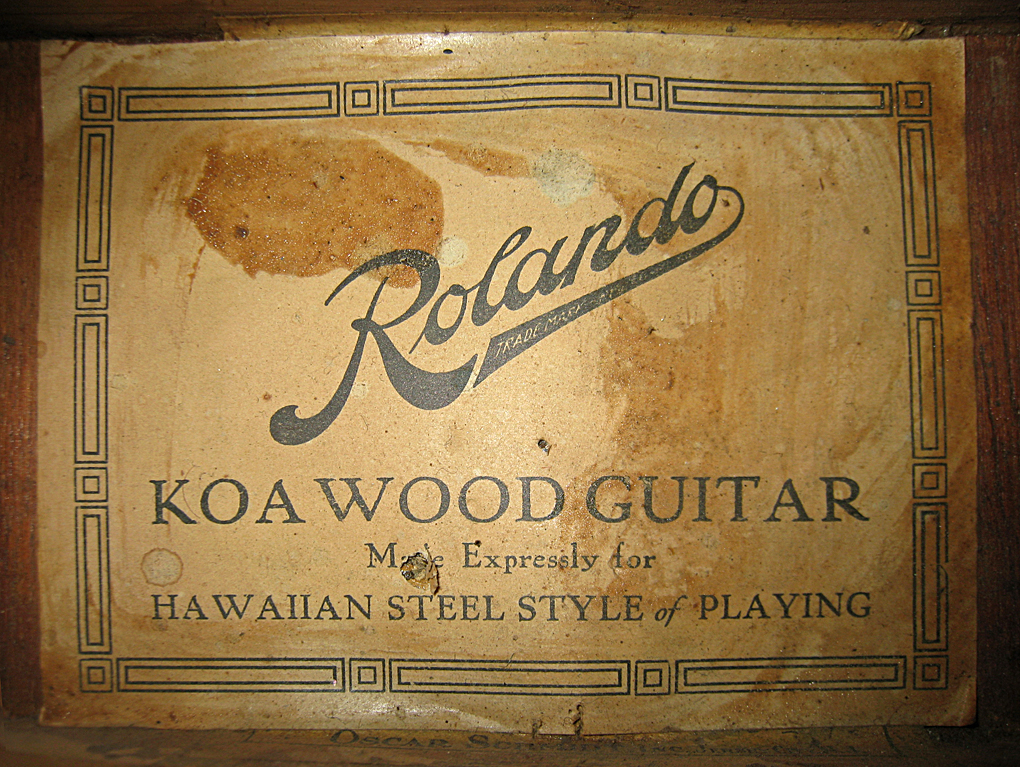
/\ /\ /\ /\ /\ /\ /\ /\ /\ /\ /\ /\ /\ /\ /\ /\ /\ /\ /\ /\
With careful examination, note at the bottom of the label above: "Oscar Schmidt, Inc. Jersey City" printed on a second label underneath:

I was wondering which of the Chicago makers built the guitar.
So you can imagine how surprised I was when I photographed the label and "Oscar Schmidt, Inc. Jersey City" popped up in front of my eyes on the camera display!
I never would have noticed this by inspecting the guitar in hand alone.
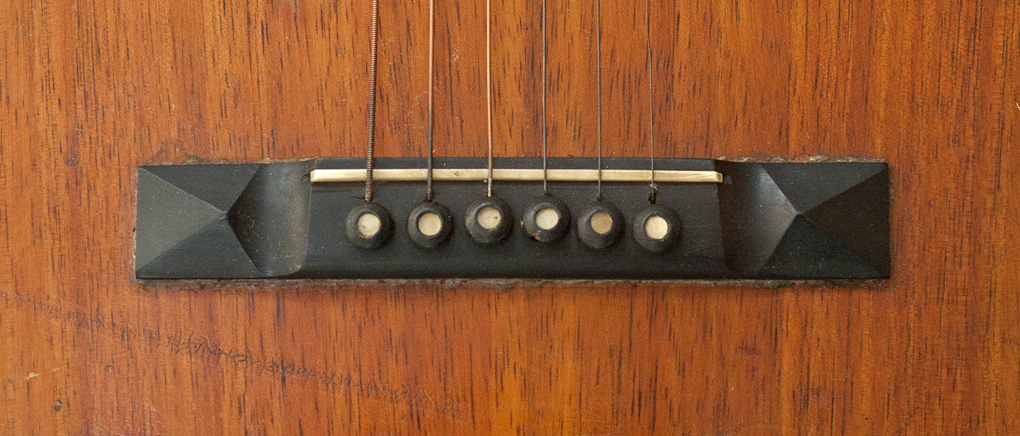
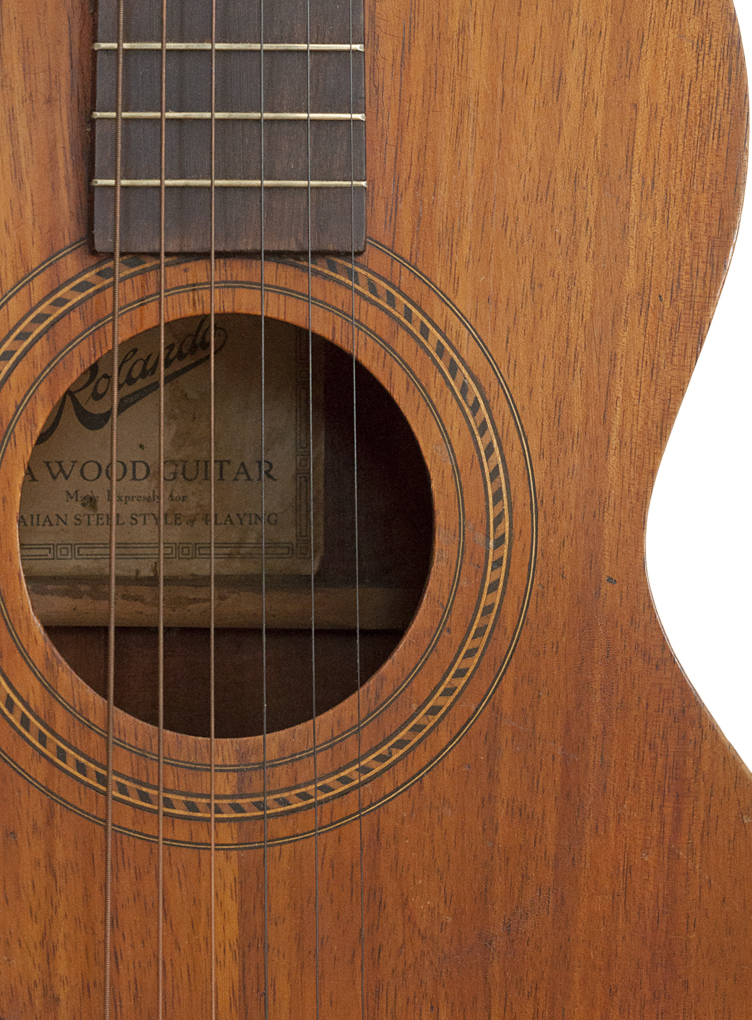
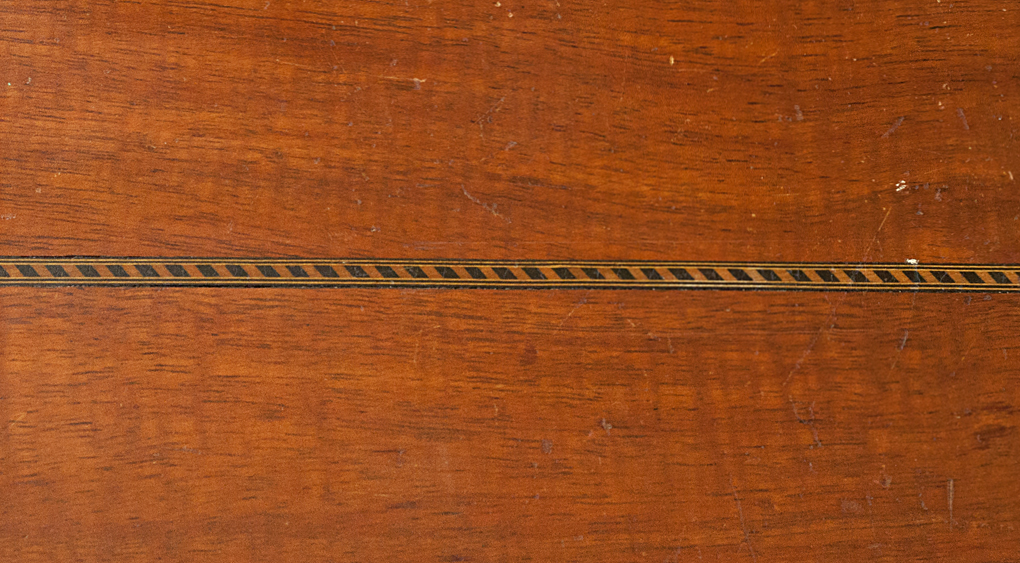
C.F. Martin Guitars Hawaiian Guitars Made for Oliver Ditson & Co.
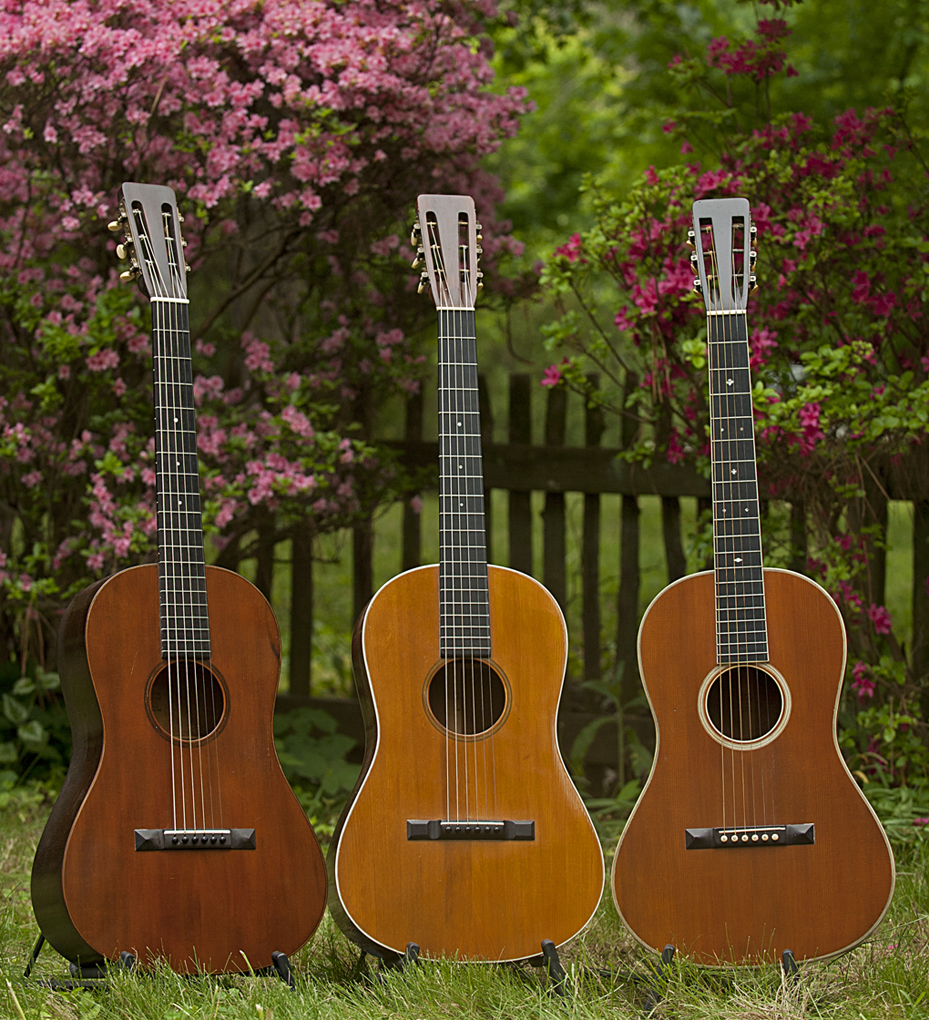
Martins made Ditson 1921 Style 11 #565, 1916 Style 22 #160, and 1920 Style 33 #557.
Martin's "Ditson Model" guitars, with their wide waisted body shapes reminiscent of early European guitars, were made expressly for the Ditson Stores and came in three sizes, Standard, Concert, and Extra Large.
The Standard Model has a width at the lower bout of 11 1/8"
The Concert Model has a width at the lower bout of 12 3/4"
The Extra Large Model has a width at the lower bout of 15 5/8"
The Extra Large model, requested by Harry Hunt of the Ditson Company, and designed with the help of Martin shop foreman John Deichmann, became known as "the Dreadnaught", and was the first Dreadnaught guitar ever made.
The Ditson Models had their own model designations, and unlike other Martins, their trim level was designated as 1, 2, or 3, but their size was designated by the number of digits, i.e. 1, 11 or 111.
All of these regular Ditson Models were made with a spruce top and mahogany back and sides.
Some Ditson Model guitars have either lighter orange tinted tops or dark stained tops. In some years the stained top was an option.
While fan bracing is generally associated with lighter guitars made for gut or nylon strings, the Ditson models have the same style of fan bracing as seen on the koa wood guitars made for the Southern California Music Company, which were originally made to be played with heavier steel strings in the Hawaiian style.
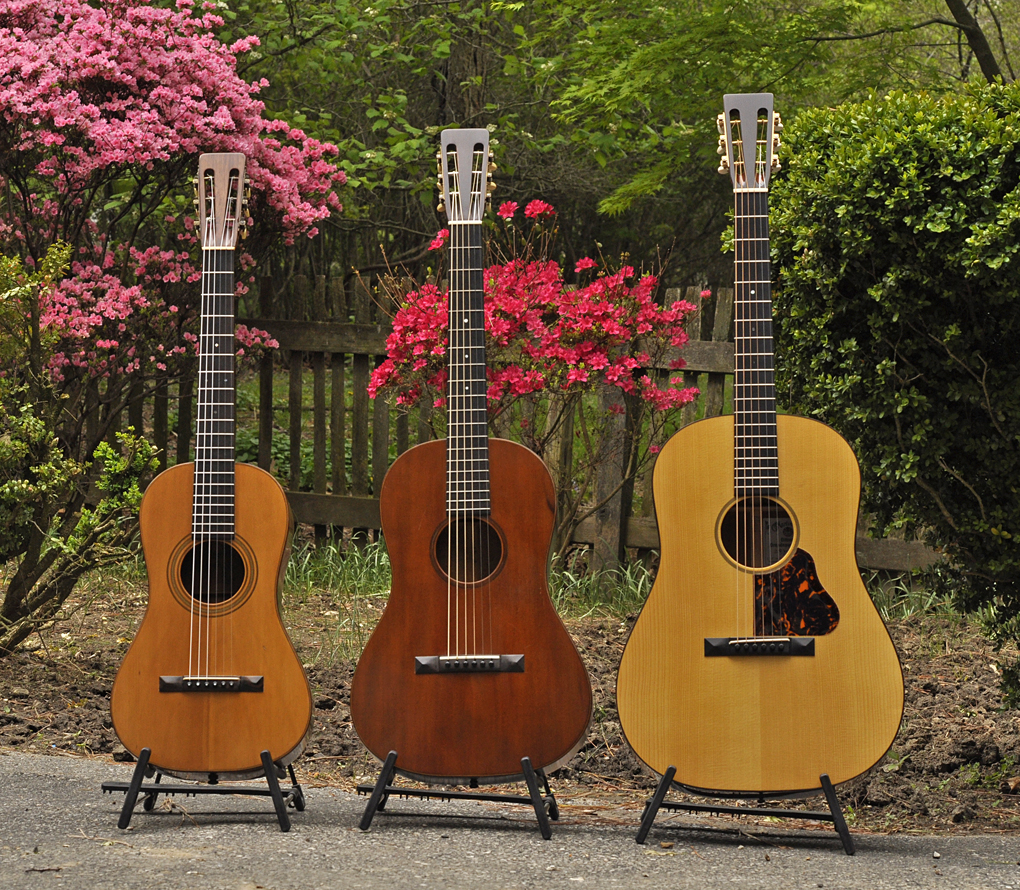
The "Standard" size Ditson Model 1-21, "Concert" size Ditson Model 11, and "Extra Large" (Dreadnaught) size Ditson Model 111 reissue.
The Models 1, 11 and 111 have dark binding on front, none on the back.
The Models 2, 22 and 222 have white binding front and back.
The earlier Ditson models had bridges supplied by Lyon & Healy of Chicago with raised flat topped squares on the wings rather than the pyramids typical of many of the better vintage Martins.
The 3 and 33 were fancier models which changed a bit through the years. These had pearl inlaid bridges supplied by Lyon & Healy, and the earliest examples had fancy fingerboard inlays. The extra large 333 was catalogued, but none seem to have been made.
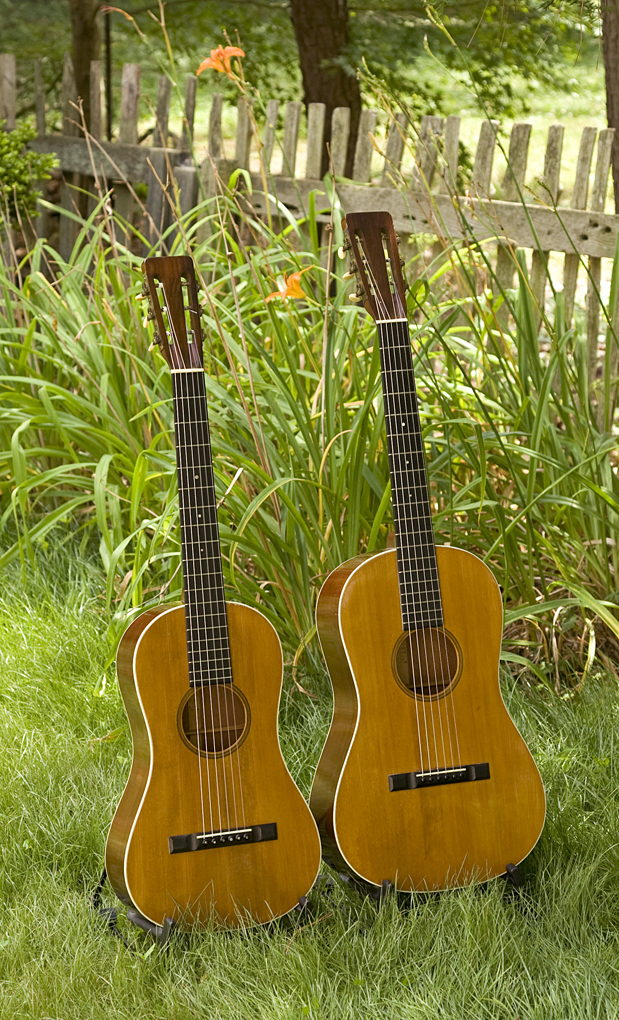
Early Ditson Model 2 #144 and Model 22 #160, both from December, 1916
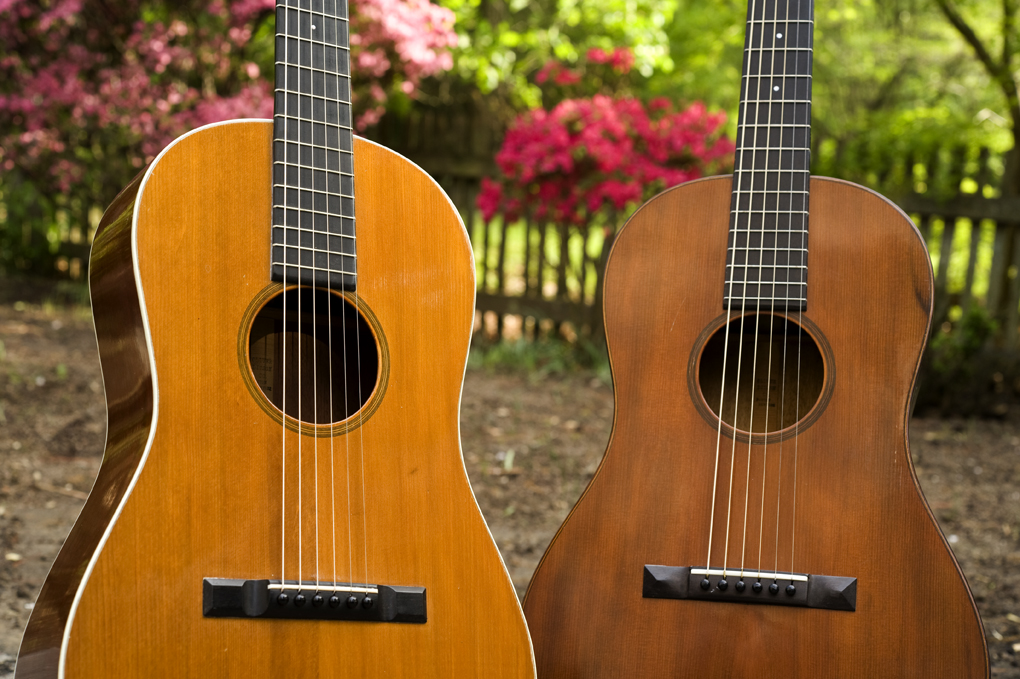
Early Ditson Model 22 #160 from December, 1916 with white binding, standard tinted top and Chicago style bridge, and one from the very last batch of small Martin "Ditson Model" guitars, a Model 11, #565 from January, 1921 with dark binding on top only, optional dark tinted top and standard Martin pyramid bridge. The Model 111 was revived in 1923, and 19 more were made between then and 1930, with standard Martin X bracing replaing the earlier fan bracing.
Ditson also sold guitars which combined the trim levels of regular Martin Styles with the same small, narrow body shape of the Ditson "Standard" size, an example of which is the Style 1-21 shown here. The 1-21 has standard Martin Style 21 trim, including herringbone design marquetry in the rosette around the soundhole and in the center strip on the back. Besides the 1-21, this Ditson size was also available as Ditson Models 1-18, 1-28, 1-30, 1-42, and 1-45.
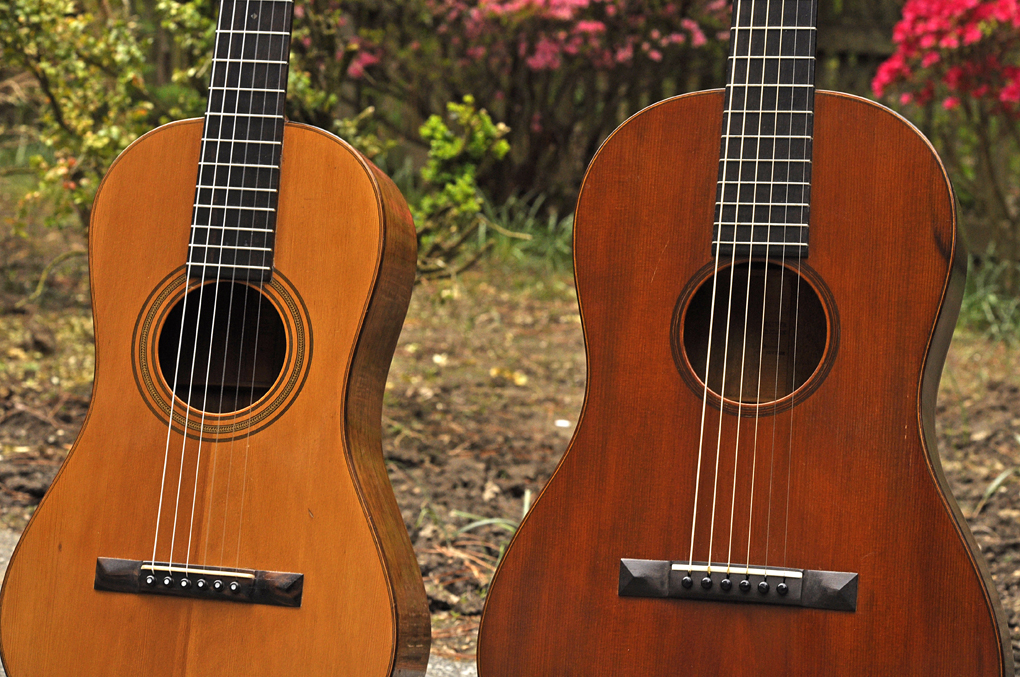
Ditson Model 1-21 #433 from July, 1919 and Model 11 #565 from January, 1921
Ditson was a large music retailer with stores in New York and Boston (and earlier in Philadelphia), and was one of Martin's largest customers, selling guitars and other instruments, including many mandolins. Besides the "Ditson Model" Martins, a large number of regular Martin models, stamped with the C. F. Martin name only, were sold by Ditson. A number of the regular Martin models were also sold by Ditson with the Ditson stamp on the back of the headstock and/or on the inside center strip. And many other models, such as the Empire, were made by other manufacturers for Ditson. So finding an instrument with the Ditson stamp does not necessarily mean you've found a "Ditson Model" Martin, or even an instrument that was made by Martin at all.
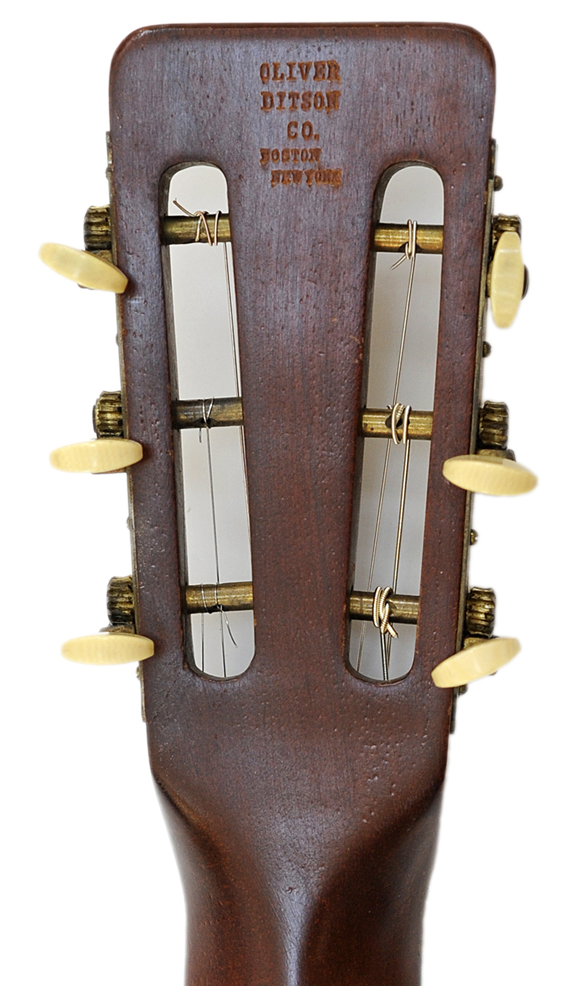
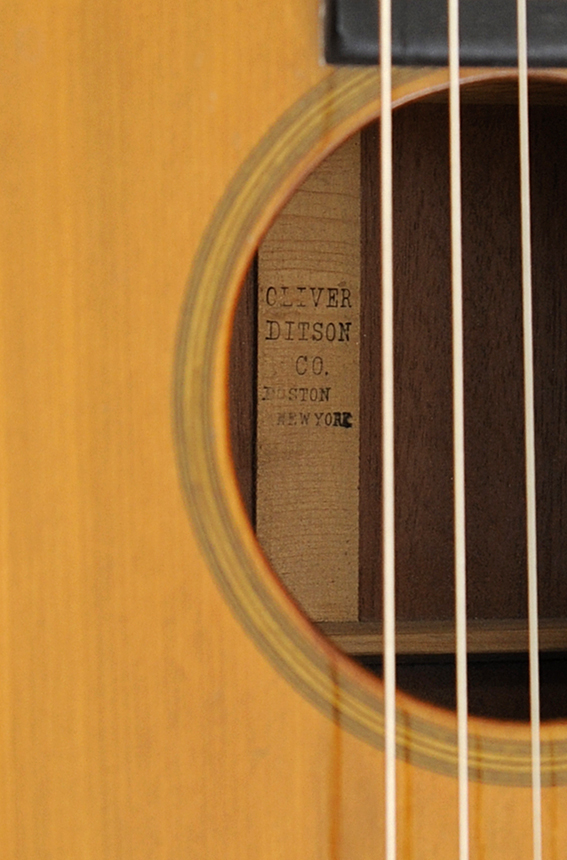
1916 Ditson Model 22 with Oliver Ditson stamps.
During the boom years of the Hawaiian craze, as Martin was struggling to keep up with demand, Martin purchased "Chicago Style" bridges supplied by Lyon & Healy, which were used on the Ditson models.
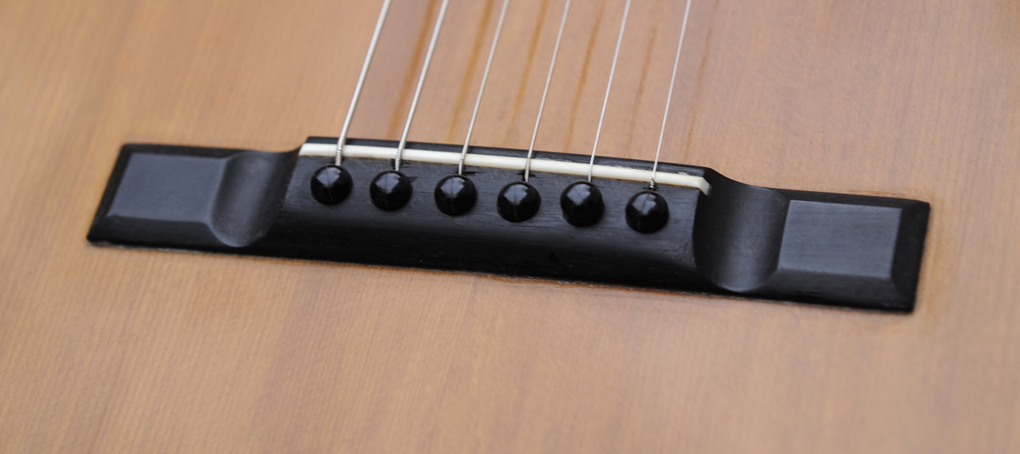
Ditson Standard Model Dimensions:
Width at the upper bout, 8 7/16"
Width at waist, 7 1/8"
Width at the lower bout, 11 1/8"
End to bridge, 4 9/16"
Bridge depth, 15/16"
Bridge to soundhole, 4 1/8"
Soundhole, 3 9/16"
Soundhole to 12th fret, 4 1/2"
Ditson Concert Model Dimensions:
Width at the upper bout, 9 7/8"
Width at waist, 8 1/2"
Width at the lower bout - 12 3/4"
End to bridge, 5 13/16"
Bridge depth, 15/16"
Bridge to soundhole, 4"
Soundhole, 3 9/16"
Soundhole to 12th fret, 4 9/16"
C.F. Martin 1916 Ditson Standard Model 1
Listed as "New Style 1".
Serial Number 118
Shipped 10/24/16

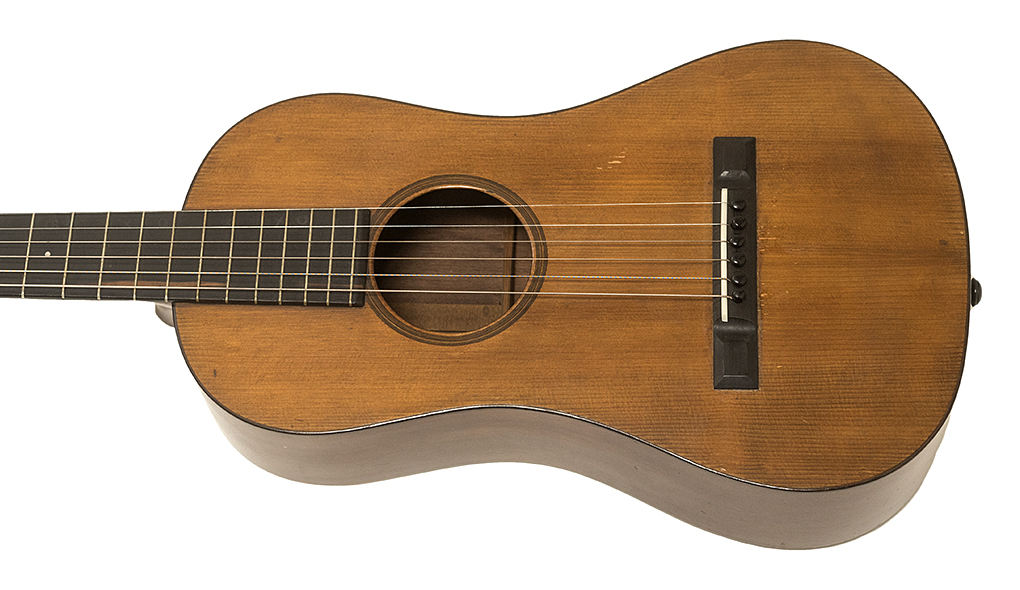
From the last batch of Ditson Style 1 guitars.
Serial Number 542
Shipped 6/8/20
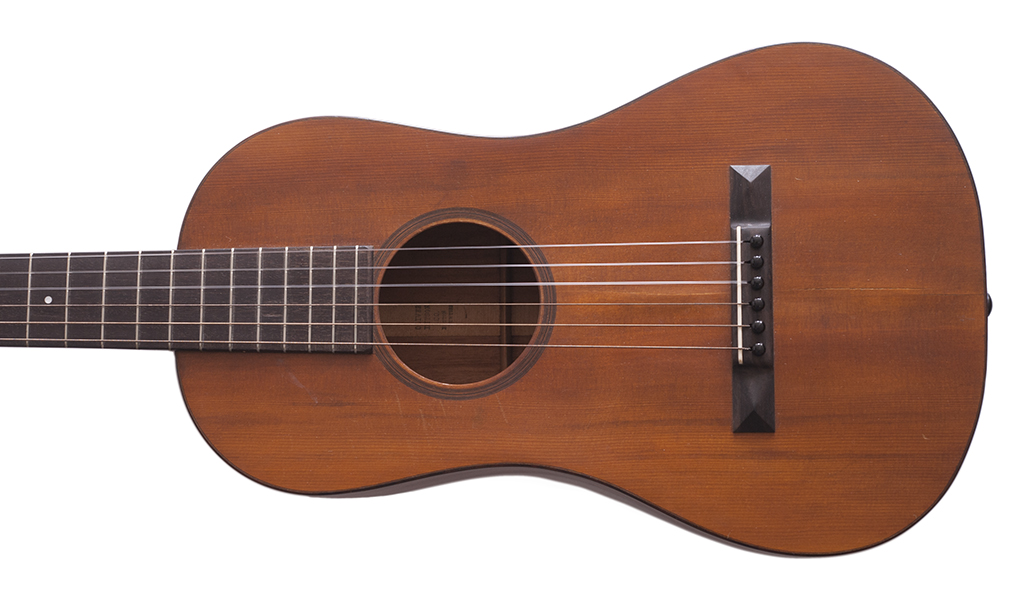
C.F. Martin 1916 Ditson Standard Model 2
From the first batch of Ditson "Dreadnaught" guitars.
This is the earliest Martin/Ditson and the earliest "Dreadnaught" shaped guitar that we know of existing today.
This first batch of Ditsons, listed as Ditson "Standard" guitars, was specified to be "like style 2 uke".
While the second batch of Ditsons, built a month later, were listed as "Standard Style 2 guitars", this first batch was not assigned with a Style number.
Serial Number 6
Shipped 3/28/16
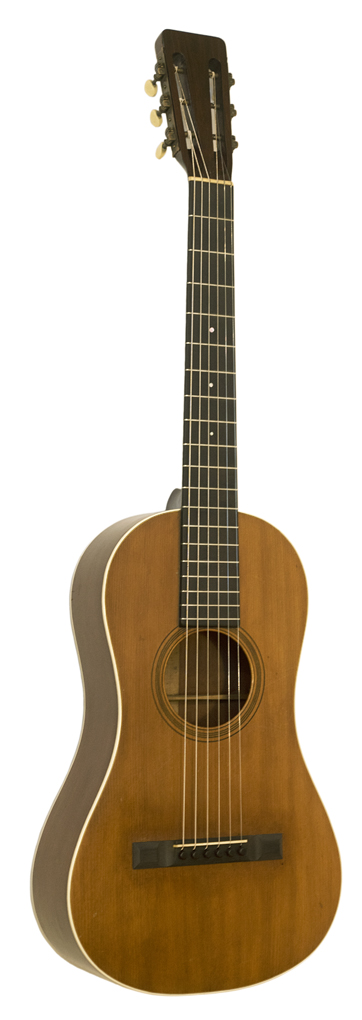
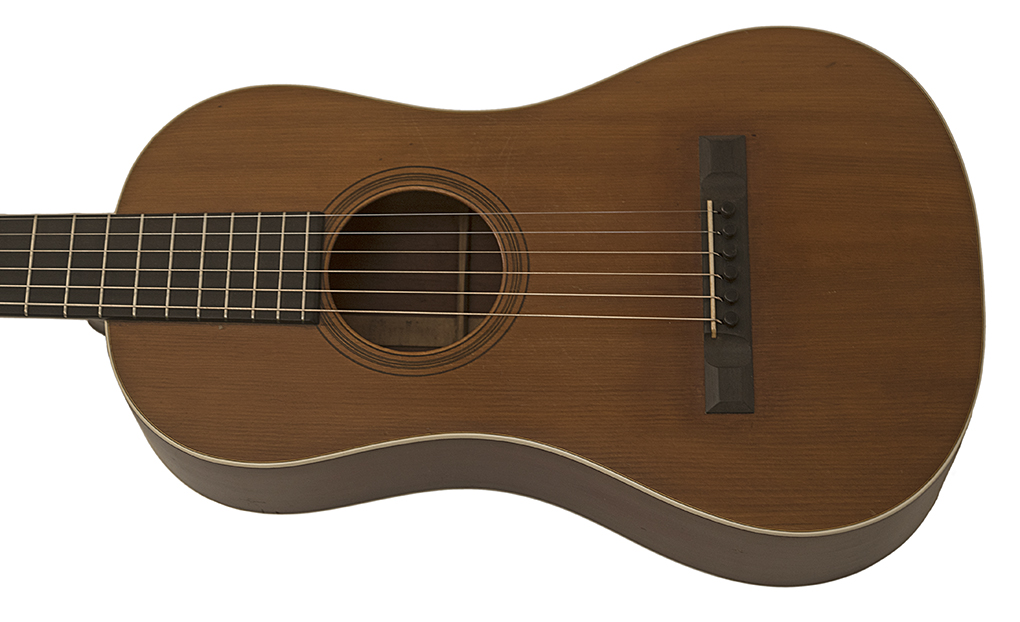
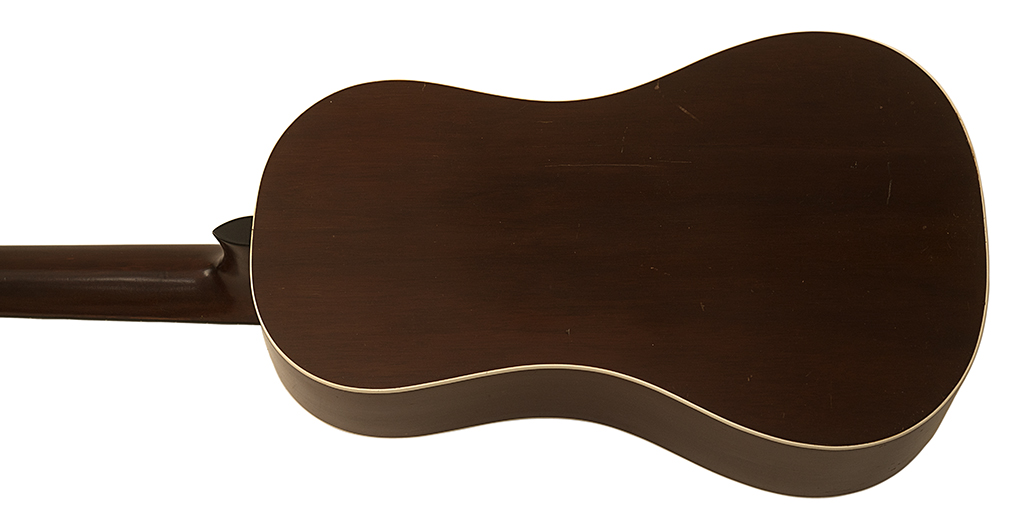

C.F. Martin 1920 Ditson Concert Model 11
The "Concert 1" was the last of the Ditson Concert models to be built.
This guitar is from the second batch, one of only 30 Style 22 built.
Serial Number 565
Shipped 1/5/21
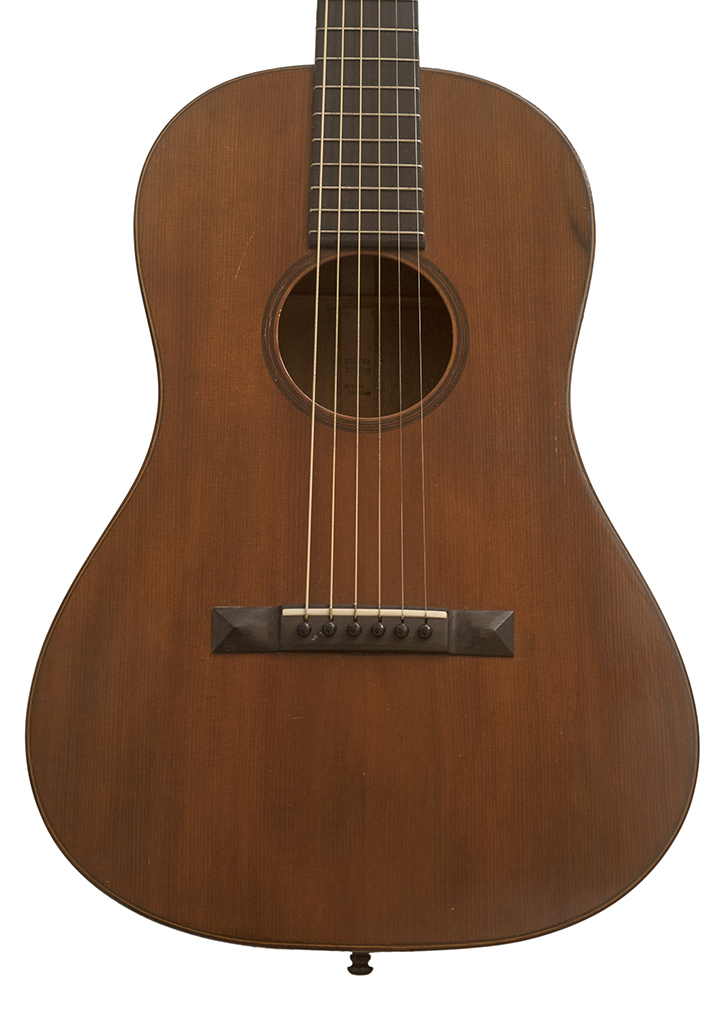
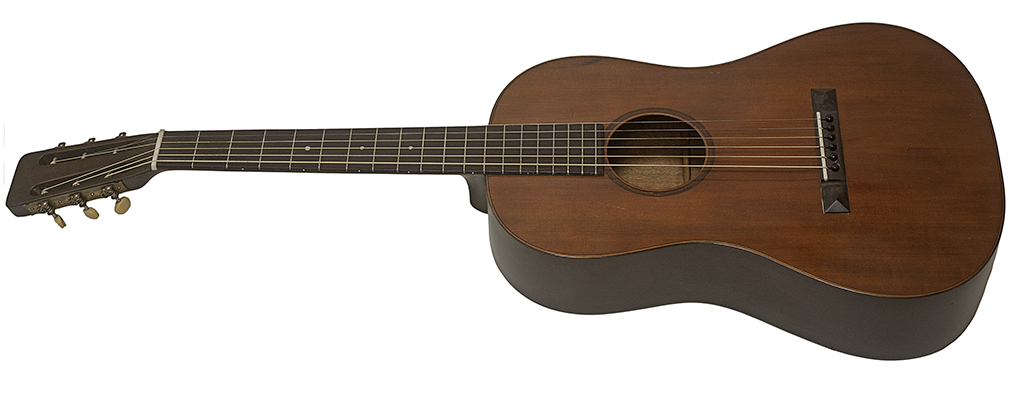
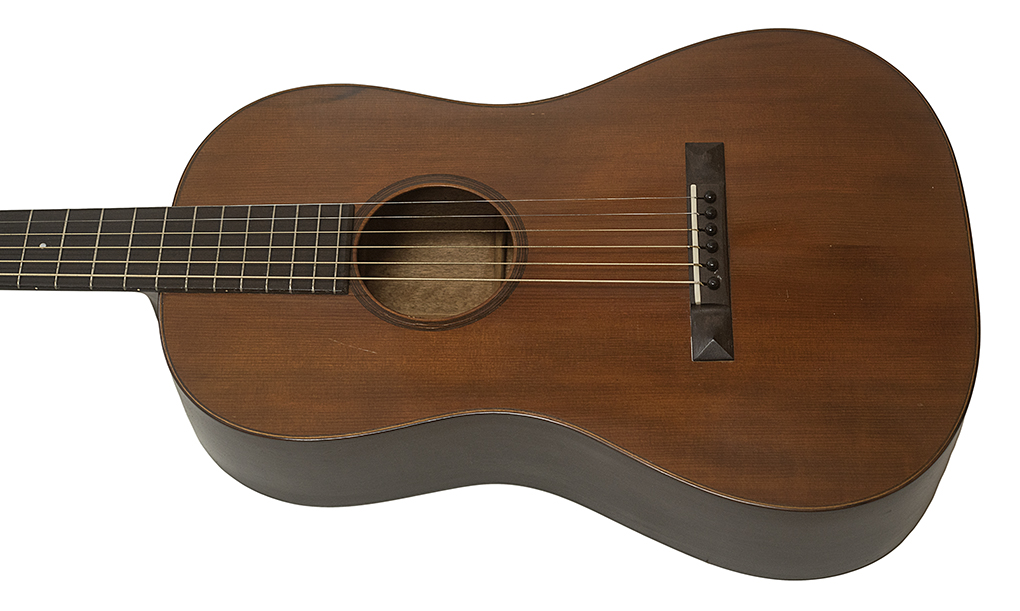
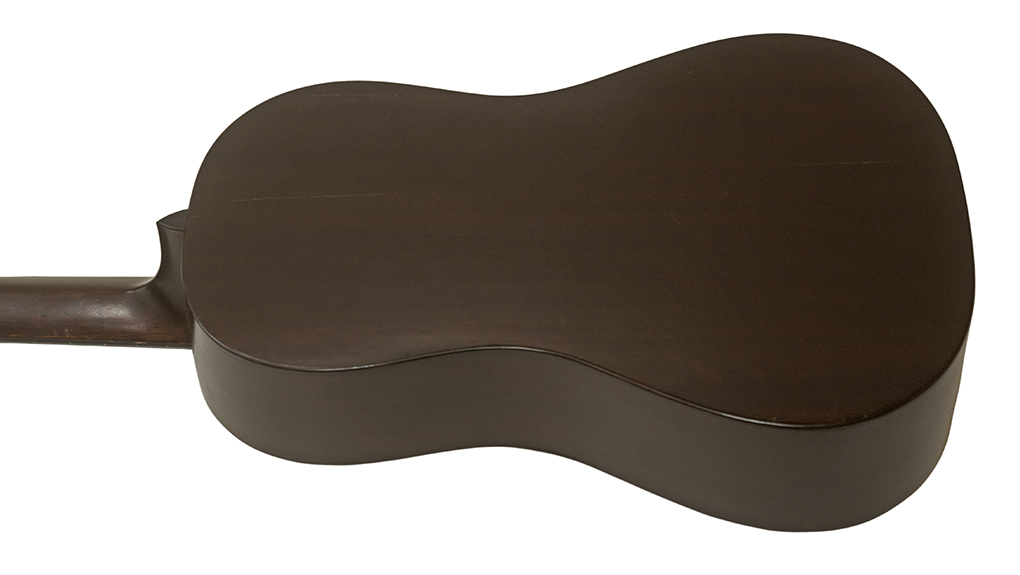
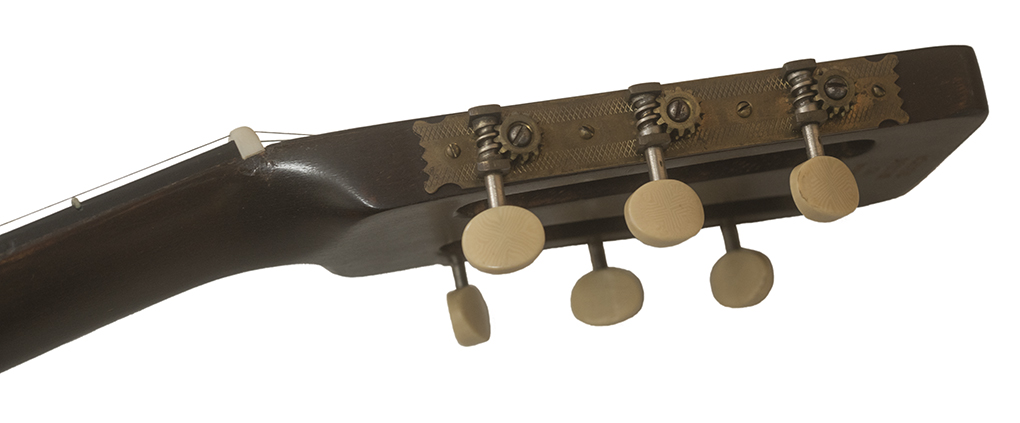
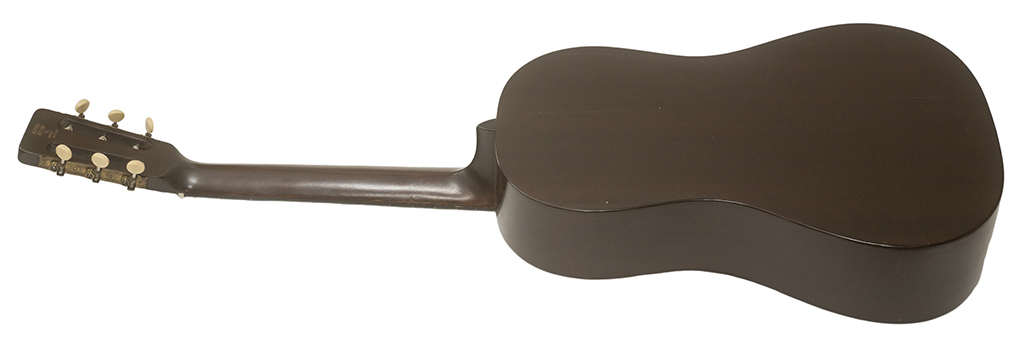
C.F. Martin 1916 Ditson Concert Model 22
The "Concert 2" was the last of the Standard or Concert models to be built.
This guitar is from the second batch, one of only 30 Style 22 built.
Serial Number 160
Shipped 12/30/16
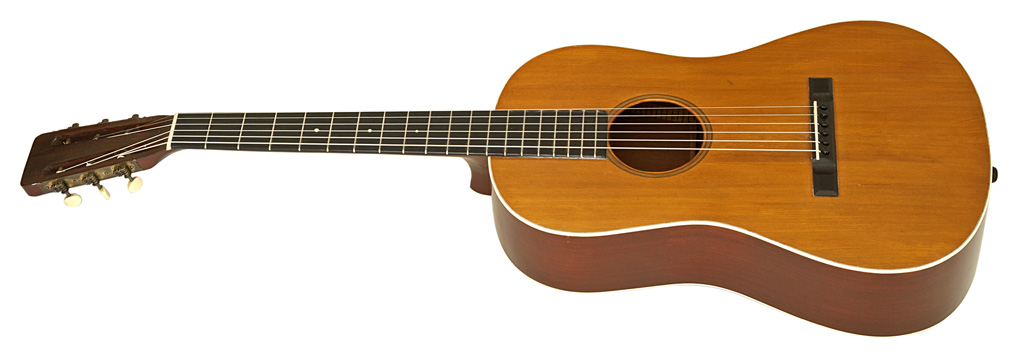
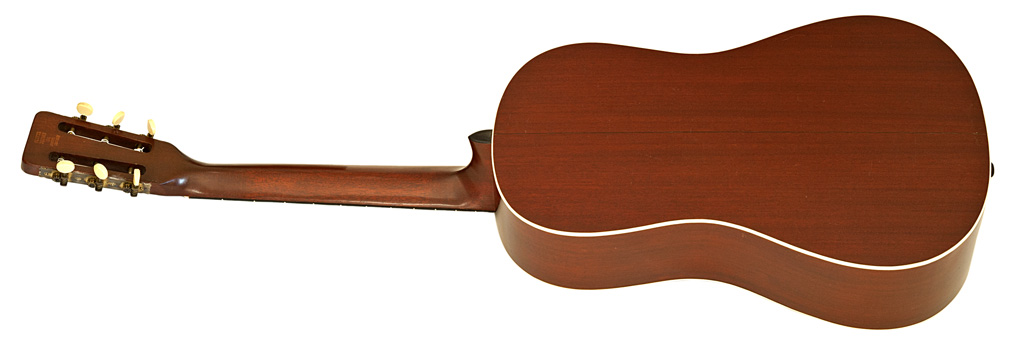
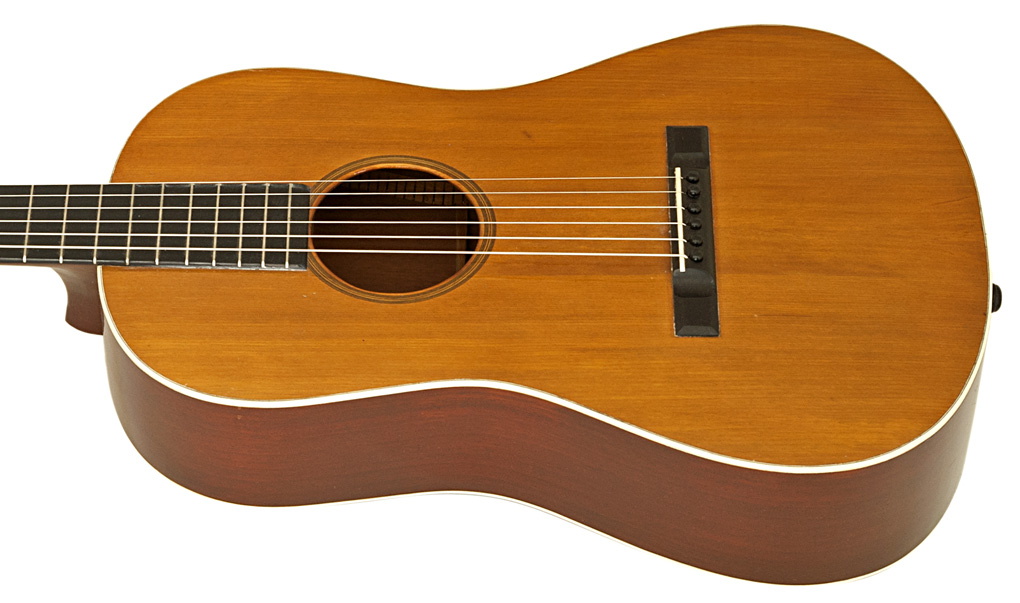
C.F. Martin 1920 Ditson Concert Model 33
From the fourth and final batch, one of 28 built.
Serial Number 557
Shipped 7/31/20
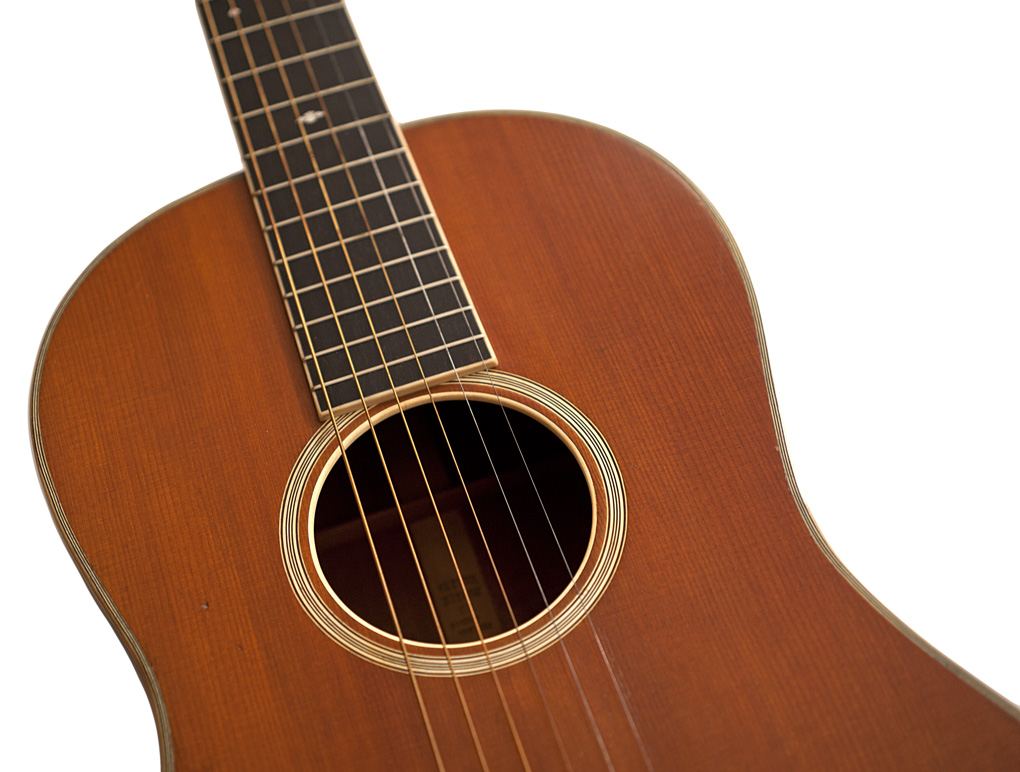
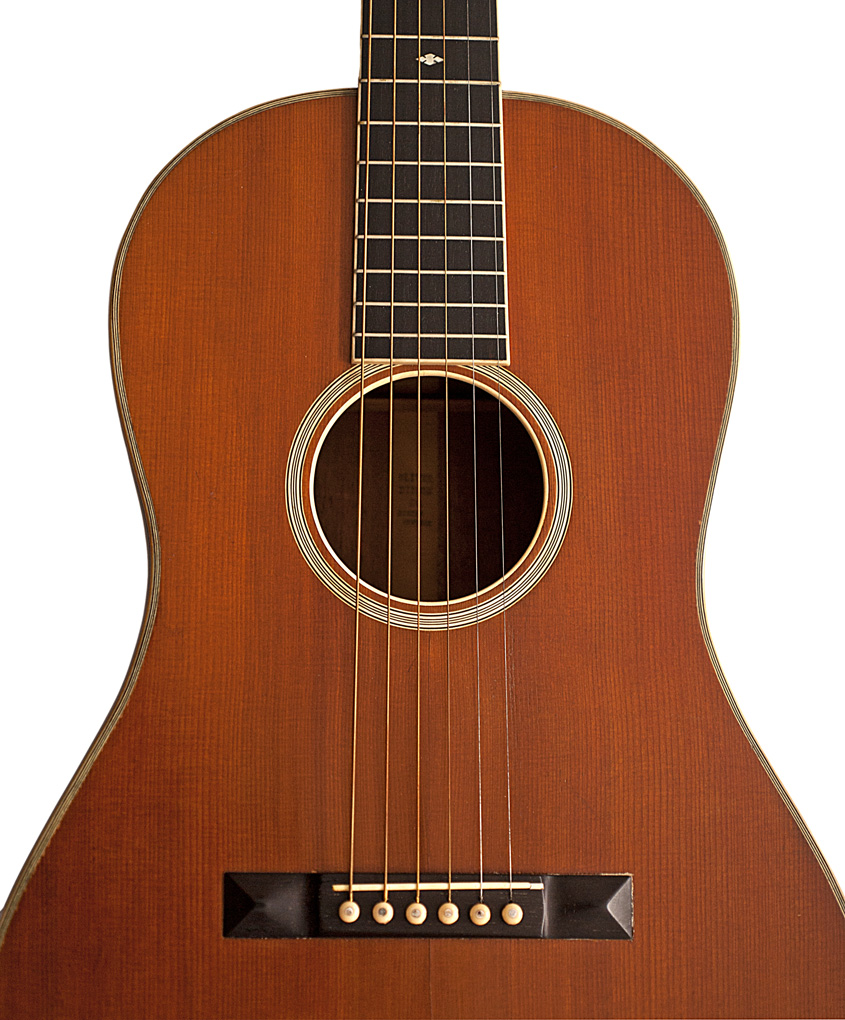
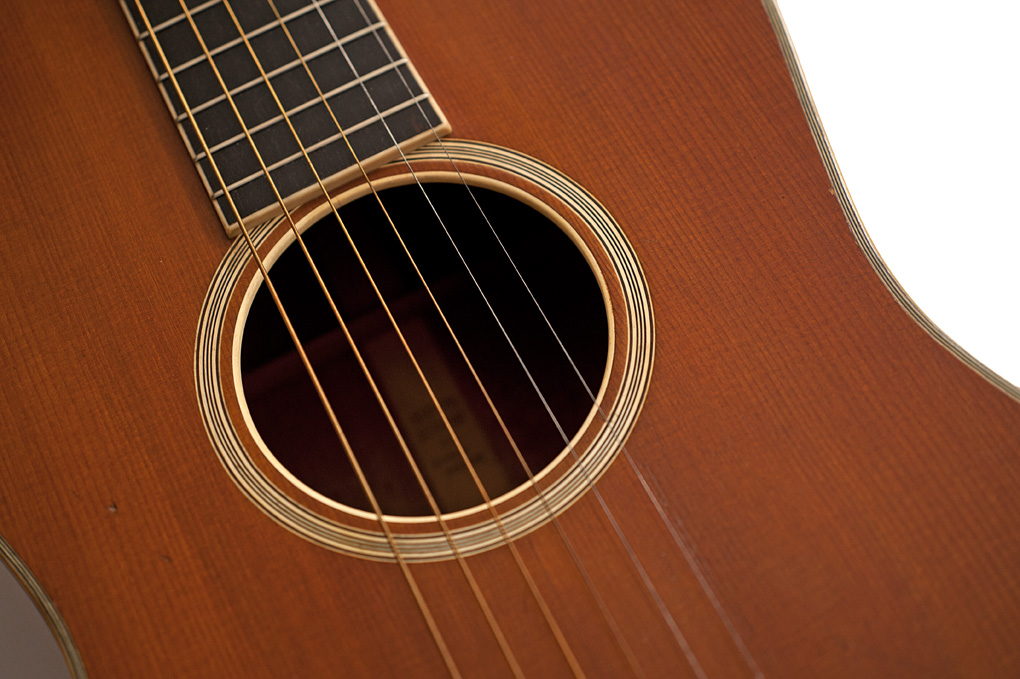
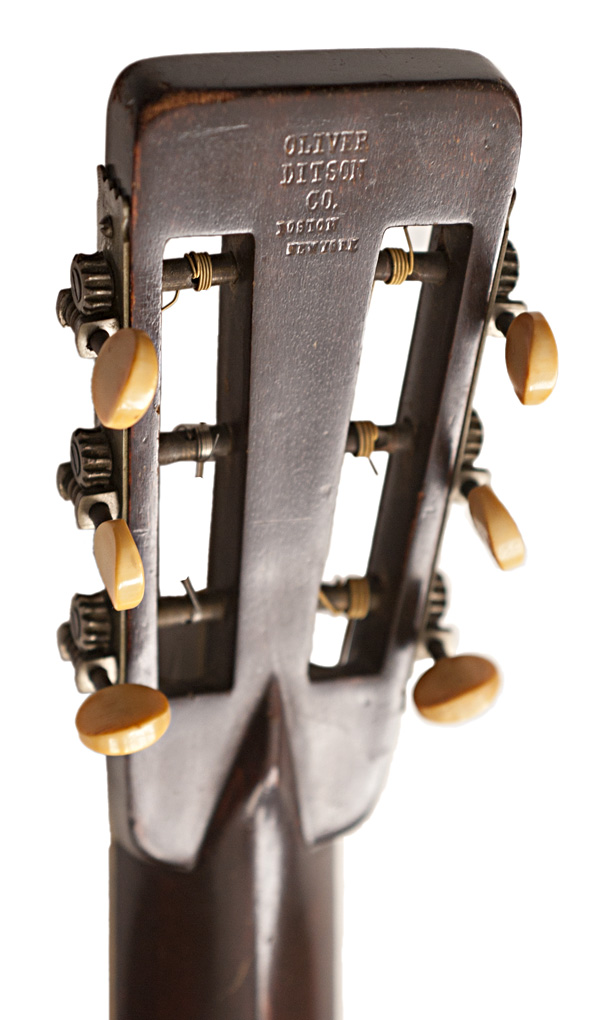
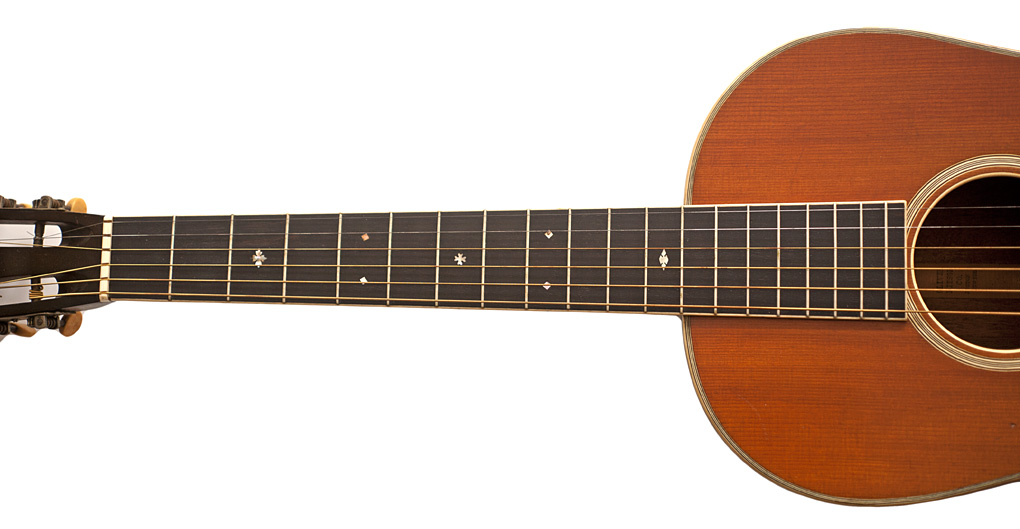
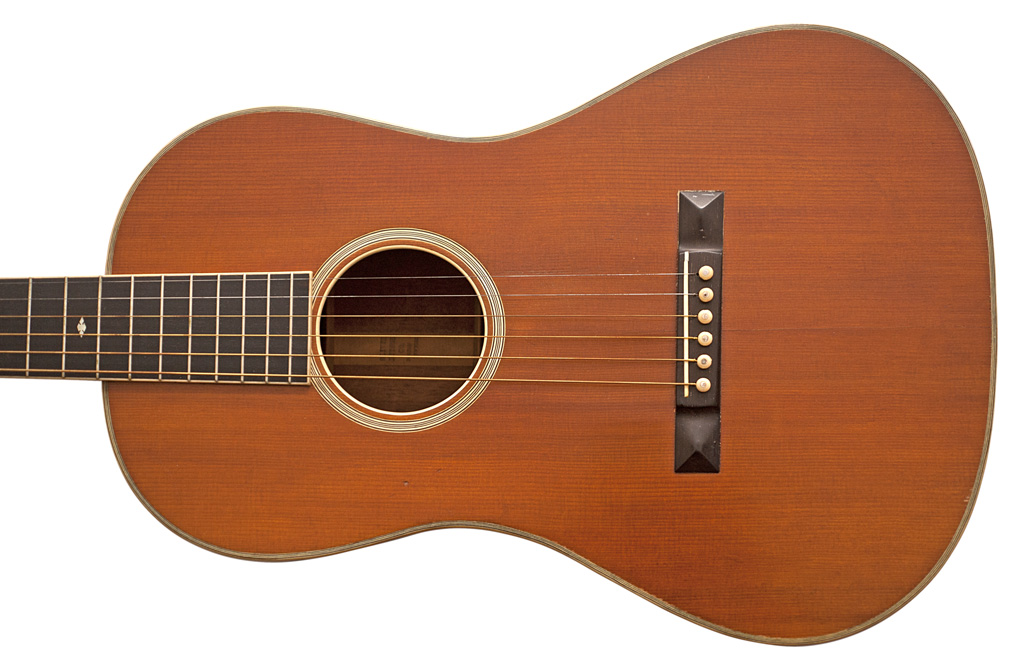
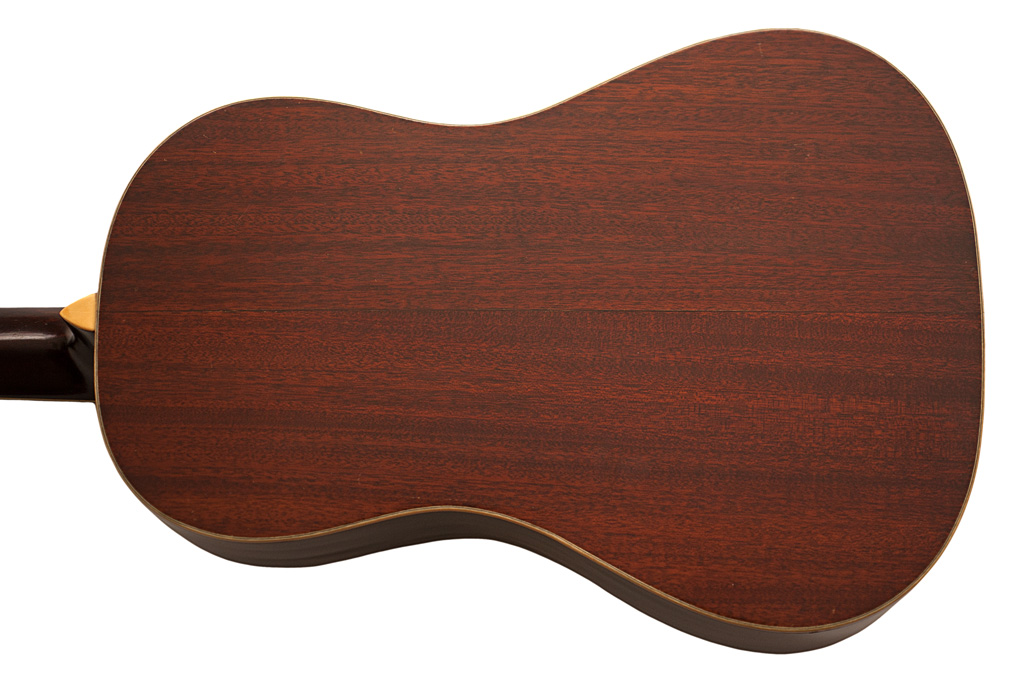
1919 Martin Ditson 3/4 Size Hawaiian Model 1 "Dreadnaught" Guitar
In early 1919, the Ditson Stores ordered six Hawaiian Dreadnaught shape guitars in a 3/4 size, with a short "terz" scale, a scale length used by C.F. Martin Sr. on some of his earliest guitars.
The proportions of the 3/4 size Hawaiian is closer to the "Extra Large" full size Dreadnaught.
Scale - 21 1/4"
Serial Number 13520
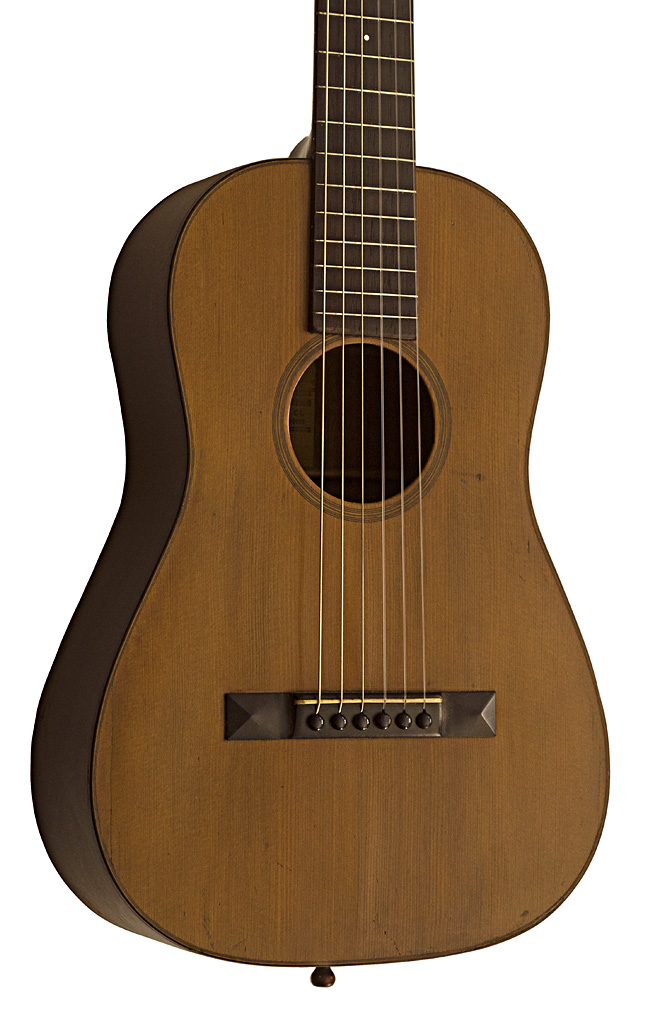
Ditson 3/4 Size
Width at the upper bout, 8 1/4"
Width at waist, 7 3/8"
Width at the lower bout, 11"
End to bridge, 4 7/16"
Bridge depth, 7/8"
Bridge to soundhole, 3 11/16"
Soundhole, 3 1/8"
Soundhole to 12th fret, 3 11/16"
Total length, 15 3/4"
2 lbs, 0.4 oz.
Ditson "Standard" Model 1
Width at the upper bout, 8 7/16"
Width at waist, 7 1/8"
Width at the lower bout, 11 1/8"
End to bridge, 4 9/16"
Bridge depth, 15/16"
Bridge to soundhole, 4 1/8"
Soundhole, 3 9/16"
Soundhole to 12th fret, 4 1/2"
Total length, 17 11/16"
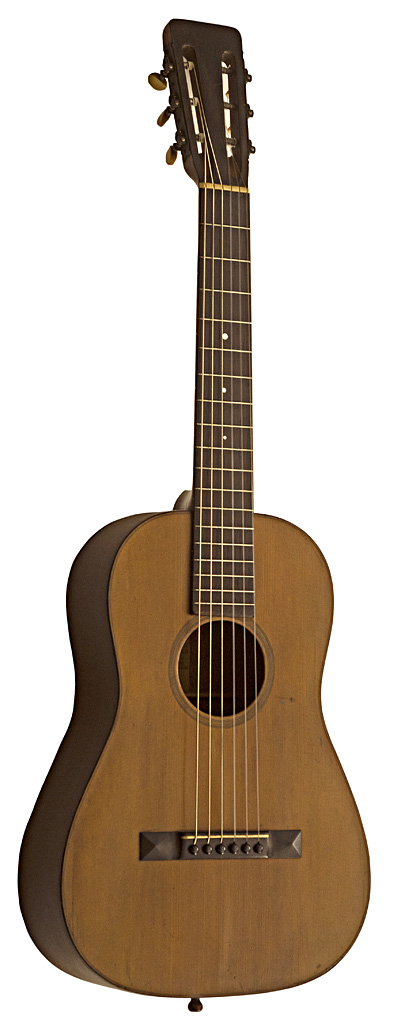
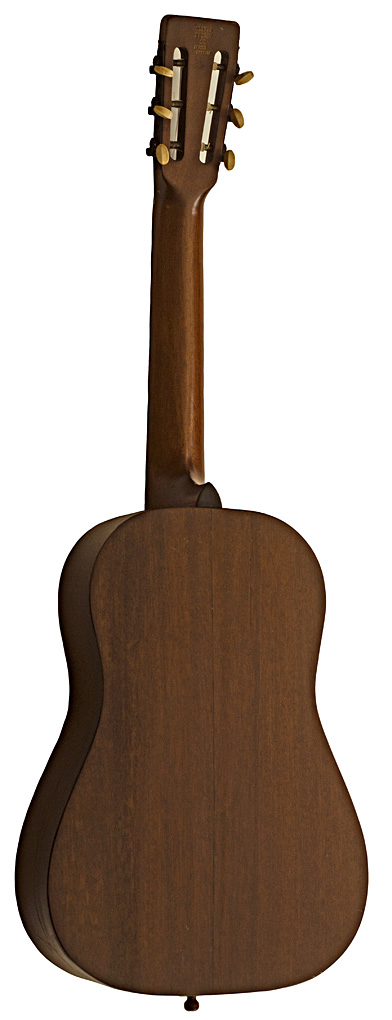
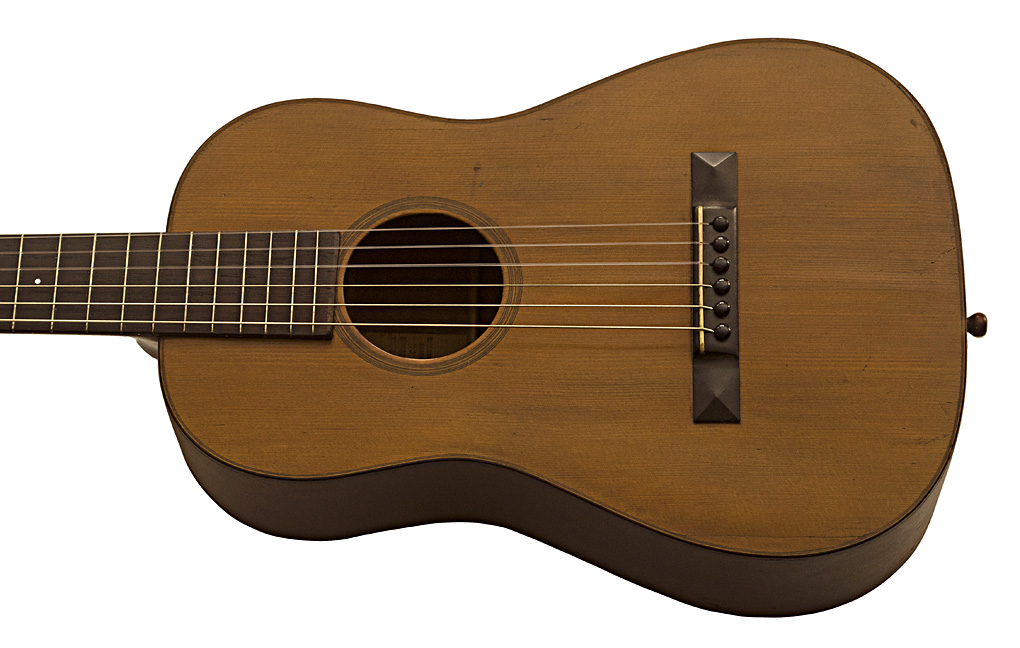
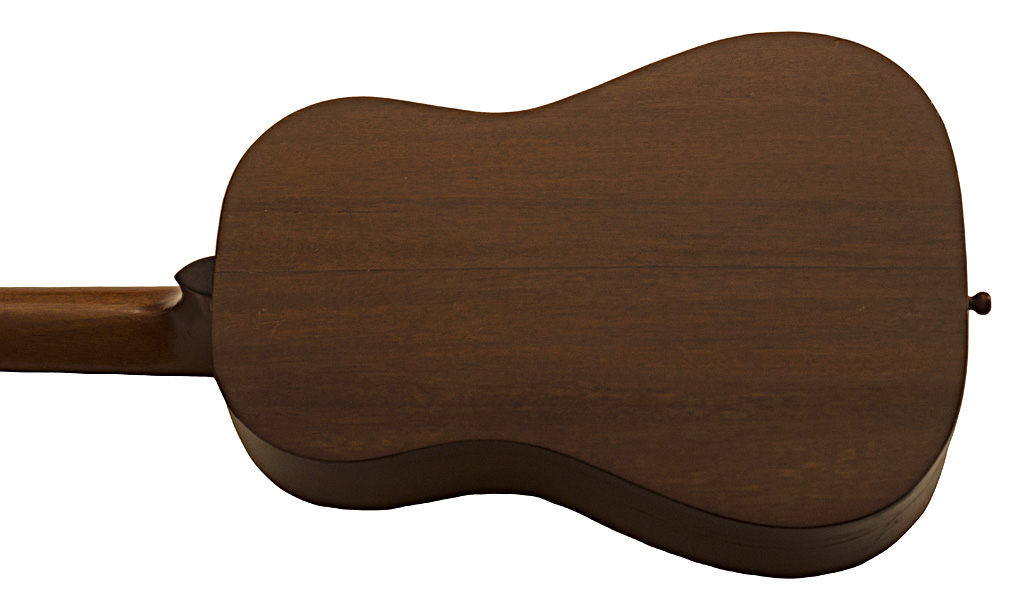
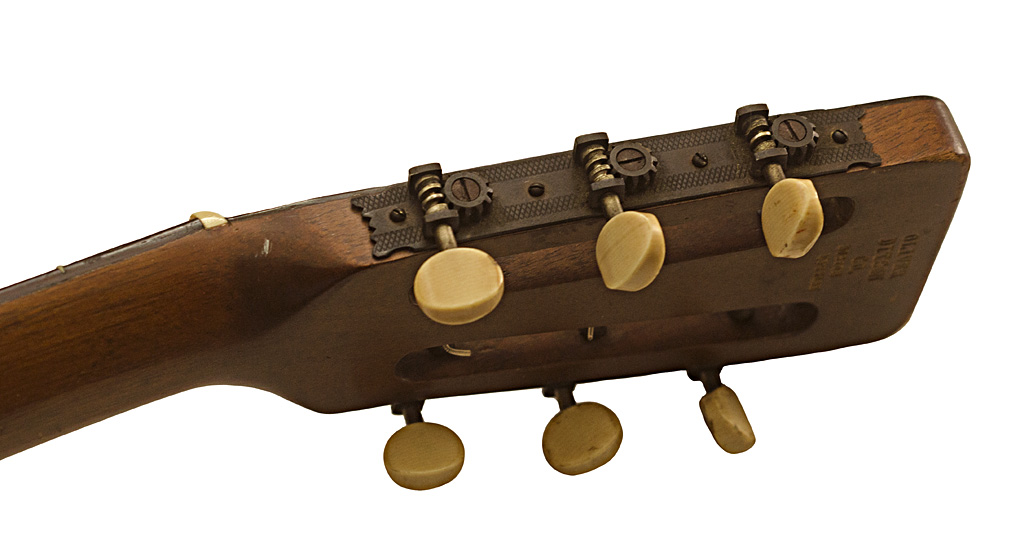
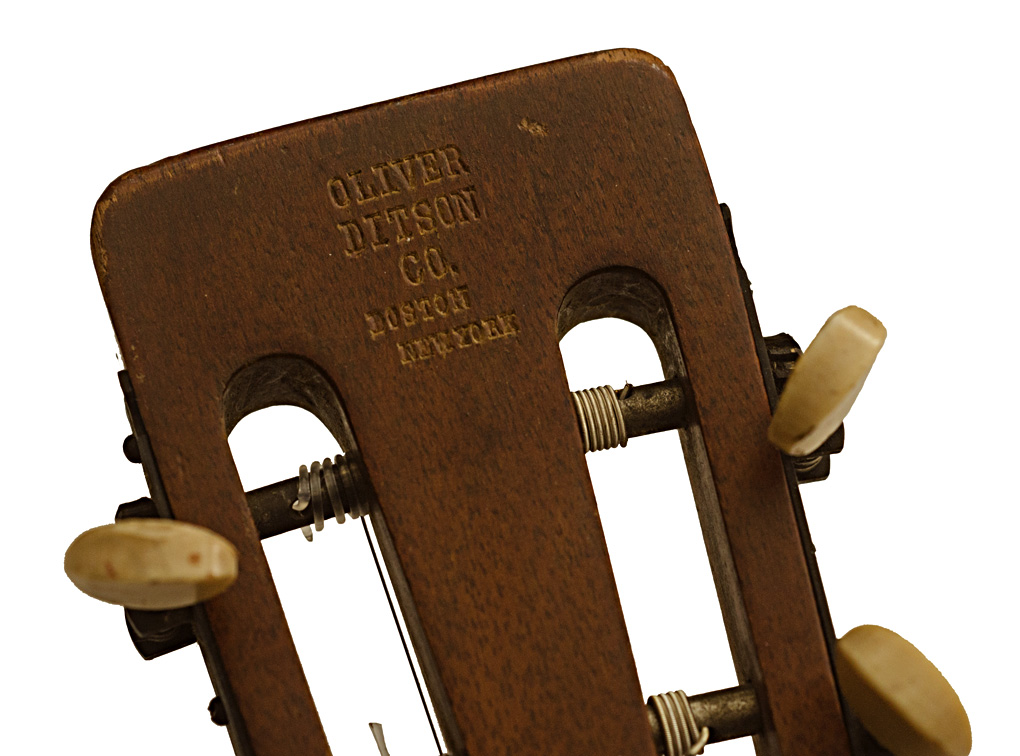
1916 Martin Ditson Model 3 Mahogany Dreadnaught Ukulele
In 1916, the Ditson Stores, one of Martin's largest customers, ordered the first Dreadnaught shaped guitars.
In the same year, Ditson also ordered ukuleles in all the various models Martin offered, with a Dreadnaught shape as well.
The Model 3 is one of Martin's most beautiful model ukes, with inlays and multiple stripes on the fretboard, and a design in Ivoroid on the lower face. The earliest ukuleles had simple ebony tuning pegs and an Ivoroid design on the headstock.
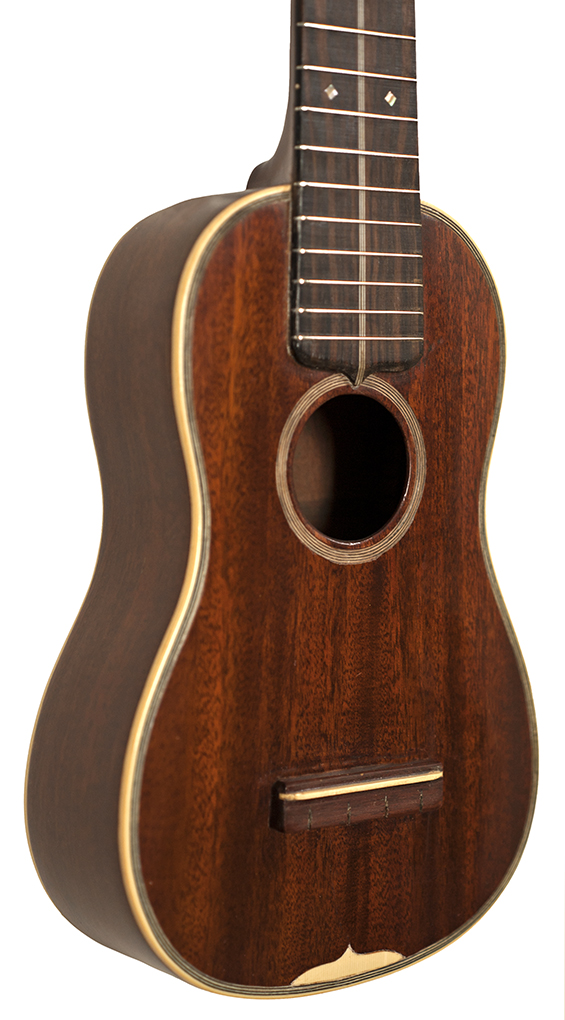
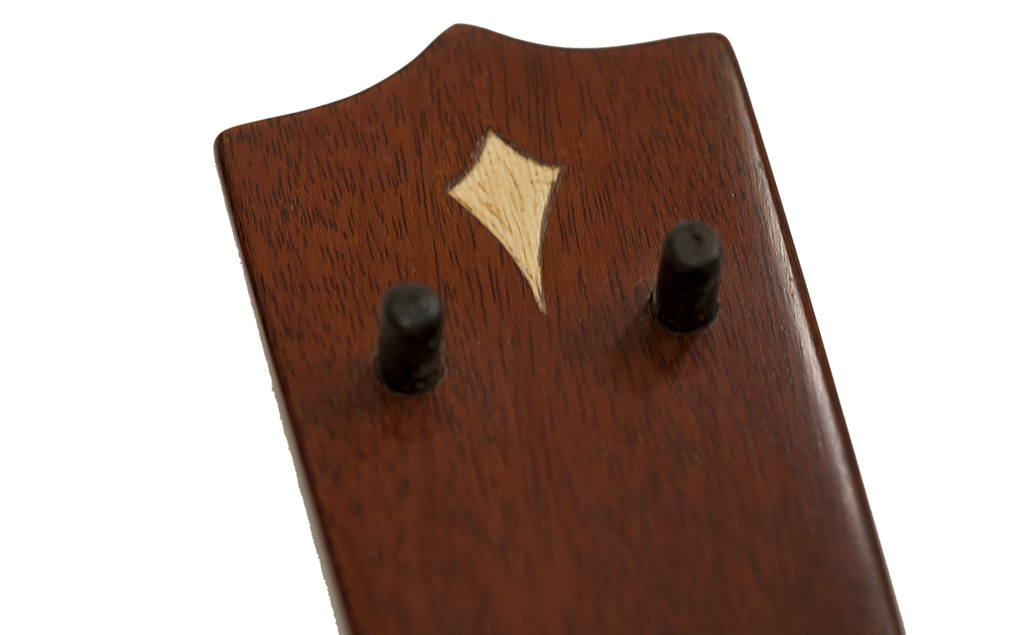
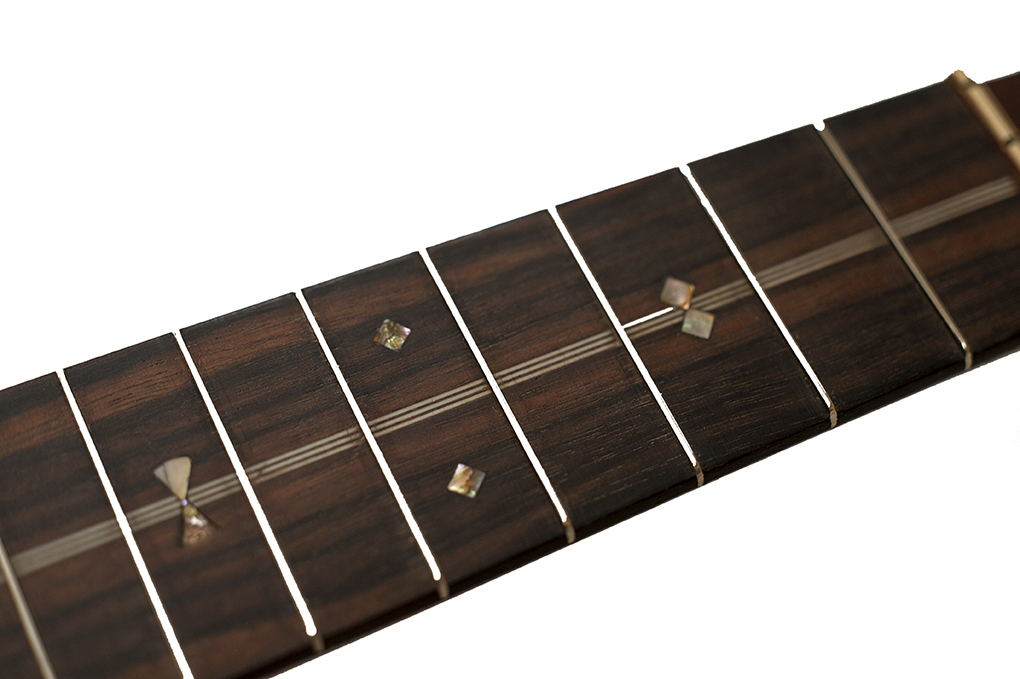
C.F. Martin 1918 000-42
In 1918, Martin made their first two Style 42 guitars in the relatively new and larger 000 size. While one of the two was a rather conventional Style 42 in the 000 size, this 000-42 was special ordered by the Ditson Company in 1918 in the style of Ditson's new Dreadnaught guitars, which were built for Hawaiian style playing with steel strings. That makes this guitar a rare example of an extremely early 000 size Martin built for steel strings, as well as a rare example of a Martin built for steel strings with an ivory pyramid style bridge. As was true of the early Martin Dreadnaught, and all of Martin's early Hawaiian steel string guitars built for both the Ditson Company and The Southern California Music Company, this guitar was built with fan braces. This guitar was also special ordered with a cloud shaped pickguard inlaid into the top.

C.F. Martin 1924 Ditson "Extra Large" 111
The largest of the three sizes of guitars made by Martin for the Ditson Stores was first known as the "Extra Large"
This style later took on the name "Dreadnaught" after the Extra Large class of battleships, the spelling later becoming "Dreadnought" with an "O".
Early Ditson 111 were fan braced. This Ditson 111 was the first to be X-braced.
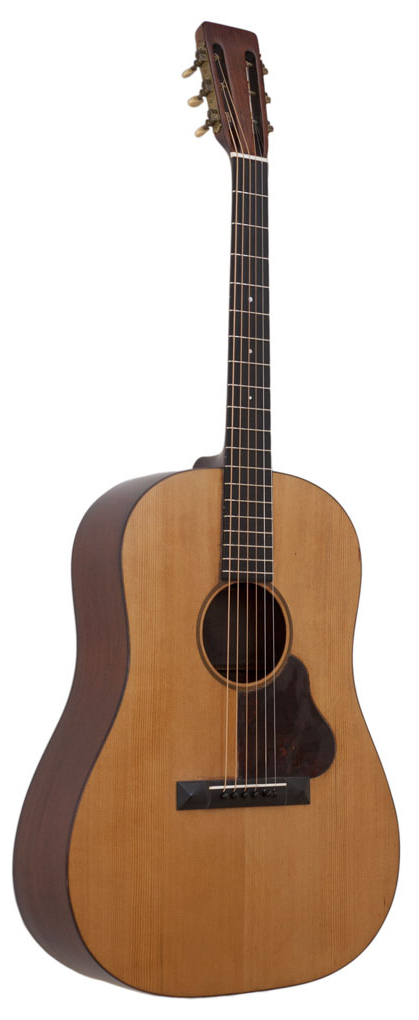
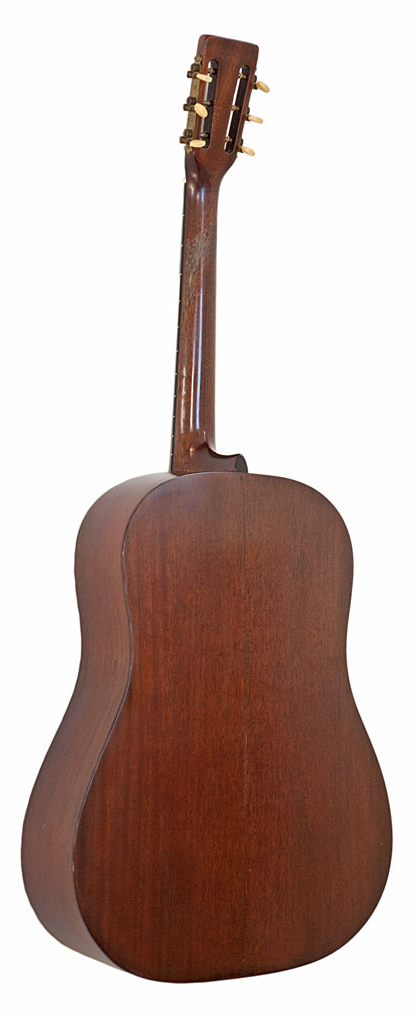
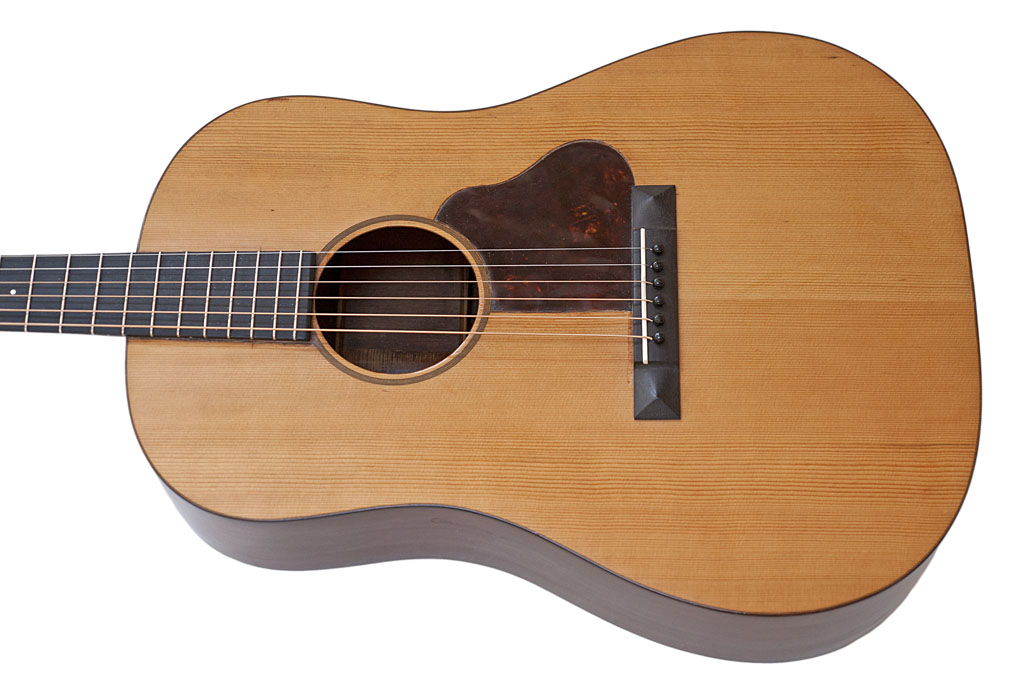
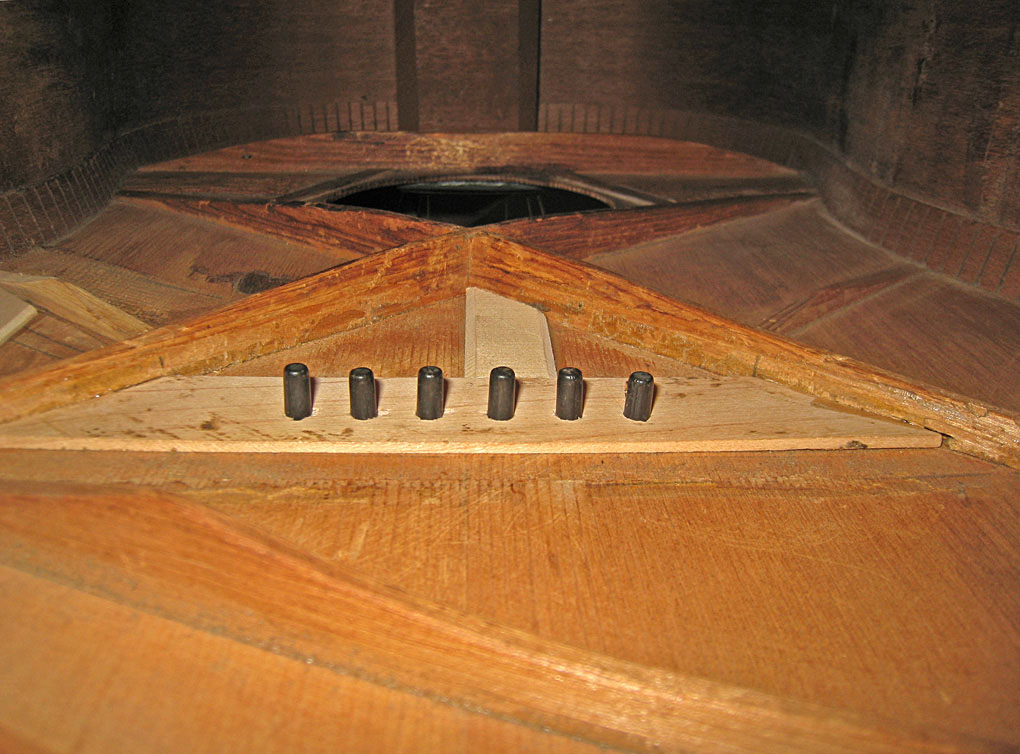
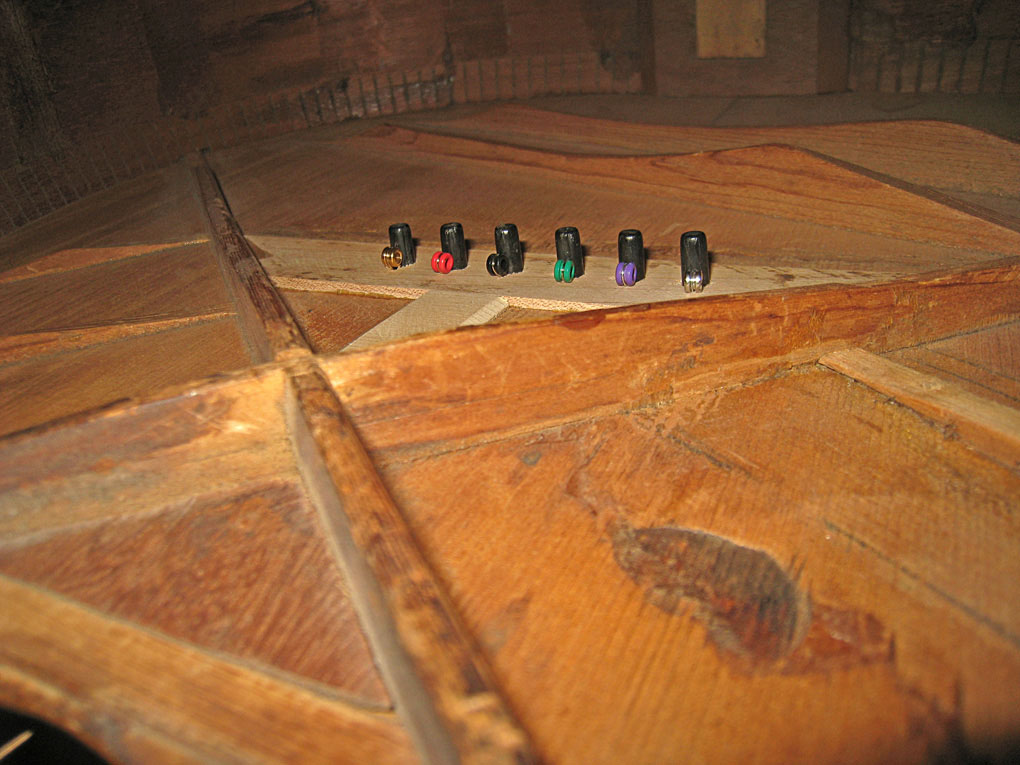
C.F. Martin/Ditson 1926 2-17
The Ditson Stores also sold many standard Martin models, but with the Ditson stamp replacing the Martin stamp on the headstock and interior center strip, such as on this model 2-17:
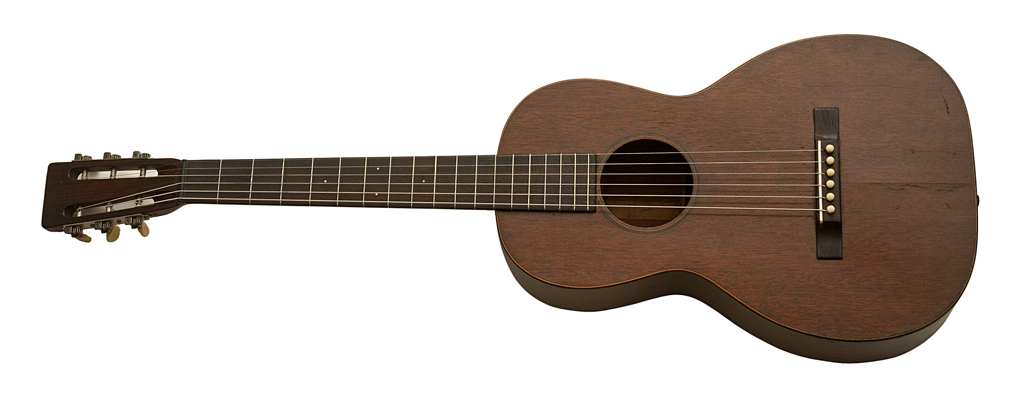
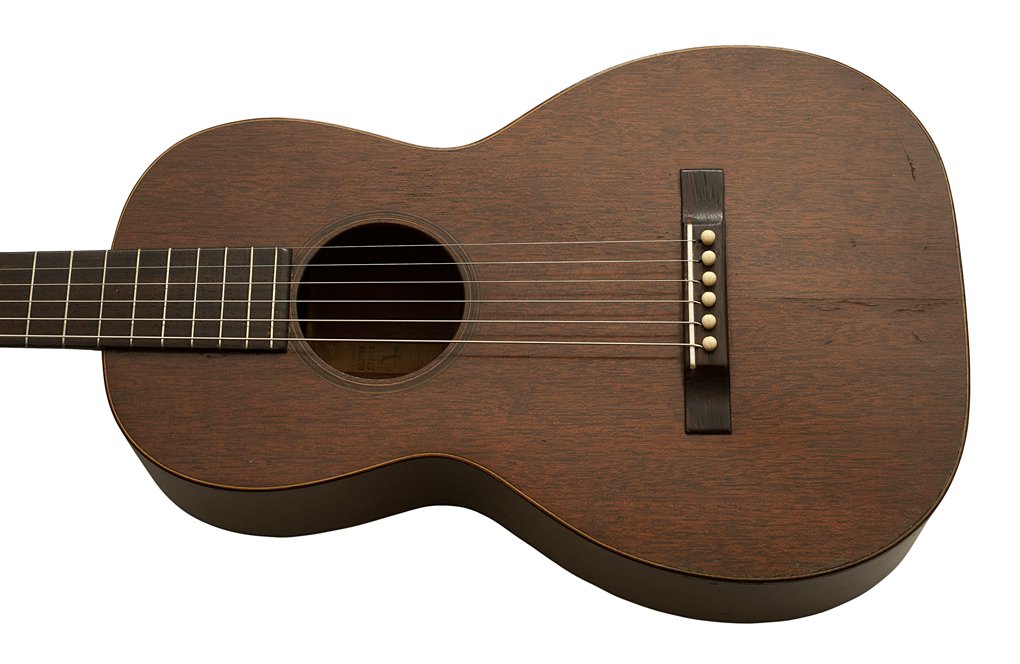
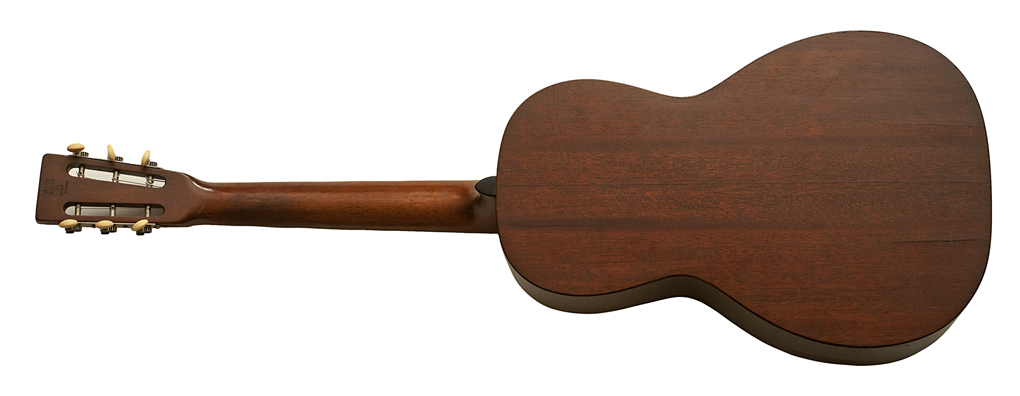
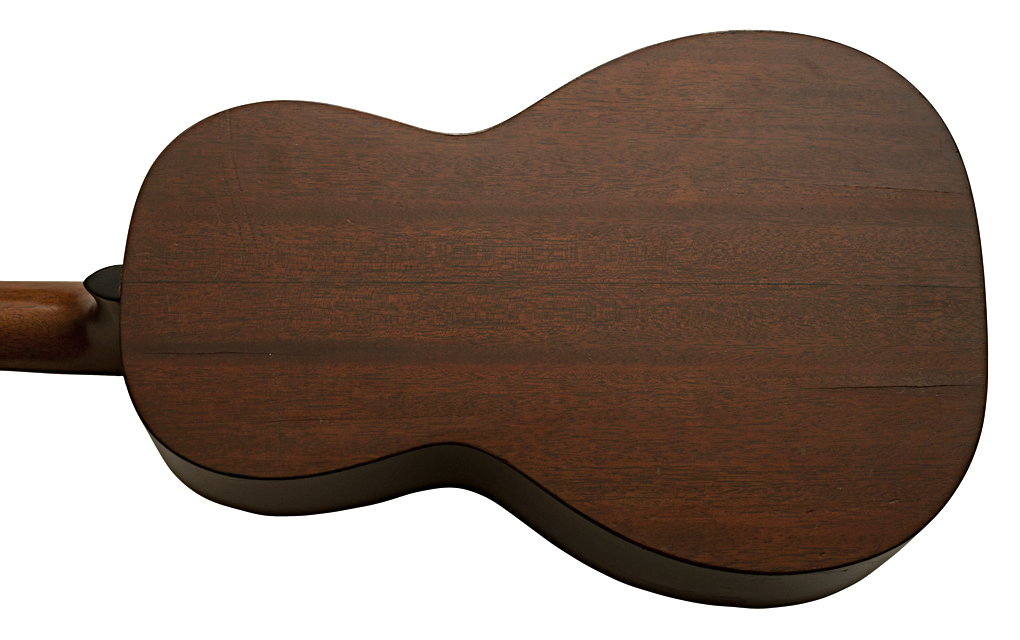
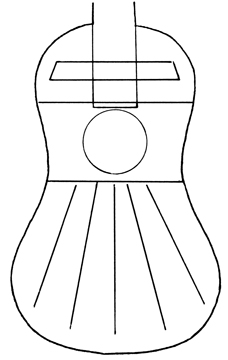
Click on this image to download a full size 1:1 diagram of my 1916 Ditson 2 #144.
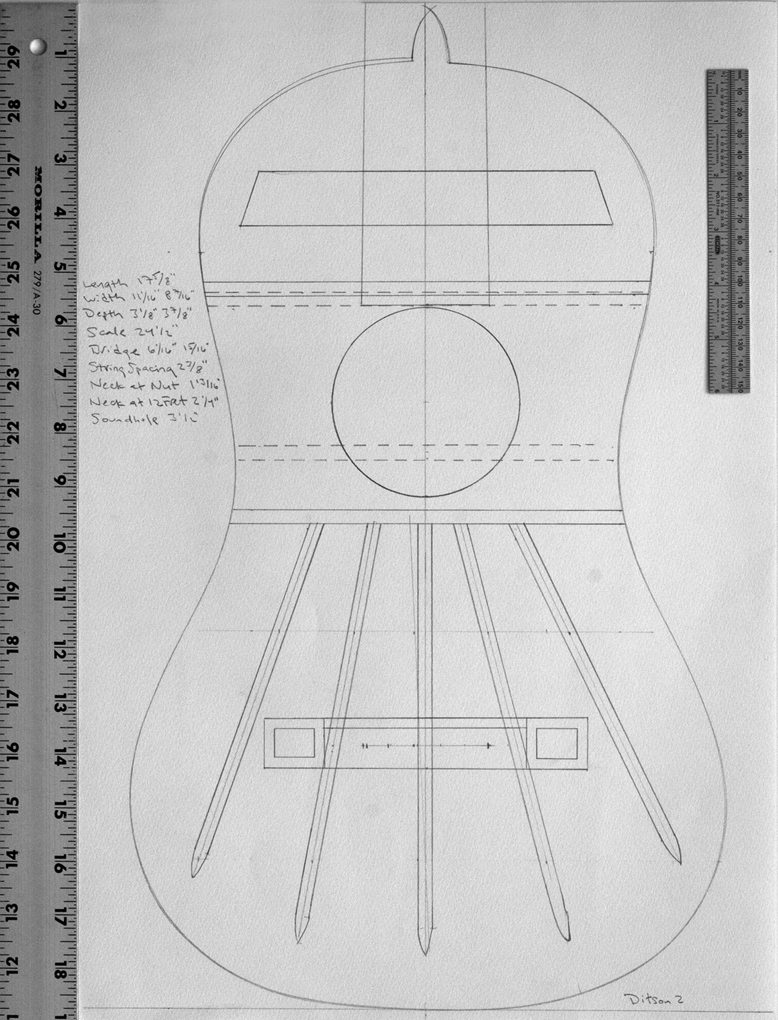
C.F. Martin 1934 00-40H
One of 12 made in 1934. Excellent original condition aside from conversion from original Hawaiian style. Originally with high nut and flush bar frets.
Abalone pearl border inlaid on the top of the guitar and into the soundhole ring. 45 style wood marquetry in backstripe. Back and sides of Brazilian Rosewood, with top of red spruce, and fingerboard in ebony with abolone inlays.
The Style 40 was similar to the Style 40 without pearl surrounding the fretboard extension.
Produced from 1928 to 1939, a total of 244, the largest batches, with pyramid bridges, made in the earliest years.
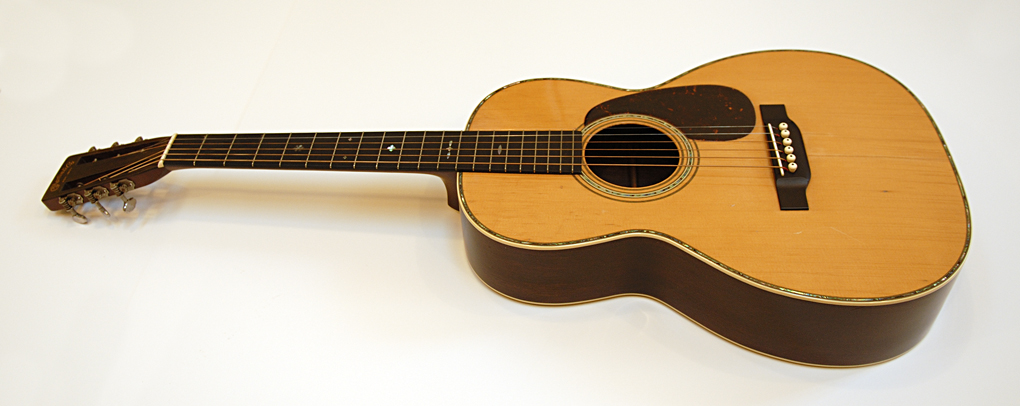
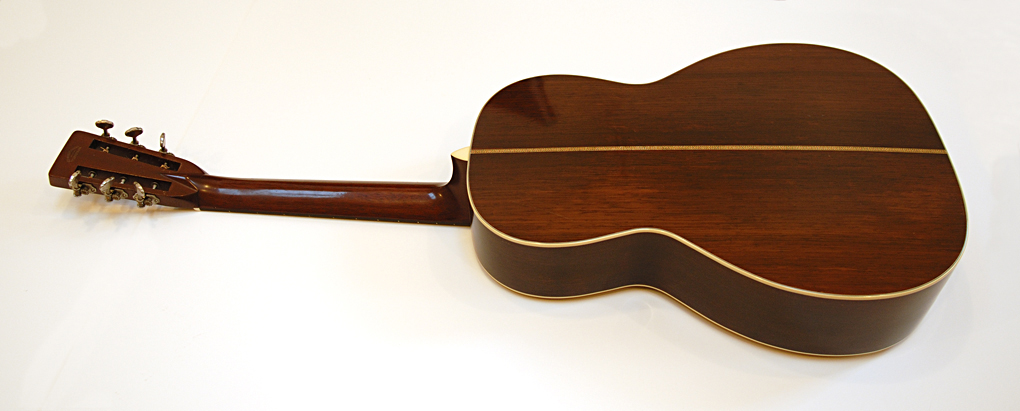
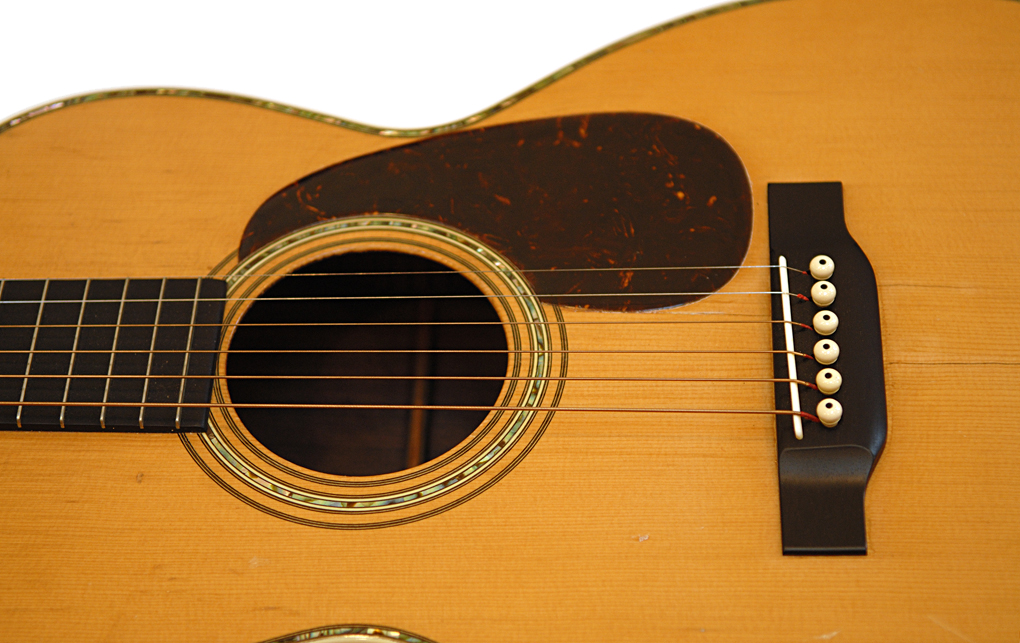
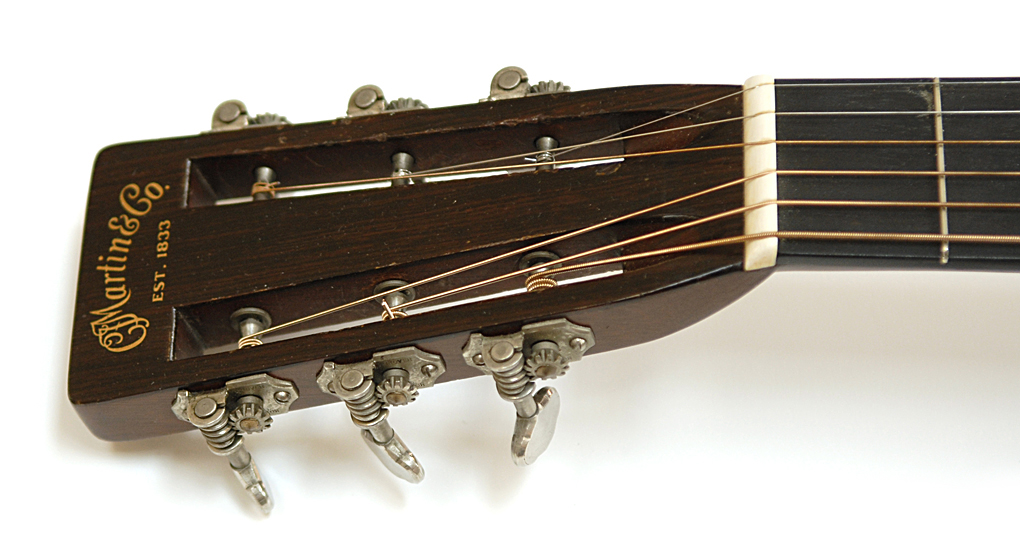
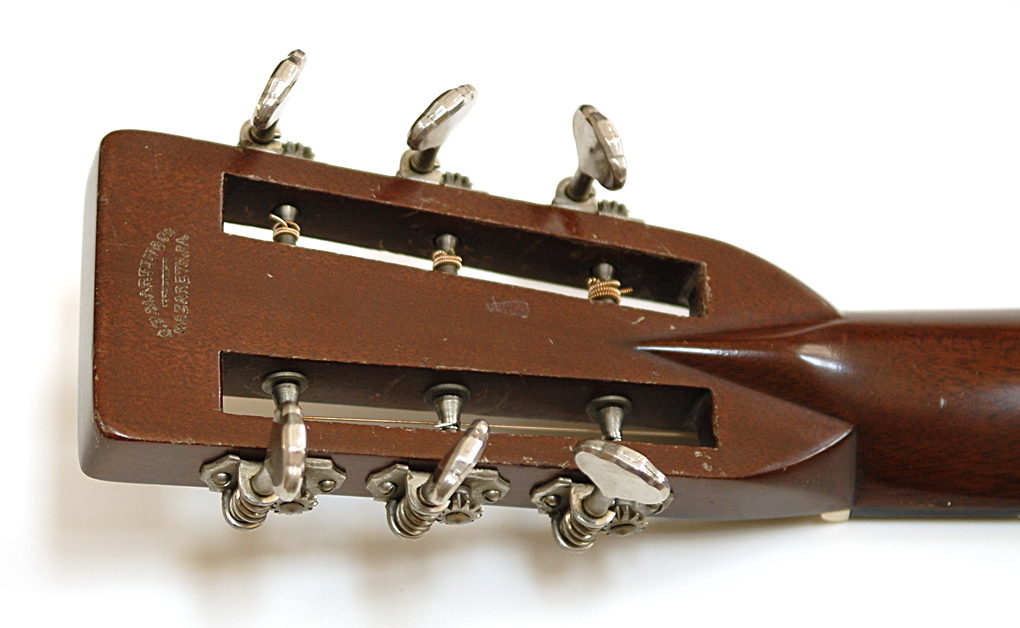
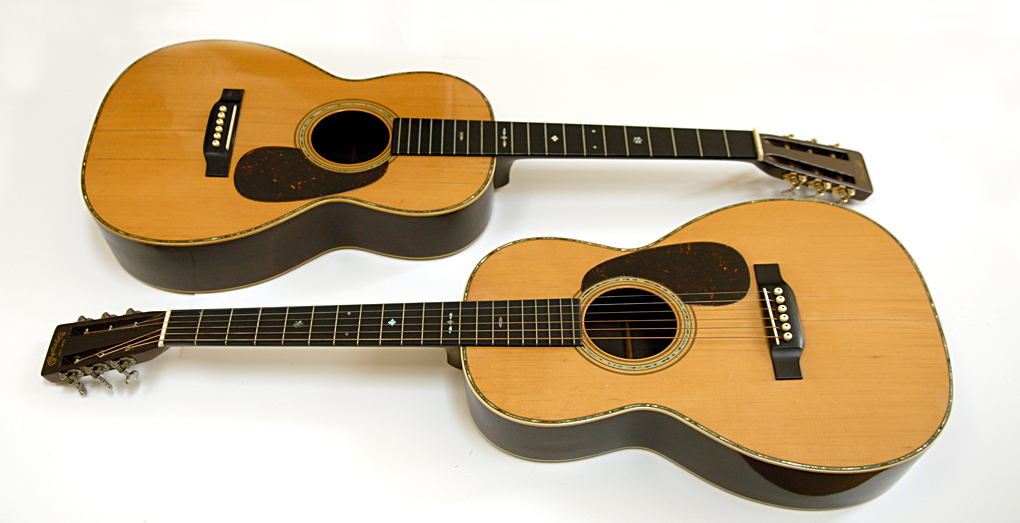
56430 with 56433
C.F. Martin 1941 00-18H
Similar in build to the 00-40H, but in Style 18, with mahogany back and sides. Shaded top standard.
With two 00-18H made in 1935, the majority of this model were built in 1937 (128) and 1938 (75), with additional batches of 25 each produced in 1940 and 1941.
This instrument was stamped on May 12, 1941
Excellent original condition aside from conversion from original Hawaiian style.
Like the other "H" model, the 00-40H, this guitar was built with a high nut and flush frets, as opposed to the "K" models supplied with a nut extender.
Serial number 77700
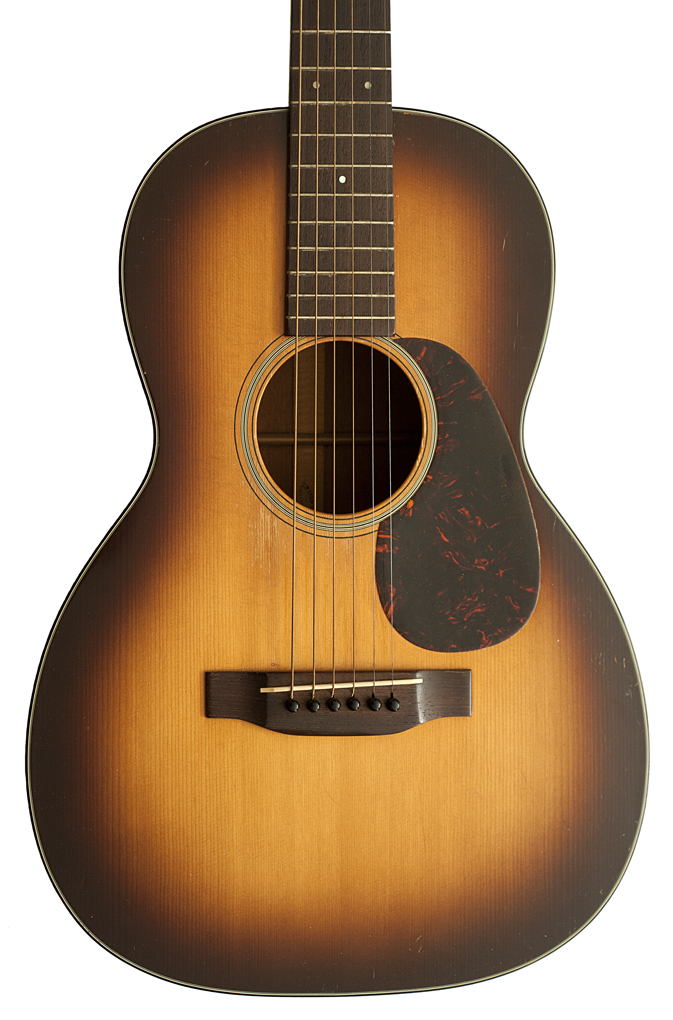
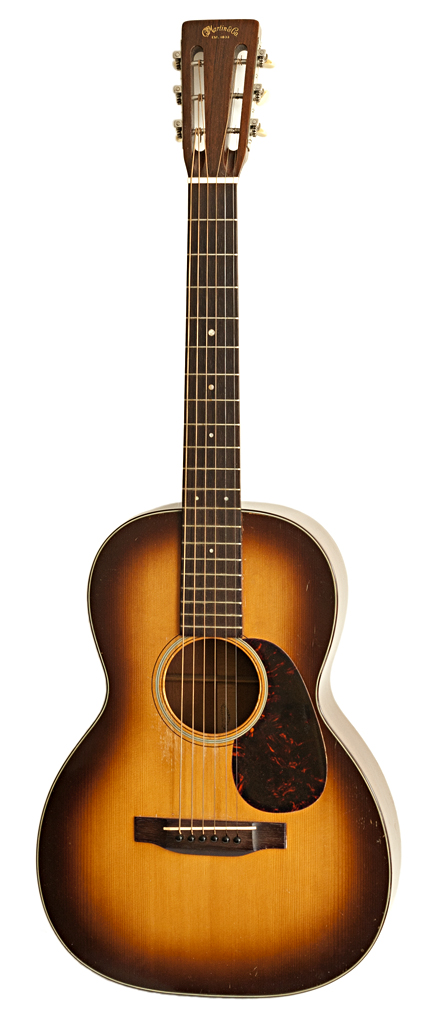
This model was supplied with early Waverly tuners after other models had moved to later "bell end" Waverlys.
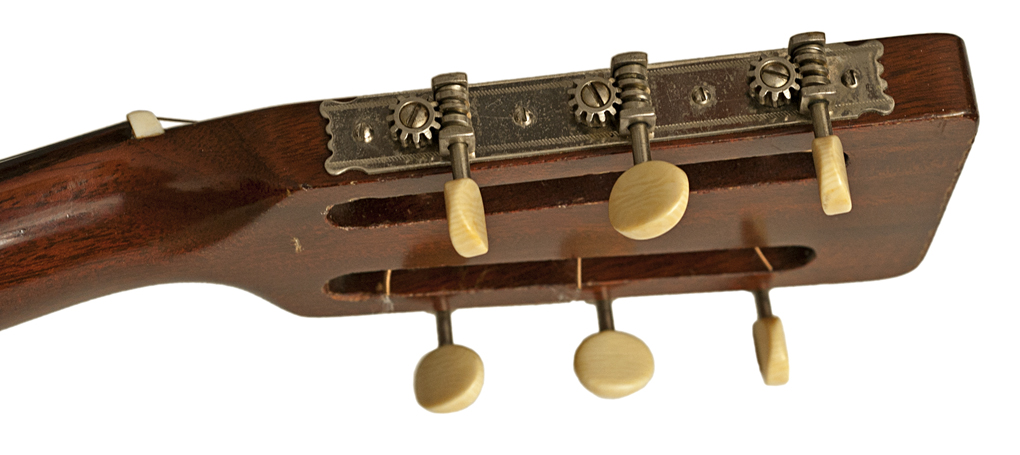
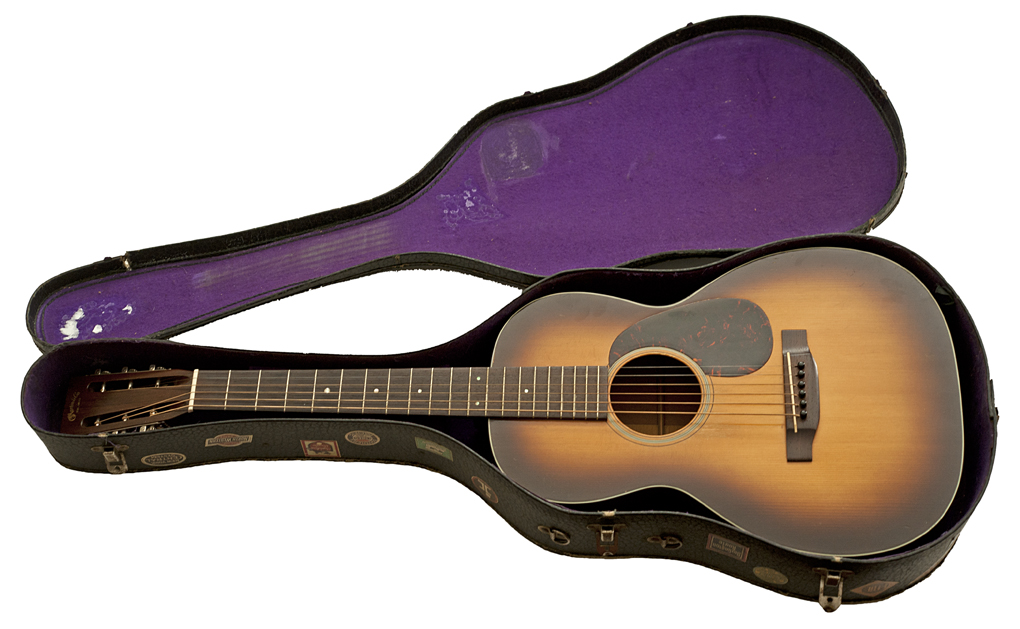
earlymartin.com
To See Robert Corwin's Classic Photography of Folk and Roots Musicians, visit:
Steel String Martin Hawaiian Guitars

In July of 1916, with Hawaiian music all the rage following it's introduction to a large portion of the American public at the Panama Pacific Exposition in Chicago the previous year, the C. F. Martin Co. shipped six samples each of Hawaiian koa wood guitars with appointments generally similar to Martin's styles 0-18, 0-21, and 00-28 to the Southern California Music Company of Los Angeles, a chain of Southern California music stores, and one of Martin's largest accounts.
SoCal provided Martin with the koa wood from Hawaii, and asked that the trim on these guitars, designed for playing in the Hawaiian style, be as close as possible to those of SoCal's popular ukuleles.
To appeal to the Hawaiian market, SoCal asked that the Martin stamp be replaced with the Southern California Music Company stamp, and affixed decals on the headstocks bearing the name "M. Nunes & Sons, Hawaii" and labels inside with either the name "M. Nunes & Sons" or "Rolando". These early samples had koa wood back and sides and tinted spruce tops, but after seeing the samples, SoCal decided to offer all koa guitars, and to market the three models as the 1350, 1400, and 1500. The first of the new SoCal models was shipped in November of 1916.
These guitars, and those Hawaiian guitars designed at about the same time for the Oliver Ditson Company, were the first Martins to be built for steel strings. And while Martin had previously used fan bracing only for their gut string guitars in the Spanish Style, and had since switched it's production to X-bracing, Martin curiously decided to build these early heavier steel string guitars with braces in the shape of a fan. The Model 1500, however, for reasons we may never know, has X bracing.
"M. Nunes & Sons" and "Rolando" Models 1350, 1400 and 1500

1916 Model 1400 #28, 1919 Model 1350 #14001, 1917 Model 1500 #181, and 1916 Spruce Top Sample with no serial number
The guitars designed for SoCal had serial numbers of their own. The Model 1400 shown below, from the very first batch, is number 28. The numbered guitars started with number 19, allowing for the eighteen samples which were sent without serial numbers.
A total of 261 guitars were produced with SoCal serial numbers.
By June, 1918, instruments made for Southern California Music had standard Martin serial numbers.
The later Southern California Music Company Hawaiians have trim similar to a regular Martin, and Martin serial numbers. While earlier SoCals generally bear the Southern California Music Company name on the headstock, later examples have either both the SoCal and Martin names or the Martin name only.
The early Model 1350 and 1500 examples I've seen have the "Rolando Koa Wood Guitars" label, while the sample 1350 and early 1400 have the "M. Nunes & Sons, Royal Hawaiians" label inside. The later examples have the Martin stamp inside.
These "Hawaiian" Martins, from the time they were first made in the teens, were catalogued with "steel strings and nut adjuster for Hawaiian playing. Suitable for regular playing with nut adjuster removed." Only beginning in 1925 were these guitars made specifically for Hawaiian playing, with high nuts and flush frets. While the early "K" models, such as the 0-18K and 0-28K, began life with regular frets and nut adjusters, the "H" models, including the 00-18H and 00-40-H, were introduced after the change to flush frets and high strings.
C.F. Martin/Southern California Music Company Sample Model 1350
This guitar is one of the six original samples with spruce tops which were requested of Martin by the Southern California Music Company, in a style similar to the Martin 0-18 but suited for playing in the Hawaiian style, with steel strings and fan bracing, similar to the Hawaiian guitars first shipped 3 1/2 months earlier to the Ditson Company.
The sample Nunes also has the same single ring rosette seen on Ditsons and guitars made by Martin for several other firms, and a tinted spruce top similar to those seen on many Ditsons.
No serial number.
These samples have no serial number, while the regular production appears to begin with serial number 19, accounting for the six samples of each model.
Shipped July 10, 1916

These early guitars were made with Koa wood supplied by SoCal.

This sample instrument has the "M. Nunes, Hawaii" decal on the headstock of the guitar.

This sample has neither the Southern California nor the Martin stamp on the back of the headstock, however. There is neither a Martin nor SoCal stamp on the back strip inside the guitar.

C.F. Martin/Southern California Music Company Model 1350
1916 Southern California Music Company Model 1350
Fan style braces similar to a Ditson dreadnaught.
Stamped inside, "C.F. Martin & Co., Nazareth, PA"
Stamped on back of headstock "Southern California Music Company, Los Angeles"
Early examples have the "Rolando" label
Both the initial samples for the Model 1350 and the earlier 1350 with the Rolando label have a single ring rosette like many of the guitars Martin made for others such as Ditson, Wurlitzer, and Foden, but the later examples with Martin serial numbers have a standard Martin three ring rosette.
138 of the Style 1350 were produced with SoCal serial numbers.
Rolando 1350
SoCal serial number 95

This early example has a Rolando label and a Hawaiian decal on the headstock without the Nunes name.
The new edition of the Longworth book (in a section to which I otherwise contributed) states that "The Rolando label was used on later Style 18K and 28K models made for Southern California Music Company. Unlike earlier koa models made for this firm, those with the Rolando label are identical to Martins and have the Martin stamp on the interior with regular serial numbers." This example as well as the early Style 1500 shown below illustrate that the Rolando label appeared quite a bit earlier than previously thought.
I first thought that the different labels related to the different styles. I now see that the early sample Style 1350 and Style 1400 number 28 have the "Nunes" label while Style 1350 number 95 and Style 1500 number 181 have the "Rolando" label, so it is entirely possible that the label was replaced sometime between the production of numbers 28 and 95.

This example has a Martin headstock stamp.

C.F. Martin/Southern California Music Company Model 1350
1919 Southern California Music Company Model 1350
Fan style braces similar to a Ditson dreadnaught.
Stamped inside, "C.F. Martin & Co., Nazareth, PA"
Stamped on back of headstock "Southern California Music Company, Los Angeles"
Both the initial samples for the Model 1350 and the earlier 1350 with the Rolando label have a single ring rosette like some of the guitars Martin made for others such as Ditson, Wurlitzer, and Foden, but the later examples with Martin serial numbers have a standard Martin three ring rosette.
Serial numbers 14001 and 14003.
#14001


#14003






In 1919, Martin began selling their less expensive guitars with rounded slots in the headstock. Previously, all Martins had square slots, a process that took extra time which was in short supply as as Martin's production was doubling yearly. Curiously, these two guitars, two serial numbers away and both from the same batch, have different style headstocks, which is not surprising if you follow Martin history. No doubt, the necks were made first, and different styles appeared when the worker reached into the pile when it came time to attach a neck.

14003 and 14001
By 1919, the Style 1350 would be nearly indistinguishable from the Hawaiian Model 0-18K that would become a standard part of the Martin line.
C.F. Martin 1927 0-18K
Serial number 33958.






C.F. Martin/Southern California Music Company Model 1400
1916 Southern California Music Company "M. Nunes & Sons." Model 1400
This beautiful variation of a style 21 guitar made for the Southern California Music Company was marketed as the Model 1400, the middle of the three models produced by Martin for SoCal.
An early version with an "M. Nunes and Sons" interior label and headstock decal, and a Southern California Music Co. stamp on the back of the headstock.
The Martin name is conspicuously absent from this guitar.
From the first batch of production SoCal guitars, this was also one of the first batch of Martins to utilize all Koa wood construction. Interestingly, the vibrantly flamed koa is quite different from the plainer wood used on both the less expensive Style 1350 and the higher priced Style 1500.
Along with the early Ditson dreadnaught, also made with fan bracing, this was also one of the first production Martins made for steel strings.
The pyramid style bridge seen here is a later replacement.
76 of the Style 1400 were produced with SoCal serial numbers.
SoCal serial number 28.













1917 Southern California Music Company "M. Nunes & Sons." Model 1400
The "standard Edition" of the Southern California Music Style 1400
With Martin Stamp on back of headstock.




C.F. Martin/Southern California Music Company Sample Model 1500
This guitar is one of the six original samples with spruce tops which were requested of Martin by the Southern California Music Company, in a style similar to the Martin 00-28 but suited for playing in the Hawaiian style, with steel strings and fan bracing, similar to Hawaiian guitars first shipped 3 1/2 months earlier to the Ditson Company.
The sample Nunes also has the same single ring rosette seen on Ditsons and guitars made by Martin for several other firms, and a tinted spruce top similar to those seen on many Ditsons.
No serial number.
These samples have no serial number, while the regular production appears to begin with serial number 19, accounting for the six samples of each model.
Shipped July 10, 1916

C.F. Martin/Southern California Music Company Model 1500
1916 Southern California Music Company "Rolando" Model 1500
Beautiful original condition variation of a style 28 guitar in 00 size made for the Southern California Music Company, and sold as the Model 1500, the top of the SoCal line.
With a "Rolando" paper label, Southern California Music Co. stamp on the center strip of the back, and a Martin stamp on the back of the headstock.
From the first batch of production SoCal guitars, this was also one of the first batch of Martins to utilize all Koa wood construction.
Along with the early Ditson dreadnaught, this was also one of the first production Martins made for steel strings.
14" top width.
Interestingly, while all other early Hawaiian steel string Martins have fan bracing, the early Style 1500 has X bracing, though it appears to have been made for Hawaiian playing.
Always a surprise, by 1919 this SoCal model still had the Rolando label and SoCal headstock stamp, but was produced with fan bracing! Though the 1919 examples have standard Martin Style 28 trim and a Martin stamp inside.
None of these early Hawaiians were actually set up for Hawaiian playing with high strings, but were meant to be played in the Hawaiian style with a nut extender.
Later examples of this model have standard Martin trim and Martin serial numbers.
47 of the Style 1500 were produced with SoCal serial numbers.
SoCal serial number 181.

In some years, Martin put highly flamed koa on their finest koa guitars.
Just as often, Martin preferred the boring kind.
The photo at the top of the page shows two very early koa Martins built for the Southern California Music Co. at a time when Martin had their pick of the finest koa.
The guitar on the left is a beautiful, highly flamed Model 1400. On the right is the fancy, top of the line Model 1500, also shown above here, with no figure whatsoever.
The back of the sample for the cheaper Model 1350, the base model, shown near the top of this page, shipped by Martin to SoCal for final approval with wood intentionally selected by SoCal, was also highly flamed.
Martin was definitely not consistent in their use of flamed koa.
Like the straight grain, quartersawn rosewood, with no figure, the boring koa is more stable.

The early Rolando 1500 has the Martin stamp on the headstock, but a Southern California Music Company stamp on the back strip inside the guitar.

This early Rolando 1500 has the Hawaiian decal on the headstock without the words "M. Nunes" or "Hawaiian".

The Rolando 1500 also has a unique fretboard inlay not seen on any other Martin with the exception of the Foden Model C.

...and a back strip Marquetry different from other Martins as well, though similar to other Martins from the period.

Oscar Schmidt Rolando
It's been said that SoCal supplied Martin with sample SoCal ukuleles so that Martin might match the trim on the new Martin built models to existing instruments in the SoCal line.
This guitar, remarkably similar to those produced by Martin, with the exact same headstock decal, same "Rolando" label, similar marquetry, and similar koa body, but apparently made by Oscar Schmidt, leads me to belive that SoCal may have had this guitar produced before the Martin, and supplied a guitar such as this for Martin to replicate.
It is also possible that SoCal moved to this cheaper version after the Martin, since the first sample Martin SoCals did have the "Nunes" label, not the "Rolando" label, and we have not yet seen a sample with similar trim.
No serial number



/\ /\ /\ /\ /\ /\ /\ /\ /\ /\ /\ /\ /\ /\ /\ /\ /\ /\ /\ /\
With careful examination, note at the bottom of the label above: "Oscar Schmidt, Inc. Jersey City" printed on a second label underneath:

I was wondering which of the Chicago makers built the guitar.
So you can imagine how surprised I was when I photographed the label and "Oscar Schmidt, Inc. Jersey City" popped up in front of my eyes on the camera display!
I never would have noticed this by inspecting the guitar in hand alone.



C.F. Martin Guitars Hawaiian Guitars Made for Oliver Ditson & Co.

Martins made Ditson 1921 Style 11 #565, 1916 Style 22 #160, and 1920 Style 33 #557.
Martin's "Ditson Model" guitars, with their wide waisted body shapes reminiscent of early European guitars, were made expressly for the Ditson Stores and came in three sizes, Standard, Concert, and Extra Large.
The Standard Model has a width at the lower bout of 11 1/8"
The Concert Model has a width at the lower bout of 12 3/4"
The Extra Large Model has a width at the lower bout of 15 5/8"
The Extra Large model, requested by Harry Hunt of the Ditson Company, and designed with the help of Martin shop foreman John Deichmann, became known as "the Dreadnaught", and was the first Dreadnaught guitar ever made.
The Ditson Models had their own model designations, and unlike other Martins, their trim level was designated as 1, 2, or 3, but their size was designated by the number of digits, i.e. 1, 11 or 111.
All of these regular Ditson Models were made with a spruce top and mahogany back and sides.
Some Ditson Model guitars have either lighter orange tinted tops or dark stained tops. In some years the stained top was an option.
While fan bracing is generally associated with lighter guitars made for gut or nylon strings, the Ditson models have the same style of fan bracing as seen on the koa wood guitars made for the Southern California Music Company, which were originally made to be played with heavier steel strings in the Hawaiian style.

The "Standard" size Ditson Model 1-21, "Concert" size Ditson Model 11, and "Extra Large" (Dreadnaught) size Ditson Model 111 reissue.
The Models 1, 11 and 111 have dark binding on front, none on the back.
The Models 2, 22 and 222 have white binding front and back.
The earlier Ditson models had bridges supplied by Lyon & Healy of Chicago with raised flat topped squares on the wings rather than the pyramids typical of many of the better vintage Martins.
The 3 and 33 were fancier models which changed a bit through the years. These had pearl inlaid bridges supplied by Lyon & Healy, and the earliest examples had fancy fingerboard inlays. The extra large 333 was catalogued, but none seem to have been made.

Early Ditson Model 2 #144 and Model 22 #160, both from December, 1916

Early Ditson Model 22 #160 from December, 1916 with white binding, standard tinted top and Chicago style bridge, and one from the very last batch of small Martin "Ditson Model" guitars, a Model 11, #565 from January, 1921 with dark binding on top only, optional dark tinted top and standard Martin pyramid bridge. The Model 111 was revived in 1923, and 19 more were made between then and 1930, with standard Martin X bracing replaing the earlier fan bracing.
Ditson also sold guitars which combined the trim levels of regular Martin Styles with the same small, narrow body shape of the Ditson "Standard" size, an example of which is the Style 1-21 shown here. The 1-21 has standard Martin Style 21 trim, including herringbone design marquetry in the rosette around the soundhole and in the center strip on the back. Besides the 1-21, this Ditson size was also available as Ditson Models 1-18, 1-28, 1-30, 1-42, and 1-45.

Ditson Model 1-21 #433 from July, 1919 and Model 11 #565 from January, 1921
Ditson was a large music retailer with stores in New York and Boston (and earlier in Philadelphia), and was one of Martin's largest customers, selling guitars and other instruments, including many mandolins. Besides the "Ditson Model" Martins, a large number of regular Martin models, stamped with the C. F. Martin name only, were sold by Ditson. A number of the regular Martin models were also sold by Ditson with the Ditson stamp on the back of the headstock and/or on the inside center strip. And many other models, such as the Empire, were made by other manufacturers for Ditson. So finding an instrument with the Ditson stamp does not necessarily mean you've found a "Ditson Model" Martin, or even an instrument that was made by Martin at all.


1916 Ditson Model 22 with Oliver Ditson stamps.
During the boom years of the Hawaiian craze, as Martin was struggling to keep up with demand, Martin purchased "Chicago Style" bridges supplied by Lyon & Healy, which were used on the Ditson models.

Ditson Standard Model Dimensions:
Width at the upper bout, 8 7/16"
Width at waist, 7 1/8"
Width at the lower bout, 11 1/8"
End to bridge, 4 9/16"
Bridge depth, 15/16"
Bridge to soundhole, 4 1/8"
Soundhole, 3 9/16"
Soundhole to 12th fret, 4 1/2"
Ditson Concert Model Dimensions:
Width at the upper bout, 9 7/8"
Width at waist, 8 1/2"
Width at the lower bout - 12 3/4"
End to bridge, 5 13/16"
Bridge depth, 15/16"
Bridge to soundhole, 4"
Soundhole, 3 9/16"
Soundhole to 12th fret, 4 9/16"
C.F. Martin 1916 Ditson Standard Model 1
Listed as "New Style 1".
Serial Number 118
Shipped 10/24/16


From the last batch of Ditson Style 1 guitars.
Serial Number 542
Shipped 6/8/20

C.F. Martin 1916 Ditson Standard Model 2
From the first batch of Ditson "Dreadnaught" guitars.
This is the earliest Martin/Ditson and the earliest "Dreadnaught" shaped guitar that we know of existing today.
This first batch of Ditsons, listed as Ditson "Standard" guitars, was specified to be "like style 2 uke".
While the second batch of Ditsons, built a month later, were listed as "Standard Style 2 guitars", this first batch was not assigned with a Style number.
Serial Number 6
Shipped 3/28/16




C.F. Martin 1920 Ditson Concert Model 11
The "Concert 1" was the last of the Ditson Concert models to be built.
This guitar is from the second batch, one of only 30 Style 22 built.
Serial Number 565
Shipped 1/5/21






C.F. Martin 1916 Ditson Concert Model 22
The "Concert 2" was the last of the Standard or Concert models to be built.
This guitar is from the second batch, one of only 30 Style 22 built.
Serial Number 160
Shipped 12/30/16



C.F. Martin 1920 Ditson Concert Model 33
From the fourth and final batch, one of 28 built.
Serial Number 557
Shipped 7/31/20







1919 Martin Ditson 3/4 Size Hawaiian Model 1 "Dreadnaught" Guitar
In early 1919, the Ditson Stores ordered six Hawaiian Dreadnaught shape guitars in a 3/4 size, with a short "terz" scale, a scale length used by C.F. Martin Sr. on some of his earliest guitars.
The proportions of the 3/4 size Hawaiian is closer to the "Extra Large" full size Dreadnaught.
Scale - 21 1/4"
Serial Number 13520

Ditson 3/4 Size
Width at the upper bout, 8 1/4"
Width at waist, 7 3/8"
Width at the lower bout, 11"
End to bridge, 4 7/16"
Bridge depth, 7/8"
Bridge to soundhole, 3 11/16"
Soundhole, 3 1/8"
Soundhole to 12th fret, 3 11/16"
Total length, 15 3/4"
2 lbs, 0.4 oz.
Ditson "Standard" Model 1
Width at the upper bout, 8 7/16"
Width at waist, 7 1/8"
Width at the lower bout, 11 1/8"
End to bridge, 4 9/16"
Bridge depth, 15/16"
Bridge to soundhole, 4 1/8"
Soundhole, 3 9/16"
Soundhole to 12th fret, 4 1/2"
Total length, 17 11/16"






1916 Martin Ditson Model 3 Mahogany Dreadnaught Ukulele
In 1916, the Ditson Stores, one of Martin's largest customers, ordered the first Dreadnaught shaped guitars.
In the same year, Ditson also ordered ukuleles in all the various models Martin offered, with a Dreadnaught shape as well.
The Model 3 is one of Martin's most beautiful model ukes, with inlays and multiple stripes on the fretboard, and a design in Ivoroid on the lower face. The earliest ukuleles had simple ebony tuning pegs and an Ivoroid design on the headstock.



C.F. Martin 1918 000-42
In 1918, Martin made their first two Style 42 guitars in the relatively new and larger 000 size. While one of the two was a rather conventional Style 42 in the 000 size, this 000-42 was special ordered by the Ditson Company in 1918 in the style of Ditson's new Dreadnaught guitars, which were built for Hawaiian style playing with steel strings. That makes this guitar a rare example of an extremely early 000 size Martin built for steel strings, as well as a rare example of a Martin built for steel strings with an ivory pyramid style bridge. As was true of the early Martin Dreadnaught, and all of Martin's early Hawaiian steel string guitars built for both the Ditson Company and The Southern California Music Company, this guitar was built with fan braces. This guitar was also special ordered with a cloud shaped pickguard inlaid into the top.

C.F. Martin 1924 Ditson "Extra Large" 111
The largest of the three sizes of guitars made by Martin for the Ditson Stores was first known as the "Extra Large"
This style later took on the name "Dreadnaught" after the Extra Large class of battleships, the spelling later becoming "Dreadnought" with an "O".
Early Ditson 111 were fan braced. This Ditson 111 was the first to be X-braced.





C.F. Martin/Ditson 1926 2-17
The Ditson Stores also sold many standard Martin models, but with the Ditson stamp replacing the Martin stamp on the headstock and interior center strip, such as on this model 2-17:





Click on this image to download a full size 1:1 diagram of my 1916 Ditson 2 #144.

C.F. Martin 1934 00-40H
One of 12 made in 1934. Excellent original condition aside from conversion from original Hawaiian style. Originally with high nut and flush bar frets.
Abalone pearl border inlaid on the top of the guitar and into the soundhole ring. 45 style wood marquetry in backstripe. Back and sides of Brazilian Rosewood, with top of red spruce, and fingerboard in ebony with abolone inlays.
The Style 40 was similar to the Style 40 without pearl surrounding the fretboard extension.
Produced from 1928 to 1939, a total of 244, the largest batches, with pyramid bridges, made in the earliest years.






56430 with 56433
C.F. Martin 1941 00-18H
Similar in build to the 00-40H, but in Style 18, with mahogany back and sides. Shaded top standard.
With two 00-18H made in 1935, the majority of this model were built in 1937 (128) and 1938 (75), with additional batches of 25 each produced in 1940 and 1941.
This instrument was stamped on May 12, 1941
Excellent original condition aside from conversion from original Hawaiian style.
Like the other "H" model, the 00-40H, this guitar was built with a high nut and flush frets, as opposed to the "K" models supplied with a nut extender.
Serial number 77700


This model was supplied with early Waverly tuners after other models had moved to later "bell end" Waverlys.


earlymartin.com
To See Robert Corwin's Classic Photography of Folk and Roots Musicians, visit:
For Information on Photography for
Exhibition, Publication, CD's, Promotion, Web Pages, Tour Books,
to Purchase Photographic Prints, or
If You Have Questions About An Early Martin Guitar:
e-mail: Robert Corwinentire site copyright ©1998 through 2017 Robert Corwin/Photo-Arts. All rights reserved.